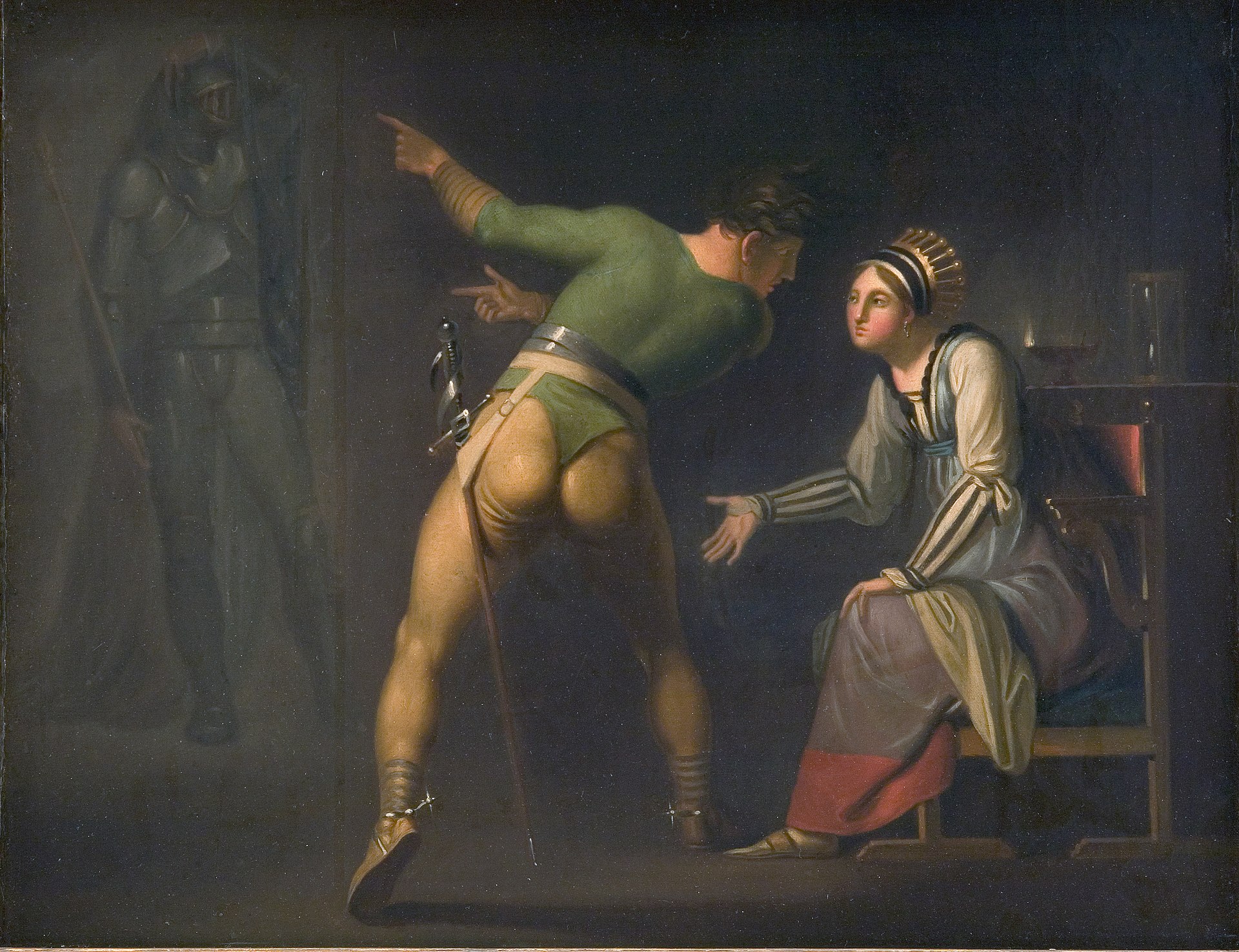
ハムレット
Hamlet

Hamlet tries to show his mother Gertrude his father's ghost (artist: Nicolai A. Abildgaard, c. 1778).
☆ハムレットHamlet(/ˈhæml↪Ll26At/)
は、ウィリアム・シェイクスピアによって1599年から1601年の間に書かれた悲劇である。シェイクスピア最長の戯曲である。デンマークを舞台に、ハム
レット王子と、ハムレットの父を殺して王位を奪いハムレットの母と結婚しようとした叔父クローディアスへの復讐の企てが描かれる。ハムレットは「英語にお
ける最も強力で影響力のある悲劇」のひとつとされ、そのストーリーは「無限に語り継がれ、翻案され続ける」[1]。各版には、他の版で欠落している台詞や
箇所が含まれている[3]。
シェイクスピアの戯曲は、古代ギリシャ悲劇からエリザベス朝演劇まで、多くの作品が出典として指摘されている。アーデン・シェイクスピアの編集者は、
「ソース・ハンティング」という考え方に疑問を呈しており、「ソース・ハンティング」とは、作者が常に他の作品からアイデアを得て自分の作品にすることを
前提とし、作者が独創的なアイデアを持つことも、オリジネーターであることもあり得ないと示唆していると指摘している。シェイクスピアが執筆した当時、父
親の仇を討つ息子の話や、敵を出し抜くために愚かなふりをする賢い仇討ちの息子の話はたくさんあった。シェイクスピアも知っていたと思われる古代ローマ人
のルキウス・ユニウス・ブルトゥスの話や、13世紀の年代記作家サクソ・グラマティコスが『ゲスタ・ダノルム』にラテン語で書き残し、1514年にパリで
印刷したアムレスの話もその中に含まれる。アムレスの物語はその後、16世紀の学者フランソワ・ド・ベルフォレストによって翻案され、1570年にフラン
ス語で出版された。この物語には、シェイクスピアの『ハムレット』と共通する多くのプロット要素や主要な登場人物があり、シェイクスピアに見られる他の要
素は欠けている。ベルフォレストの物語は『ハムレット』が書かれた後の1608年に初めて英語で出版されたが、シェイクスピアはフランス語版でこの物語に
出会っていた可能性がある[4]。
| The Tragedy of
Hamlet, Prince of Denmark, often shortened to Hamlet (/ˈhæmlɪt/), is a
tragedy written by William Shakespeare sometime between 1599 and 1601.
It is Shakespeare's longest play. Set in Denmark, the play depicts
Prince Hamlet and his attempts to exact revenge against his uncle,
Claudius, who has murdered Hamlet's father in order to seize his throne
and marry Hamlet's mother. Hamlet is considered among the "most
powerful and influential tragedies in the English language", with a
story capable of "seemingly endless retelling and adaptation by
others."[1] It is widely considered one of the greatest plays of all
time.[2] Three different early versions of the play are extant: the
First Quarto (Q1, 1603); the Second Quarto (Q2, 1604); and the First
Folio (F1, 1623). Each version includes lines and passages missing from
the others.[3] Many works have been pointed to as possible sources for Shakespeare's play, from ancient Greek tragedies to Elizabethan dramas. The editors of the Arden Shakespeare question the idea of "source hunting", pointing out that it presupposes that authors always require ideas from other works for their own, and suggests that no author can have an original idea or be an originator. When Shakespeare wrote, there were many stories about sons avenging the murder of their fathers, and many about clever avenging sons pretending to be foolish in order to outsmart their foes. This would include the story of the ancient Roman, Lucius Junius Brutus, which Shakespeare apparently knew, as well as the story of Amleth, which was preserved in Latin by 13th-century chronicler Saxo Grammaticus in his Gesta Danorum, and printed in Paris in 1514. The Amleth story was subsequently adapted and then published in French in 1570 by the 16th-century scholar François de Belleforest. It has a number of plot elements and major characters in common with Shakespeare's Hamlet, and lacks others that are found in Shakespeare. Belleforest's story was first published in English in 1608, after Hamlet had been written, though it is possible that Shakespeare had encountered it in the French-language version.[4] |
ハムレット(/ˈhæml↪Ll26At/)は、ウィリアム・シェイク
スピアによって1599年から1601年の間に書かれた悲劇である。シェイクスピア最長の戯曲である。デンマークを舞台に、ハムレット王子と、ハムレット
の父を殺して王位を奪いハムレットの母と結婚しようとした叔父クローディアスへの復讐の企てが描かれる。ハムレットは「英語における最も強力で影響力のあ
る悲劇」のひとつとされ、そのストーリーは「無限に語り継がれ、翻案され続ける」[1]。各版には、他の版で欠落している台詞や箇所が含まれている
[3]。 シェイクスピアの戯曲は、古代ギリシャ悲劇からエリザベス朝演劇まで、多くの作品が出典として指摘されている。アーデン・シェイクスピアの編集者は、 「ソース・ハンティング」という考え方に疑問を呈しており、「ソース・ハンティング」とは、作者が常に他の作品からアイデアを得て自分の作品にすることを 前提とし、作者が独創的なアイデアを持つことも、オリジネーターであることもあり得ないと示唆していると指摘している。シェイクスピアが執筆した当時、父 親の仇を討つ息子の話や、敵を出し抜くために愚かなふりをする賢い仇討ちの息子の話はたくさんあった。シェイクスピアも知っていたと思われる古代ローマ人 のルキウス・ユニウス・ブルトゥスの話や、13世紀の年代記作家サクソ・グラマティコスが『ゲスタ・ダノルム』にラテン語で書き残し、1514年にパリで 印刷したアムレスの話もその中に含まれる。アムレスの物語はその後、16世紀の学者フランソワ・ド・ベルフォレストによって翻案され、1570年にフラン ス語で出版された。この物語には、シェイクスピアの『ハムレット』と共通する多くのプロット要素や主要な登場人物があり、シェイクスピアに見られる他の要 素は欠けている。ベルフォレストの物語は『ハムレット』が書かれた後の1608年に初めて英語で出版されたが、シェイクスピアはフランス語版でこの物語に 出会っていた可能性がある[4]。 |
| Characters Main article: Characters in Hamlet Hamlet – son of the late king and nephew of the present king, Claudius Claudius – King of Denmark, Hamlet's uncle and brother to the former king Gertrude – Queen of Denmark and Hamlet's mother Polonius – chief counsellor to the king Ophelia – Polonius's daughter Horatio – friend of Hamlet Laertes – Polonius's son Voltemand and Cornelius – courtiers Rosencrantz and Guildenstern – courtiers, friends of Hamlet Osric – a courtier Marcellus – an officer Bernardo – an officer (spelled Barnardo or Barnard in quarto versions) Francisco – a soldier Reynaldo – Polonius's servant Ghost – the ghost of Hamlet's father, King Hamlet Fortinbras – prince of Norway Gravediggers – a pair of sextons Player King, Player Queen, Lucianus, etc. – players |
登場人物 主な記事 ハムレット』の登場人物 ハムレット - 故国王の息子であり、現国王クローディアスの甥である。 クローディアス - デンマーク王、ハムレットの叔父で前王の弟。 ガートルード - デンマーク王妃でハムレットの母 ポローニアス......王の参謀長 オフィーリア - ポローニアスの娘 ホレイショ - ハムレットの友人 ラールテス - ポローニアスの息子 ヴォルテマンドとコーネリアス - 廷臣 ローゼンクランツとギルデンスターン - 廷臣、ハムレットの友人 オスリック - 廷臣 マーセラス - 将校 Bernardo - 将校(四六版ではBarnardoまたはBarnardと表記される) フランシスコ - 兵士 レイナルド - ポローニアスの使用人 Ghost - ハムレットの父、ハムレット王の亡霊 Fortinbras - ノルウェーの王子 Gravediggers - 六人組の墓掘り人 王役、王妃役、ルシアヌス役など - プレイヤー |
Plot Kronborg Castle is immortalized as Elsinore in the play Hamlet Act I Prince Hamlet of Denmark is the son of the recently deceased King Hamlet, and nephew of King Claudius, his father's brother and successor. Claudius hastily married King Hamlet's widow, Gertrude, Hamlet's mother, and took the throne for himself. Denmark has a long-standing feud with neighbouring Norway, in which King Hamlet slew King Fortinbras of Norway in a battle some years ago. Although Denmark defeated Norway and the Norwegian throne fell to King Fortinbras's infirm brother, Denmark fears that an invasion led by the dead Norwegian king's son, Prince Fortinbras, is imminent. On a cold night on the ramparts of Elsinore, the Danish royal castle, the sentries Bernardo and Marcellus discuss a ghost resembling the late King Hamlet which they have recently seen, and bring Prince Hamlet's friend Horatio as a witness. After the ghost appears again, the three vow to tell Prince Hamlet what they have witnessed. The court gathers the next day, and King Claudius and Queen Gertrude discuss affairs of state with their elderly adviser Polonius. Claudius grants permission for Polonius's son Laertes to return to school in France, and he sends envoys to inform the King of Norway about Fortinbras. Claudius also questions Hamlet regarding his continuing to grieve for his father, and forbids him to return to his university in Wittenberg. After the court exits, Hamlet despairs of his father's death and his mother's hasty remarriage. Learning of the ghost from Horatio, Hamlet resolves to see it himself. 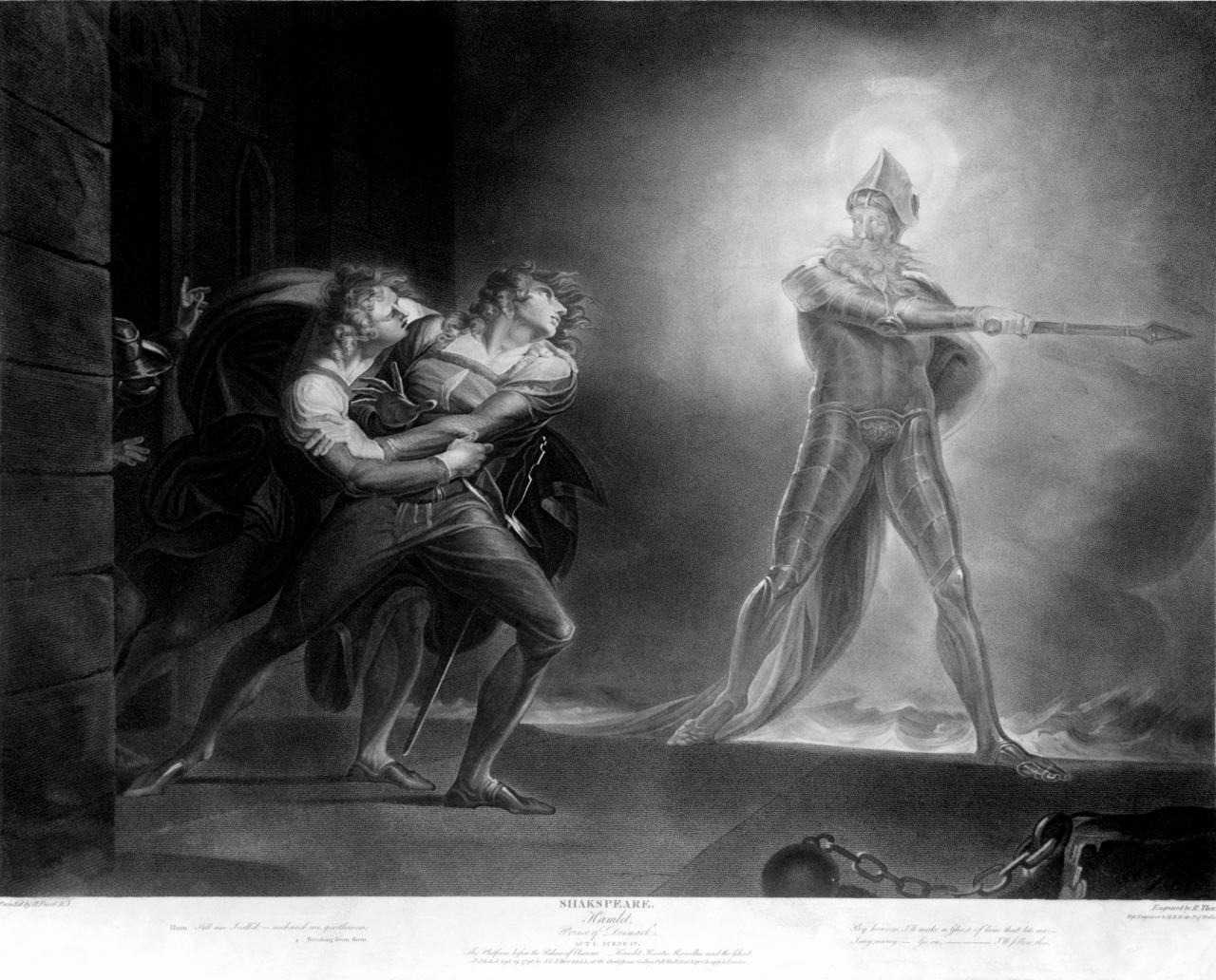 Horatio, Hamlet, and the ghost (Artist: Henry Fuseli, 1789)[5] As Polonius's son Laertes prepares to depart for France, Polonius offers him advice that culminates in the maxim "to thine own self be true."[6] Polonius's daughter, Ophelia, admits her interest in Hamlet, but Laertes warns her against seeking the prince's attention, and Polonius orders her to reject his advances. That night on the rampart, the ghost appears to Hamlet, tells the prince that he was murdered by Claudius (by pouring poison into his ear as he slept), and demands that Hamlet avenge the murder. Hamlet agrees, and the ghost vanishes. The prince confides to Horatio and the sentries that from now on he plans to "put an antic disposition on", or act as though he has gone mad. Hamlet forces them to swear to keep his plans for revenge secret; however, he remains uncertain of the ghost's reliability. |
プロット クロンボー城は、戯曲『ハムレット』の中でエルシノアとして不朽の名声を博している。 第1幕 デンマークの王子ハムレットは、亡くなったばかりのハムレット王の息子であり、父の弟で後継者のクローディアス王の甥である。クローディアスはハムレット 王の未亡人、ハムレットの母ガートルードと急遽結婚し、王位を奪った。デンマークは隣国ノルウェーと長年の確執があり、ハムレット王は数年前の戦いでノル ウェーのフォーティンブラス王を殺害している。デンマークはノルウェーに勝利し、ノルウェーの王位はフォーティンブラス王の病弱な弟に譲ったが、デンマー クは死んだノルウェー王の息子フォーティンブラス王子が率いる侵略が間近に迫っていることを恐れている。 寒い夜、デンマーク王城エルシノアの城壁で、見張りのベルナルドとマーセラスは、最近見た亡きハムレット王に似た幽霊について語り合い、ハムレット王子の 友人ホレイショを目撃者として連れてくる。幽霊が再び現れた後、3人は自分たちが目撃したことをハムレット王子に話すことを誓う。 翌日、宮廷が集まり、クローディアス王とガートルード王妃は、年老いた顧問ポローニアスと国政について話し合う。クローディアスは、ポローニアスの息子 ラールテスがフランスの学校に戻ることを許可し、フォーティンブラスについてノルウェー王に知らせる使者を送る。クローディアスはまた、ハムレットが父の 死を悲しみ続けていることを問い詰め、彼がヴィッテンベルクの大学に戻ることを禁じる。宮廷が去った後、ハムレットは父の死と母の早すぎる再婚に絶望す る。ホレイショから亡霊のことを聞いたハムレットは、自分も亡霊に会うことを決意する。  ホレイショ、ハムレット、幽霊(画家:ヘンリー・フューセリ、1789年)[5]。 ポローニアスの娘オフィーリアはハムレットに興味があることを認めるが、ラエルテスは王子の気を引こうとしないよう忠告し、ポローニアスは彼の誘いを断る よう命じる。その夜、城壁の上で亡霊がハムレットの前に現れ、自分がクローディアスに殺されたこと(寝ている彼の耳に毒を流し込まれたこと)を告げ、ハム レットに仇討ちを要求する。ハムレットは承諾し、幽霊は消える。王子はホレイショと衛兵たちに、これからは「気違いじみた性格になる」、つまり気が狂った かのように振る舞うつもりだと打ち明ける。ハムレットは彼らに、復讐の計画を秘密にしておくことを誓わせるが、幽霊の信頼性には不安が残る。 |
| Act II Ophelia rushes to her father, telling him that Hamlet arrived at her door the prior night half-undressed and behaving erratically. Polonius blames love for Hamlet's madness and resolves to inform Claudius and Gertrude. As he enters to do so, the king and queen are welcoming Rosencrantz and Guildenstern, two student acquaintances of Hamlet, to Elsinore. The royal couple has requested that the two students investigate the cause of Hamlet's mood and behaviour. Additional news requires that Polonius wait to be heard: messengers from Norway inform Claudius that the king of Norway has rebuked Prince Fortinbras for attempting to re-fight his father's battles. The forces that Fortinbras had conscripted to march against Denmark will instead be sent against Poland, though they will pass through Danish territory to get there. Polonius tells Claudius and Gertrude his theory regarding Hamlet's behaviour, and then speaks to Hamlet in a hall of the castle to try to learn more. Hamlet feigns madness and subtly insults Polonius all the while. When Rosencrantz and Guildenstern arrive, Hamlet greets his "friends" warmly but quickly discerns that they are there to spy on him for Claudius. Hamlet admits that he is upset at his situation but refuses to give the true reason, instead remarking "What a piece of work is a man". Rosencrantz and Guildenstern tell Hamlet that they have brought along a troupe of actors that they met while travelling to Elsinore. Hamlet, after welcoming the actors and dismissing his friends-turned-spies, asks them to deliver a soliloquy about the death of King Priam, as witnessed by Queen Hecuba, at the climax of the Trojan War. Hamlet then asks the actors to stage The Murder of Gonzago, a play featuring a death in the style of his father's murder. Hamlet intends to study Claudius's reaction to the play, and thereby determine the truth of the ghost's story of Claudius's guilt. |
第2幕 オフィーリアは父のもとを訪れ、ハムレットが前夜、半裸で玄関に現れ、挙動不審になったと告げる。ポローニアスはハムレットの狂気を愛のせいにし、クロー ディアスとガートルードに知らせる決意をする。王と王妃は、ハムレットの学生時代の知り合いであるローゼンクランツとギルデンスターンをエルシノアに迎え る。王夫妻は、二人の学生にハムレットの気分と行動の原因を調査するよう要請している。ノルウェーからの使者がクローディアスに、ノルウェー王が父の戦い に再挑戦しようとしたフォーティンブラス王子を叱責したと知らせる。フォーティンブラスがデンマークへの進軍のために徴兵した軍勢は、デンマーク領を通過 するものの、代わりにポーランドに送られることになる。 ポローニアスはクローディアスとガートルードにハムレットの行動に関する推理を話し、さらに詳しく知ろうと城の広間でハムレットに話しかける。ハムレット は狂気を装い、ポローニアスをさりげなく侮辱する。ローゼンクランツとギルデンスターンが到着すると、ハムレットは 「友人たち 」を温かく迎えるが、すぐに彼らがクローディアスのために自分を監視しに来たのだと見破る。ハムレットは自分の置かれた状況に動揺していることを認める が、本当の理由を言おうとせず、代わりに「人間とはなんという出来損ないだろう」と言う。ローゼンクランツとギルデンスターンはハムレットに、エルシノア への旅で知り合った役者一座を連れてきたことを告げる。ハムレットは俳優たちを歓迎し、友人からスパイになった者たちを追い出した後、彼らにトロイ戦争の クライマックスで王妃ヘクバが目撃したプリアモス王の死についての独り言を頼む。そしてハムレットは、俳優たちに『ゴンザーゴの死』を上演するよう依頼す る。ハムレットは、この芝居に対するクローディアスの反応を調べ、それによってクローディアスが罪を犯したという幽霊の話の真偽を見極めるつもりなのだ。 |
| Act III Polonius forces Ophelia to return Hamlet's love letters to the prince while he and Claudius secretly watch in order to evaluate Hamlet's reaction. Hamlet is walking alone in the hall as the King and Polonius await Ophelia's entrance. Hamlet muses on thoughts of life versus death. When Ophelia enters and tries to return Hamlet's things, Hamlet accuses her of immodesty and cries "get thee to a nunnery", though it is unclear whether this, too, is a show of madness or genuine distress. His reaction convinces Claudius that Hamlet is not mad for love. Shortly thereafter, the court assembles to watch the play Hamlet has commissioned. After seeing the Player King murdered by his rival pouring poison in his ear, Claudius abruptly rises and runs from the room; for Hamlet, this is proof of his uncle's guilt. 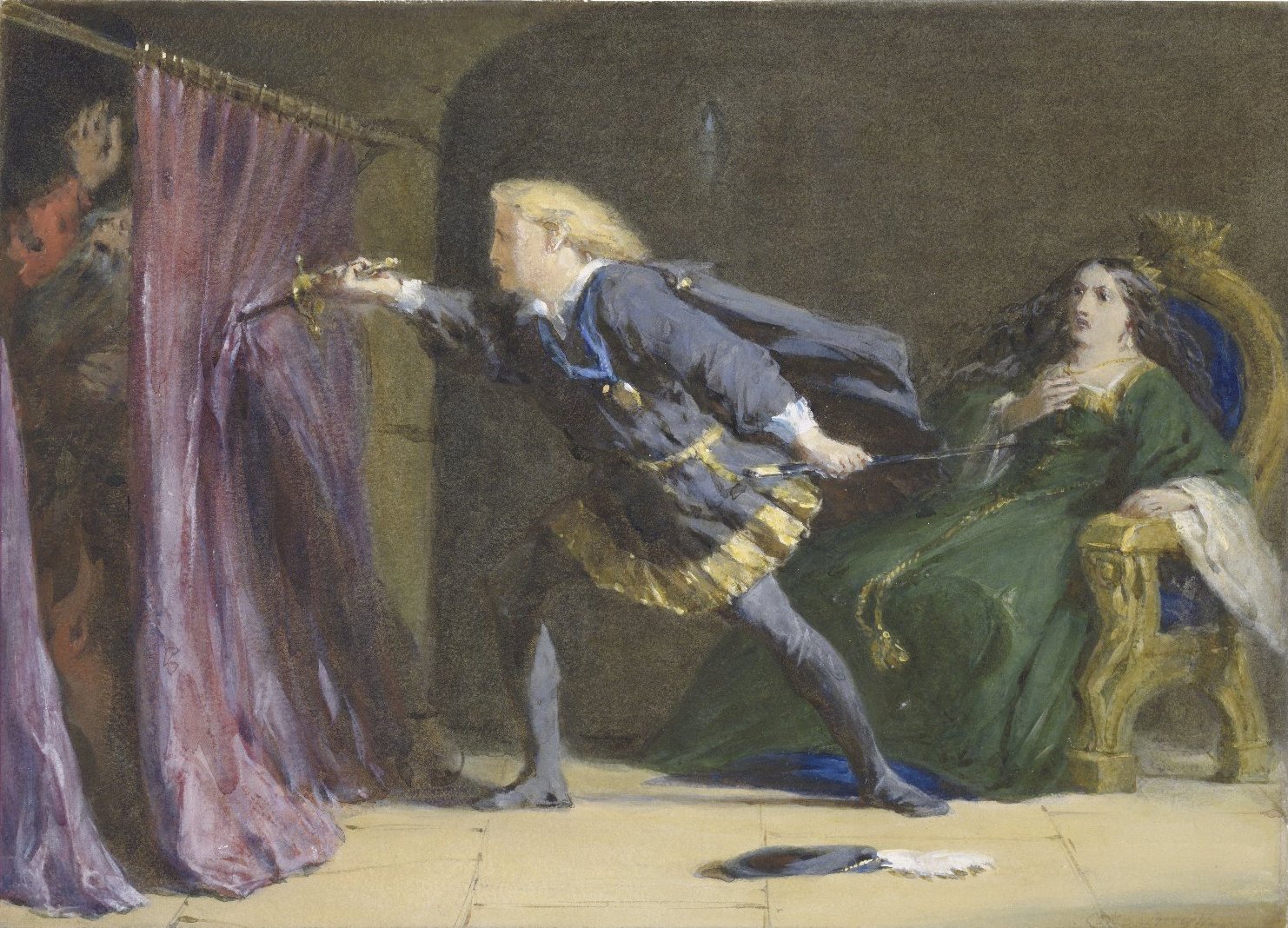 Hamlet mistakenly stabs Polonius (Artist: Coke Smyth, 19th century). Gertrude summons Hamlet to her chamber to demand an explanation. Meanwhile, Claudius talks to himself about the impossibility of repenting, since he still has possession of his ill-gotten goods: his brother's crown and wife. He sinks to his knees. Hamlet, on his way to visit his mother, sneaks up behind him but does not kill him, reasoning that killing Claudius while he is praying will send him straight to heaven while his father's ghost is stuck in purgatory. In the queen's bedchamber, Hamlet and Gertrude fight bitterly. Polonius, spying on the conversation from behind a tapestry, calls for help as Gertrude, believing Hamlet wants to kill her, calls out for help herself. Hamlet, believing it is Claudius, stabs wildly, killing Polonius, but he pulls aside the curtain and sees his mistake. In a rage, Hamlet brutally insults his mother for her apparent ignorance of Claudius's villainy, but the ghost enters and reprimands Hamlet for his inaction and harsh words. Unable to see or hear the ghost herself, Gertrude takes Hamlet's conversation with it as further evidence of madness. After begging the queen to stop sleeping with Claudius, Hamlet leaves, dragging Polonius's corpse away. |
第3幕 ポローニアスはオフィーリアにハムレットの恋文を王子に返させるが、その様子を自分とクローディアスが密かに見守り、ハムレットの反応をうかがっていた。 王とポローニアスがオフィーリアの入場を待つ中、ハムレットは広間を一人で歩いている。ハムレットは生と死について考える。オフィーリアが入ってきてハム レットのものを返そうとすると、ハムレットは彼女の不品行を非難し、「汝を尼僧院に」と叫ぶが、これも狂気の表れなのか、本物の苦悩なのかは不明である。 彼の反応を見て、クローディアスはハムレットが恋のために狂っているのではないと確信する。その直後、ハムレットが依頼した芝居を見るために宮廷が集ま る。ライバルが耳に毒を流し込んで王が殺されるのを見たクローディアスは、突然立ち上がり部屋から逃げ出す。  ハムレットは誤ってポローニアスを刺してしまう(画家:コーク・スミス、19世紀)。 ガートルードはハムレットを寝室に呼び、説明を求める。一方クローディアスは、兄の王位と妻という不正に得た財産をまだ手にしているため、悔い改めること は不可能だと独り言を言う。彼は膝をつく。ハムレットは母を訪ねる途中、彼の背後に忍び寄るが、彼が祈っている間にクローディアスを殺せば、父の亡霊が煉 獄に囚われている間に自分は天国に直行できると考え、彼を殺さなかった。王妃の寝室では、ハムレットとガートルードが激しく争う。ハムレットが自分を殺そ うとしていると思ったガートルードが自ら助けを求めると、タペストリーの陰から会話を覗いていたポローニアスが助けを求める。 ハムレットはクローディアスだと思い、乱暴に刺しポローニアスを殺すが、カーテンを引いて自分の間違いに気づく。怒りに駆られたハムレットは、クローディ アスの悪事を知らなかったと思われる母を残酷に侮辱するが、そこに亡霊が現れ、ハムレットの不作為と辛辣な言葉を叱責する。自分では幽霊を見ることも聞く こともできないガートルードは、ハムレットと幽霊との会話を、狂気のさらなる証拠と受け止める。王妃にクローディアスと寝るのをやめるよう懇願したハム レットは、ポローニアスの亡骸を引きずって立ち去る。 |
| Act IV Hamlet jokes with Claudius about where he has hidden Polonius's body, and the king, fearing for his life, sends Rosencrantz and Guildenstern to accompany Hamlet to England with a sealed letter to the English king requesting that Hamlet be executed immediately. Unhinged by grief at Polonius's death, Ophelia wanders Elsinore. Laertes arrives back from France, enraged by his father's death and his sister's madness. Claudius convinces Laertes that Hamlet is solely responsible, but a letter soon arrives indicating that Hamlet has returned to Denmark, foiling Claudius's plan. Claudius switches tactics, proposing a fencing match between Laertes and Hamlet to settle their differences. Laertes will be given a poison-tipped foil, and, if that fails, Claudius will offer Hamlet poisoned wine as a congratulation. Gertrude interrupts to report that Ophelia has drowned, though it is unclear whether it was suicide or an accident caused by her madness. |
第4幕 ハムレットはクローディアスとポローニアスの死体の隠し場所について冗談を言い合うが、王は身の危険を感じ、ローゼンクランツとギルデンスターンをハムレットに同行させ、ハムレットを即刻処刑するよう求める英国王宛ての封書を持たせて英国に向かわせる。 オフィーリアはポローニアスの死を悲しみ、エルシノアをさまよう。父親の死と妹の狂気に怒り狂ったラールテスがフランスから戻ってくる。クローディアス は、ハムレットだけの責任だとラールテスを説得するが、すぐにハムレットがデンマークに戻ったことを示す手紙が届き、クローディアスの計画は失敗に終わ る。クローディアスは戦術を変え、ラールテスとハムレットにフェンシングの試合を申し込む。ラールテスには先端に毒を塗った矛を持たせ、失敗した場合はク ローディアスがハムレットに毒入りのワインを贈って祝福する。ガートルードが割って入り、オフィーリアが溺死したことを報告するが、自殺か狂気による事故 かは不明だ。 |
Act V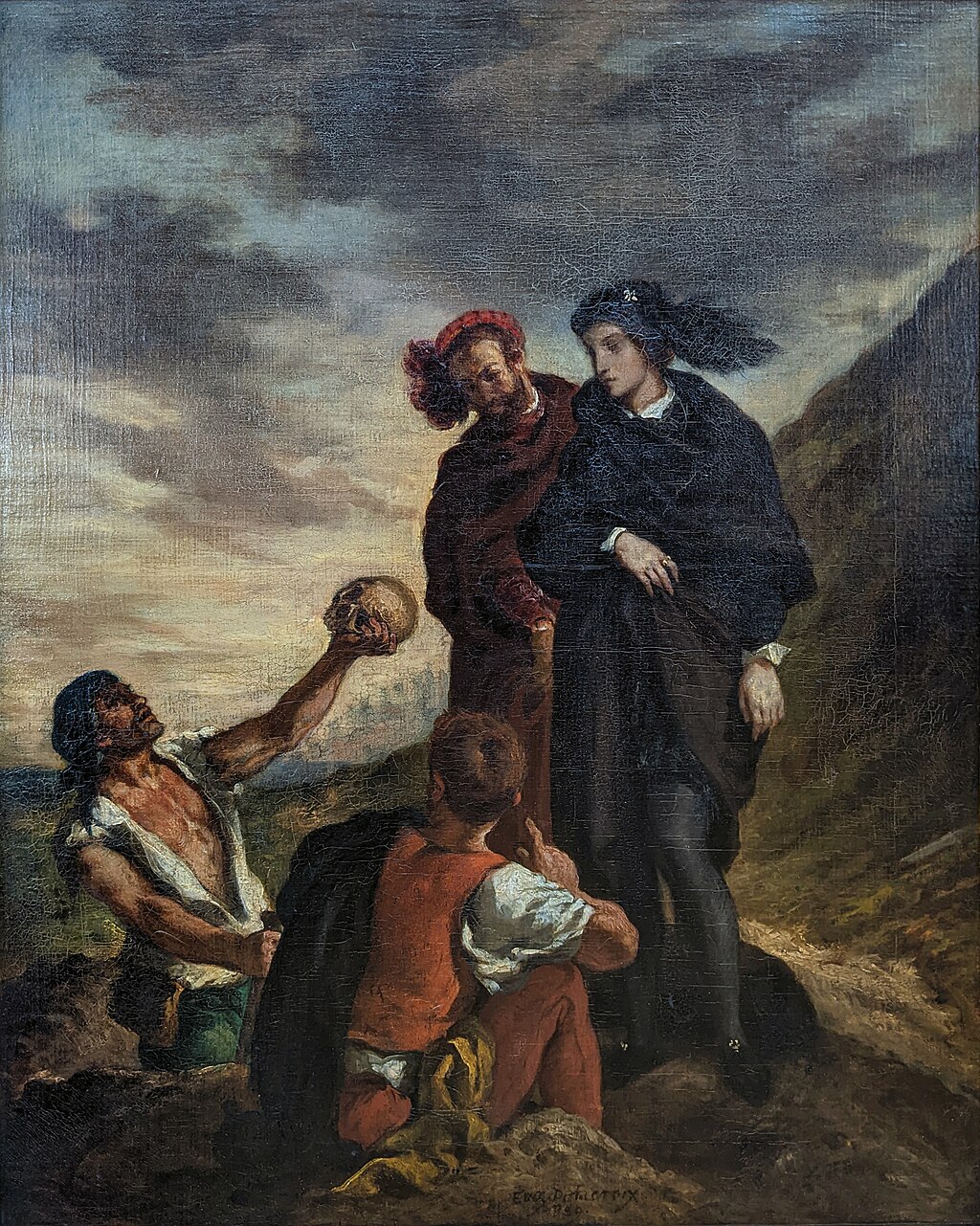 The gravedigger scene.[7] (Artist: Eugène Delacroix, 1839) Horatio has received a letter from Hamlet, explaining that the prince escaped by negotiating with pirates who attempted to attack his England-bound ship, and the friends reunite offstage. Two gravediggers discuss Ophelia's apparent suicide while digging her grave. Hamlet arrives with Horatio and banters with one of the gravediggers, who unearths the skull of a jester from Hamlet's childhood, Yorick. Hamlet picks up the skull, saying "Alas, poor Yorick" as he contemplates mortality. Ophelia's funeral procession approaches, led by Laertes. Hamlet and Horatio initially hide, but when Hamlet realizes that Ophelia is the one being buried, he reveals himself, proclaiming his love for her. Laertes and Hamlet fight by Ophelia's graveside, but the brawl is broken up. Back at Elsinore, Hamlet explains to Horatio that he had discovered Claudius's letter among Rosencrantz and Guildenstern's belongings and replaced it with a forged copy indicating that his former friends should be killed instead. A foppish courtier, Osric, interrupts the conversation to deliver the fencing challenge to Hamlet from Laertes. Hamlet, despite Horatio's pleas, accepts it. Hamlet does well at first, leading the match by two hits to none, and Gertrude raises a toast to him using the poisoned glass of wine Claudius had set aside for Hamlet. Claudius tries to stop her but is too late: she drinks, and Laertes realizes the plot will be revealed. Laertes slashes Hamlet with his poisoned blade. In the ensuing scuffle, they switch weapons, and Hamlet wounds Laertes with his own poisoned sword. Gertrude collapses and, claiming she has been poisoned, dies. In his dying moments, Laertes reconciles with Hamlet and reveals Claudius's plan. Hamlet rushes at Claudius and kills him. As the poison takes effect, Hamlet, hearing that Fortinbras is marching through the area, names the Norwegian prince as his successor. Horatio, distraught at the thought of being the last survivor and living whilst Hamlet does not, says he will commit suicide by drinking the dregs of Gertrude's poisoned wine, but Hamlet begs him to live on and tell his story. Hamlet dies in Horatio's arms, proclaiming "the rest is silence". Fortinbras, who was ostensibly marching towards Poland with his army, arrives at the palace, along with an English ambassador bringing news of Rosencrantz and Guildenstern's deaths. Horatio promises to recount the full story of what happened, and Fortinbras, seeing the entire Danish royal family dead, takes the crown for himself and orders a military funeral to honour Hamlet. |
第5幕 墓掘り人の場面[7](画家:ウジェーヌ・ドラクロワ、1839年) ホレイショはハムレットから手紙を受け取り、王子がイギリス行きの船を襲おうとした海賊と交渉して脱出したことを説明し、友人たちは舞台袖で再会する。二 人の墓掘り人がオフィーリアの墓を掘りながら、オフィーリアの自殺について話し合っている。ハムレットはホレイショと共に到着し、墓掘り人の一人と談笑す る。彼はハムレットの幼少時代の道化師ヨリックの頭蓋骨を発掘する。ハムレットはその頭蓋骨を拾い上げ、「哀れなヨリック」と言いながら死について考え る。レアテスを先頭にオフィーリアの葬列が近づいてくる。ハムレットとホレイショは最初隠れていたが、ハムレットはオフィーリアが葬られる側だとわかる と、正体を現し、彼女への愛を宣言する。ラールテスとハムレットはオフィーリアの墓前で争うが、乱闘は収まる。 エルシノアに戻ったハムレットは、ローゼンクランツとギルデンスターンの遺品の中からクローディアスの手紙を発見し、代わりにかつての友人を殺すよう示す 偽造の手紙に差し替えたことをホレイショに説明する。洒落た廷臣オスリックが会話に割って入り、レールテスからハムレットにフェンシングの挑戦状を渡す。 ハムレットはホレイショの懇願にもかかわらず、それを受け入れる。ハムレットはまずまずの成績を収め、試合は2勝1敗でリードする。ガートルードは、ク ローディアスがハムレットのために用意しておいた毒入りワインで乾杯する。クローディアスはハムレットを止めようとするが遅すぎた。ラールテスは毒刃でハ ムレットを切りつける。ハムレットは毒入りの剣でラールテスを傷つける。ガートルードは倒れ、毒を盛られたと言って息絶える。死の間際、ラールテスはハム レットと和解し、クローディアスの計画を明かす。ハムレットはクローディアスに突進し、彼を殺す。毒が効き始めると、ハムレットはフォーティンブラスがこ の地域を行進していると聞き、ノルウェーの王子を後継者に指名する。ホレイショは、自分が最後の生き残りであること、ハムレットが生きていない間に自分が 生きていることに心を痛め、ガートルードの毒入りのワインの残りを飲んで自殺すると言うが、ハムレットは生き延びて自分の話をするよう懇願する。ハムレッ トはホレイショの腕の中で「あとは沈黙だ」と宣言して死ぬ。表向きは軍を率いてポーランドに向かっていたフォーティンブラスが、ローゼンクランツとギルデ ンスターンの死の知らせを携えて英国大使とともに宮殿に到着する。ホレイショは事件の全貌を語ることを約束するが、フォーティンブラスはデンマーク王家の 一族が全員死んだのを見て、王冠を自分のものにし、ハムレットを讃えるための軍葬を命じる。 |
| Sources Main article: Sources of Hamlet 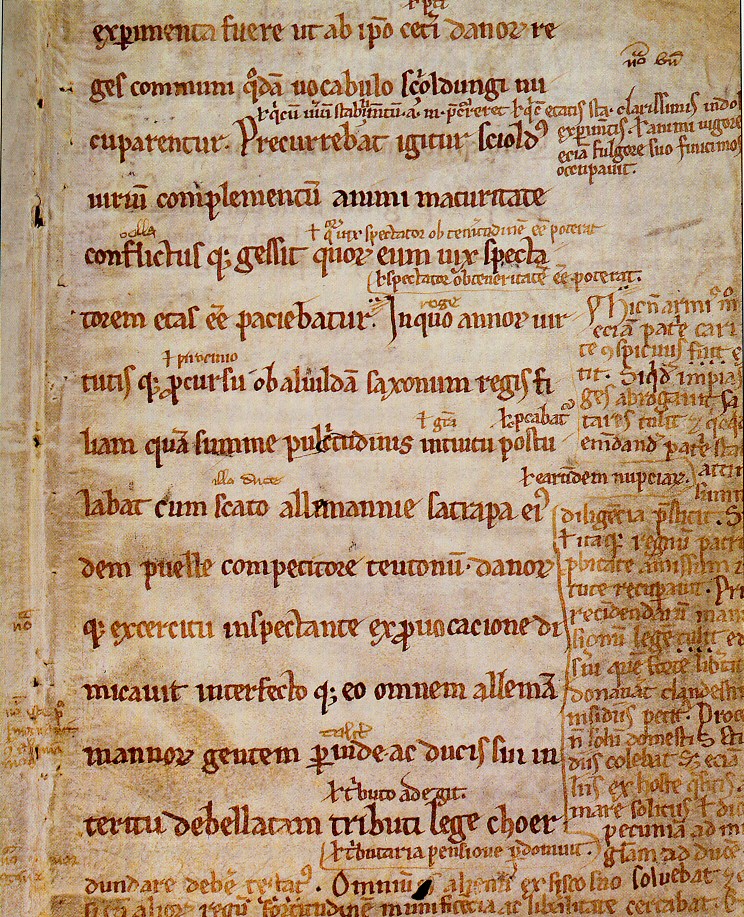 A facsimile of Gesta Danorum by Saxo Grammaticus, which contains the legend of Amleth Hamlet-like legends are so widely found (for example in Italy, Spain, Scandinavia, Byzantium, and Arabia) that the core "hero-as-fool" theme is possibly Indo-European in origin.[8] Several ancient written precursors to Hamlet can be identified. The first is the anonymous Scandinavian Saga of Hrolf Kraki. In this, the murdered king has two sons—Hroar and Helgi—who spend most of the story in disguise, under false names, rather than feigning madness, in a sequence of events that differs from Shakespeare's.[9] The second is the Roman legend of Brutus, recorded in two separate Latin works. Its hero, Lucius ("shining, light"), changes his name and persona to Brutus ("dull, stupid"), playing the role of a fool to avoid the fate of his father and brothers, and eventually slaying his family's killer, King Tarquinius. A 17th-century Nordic scholar, Torfaeus, compared the Icelandic hero Amlóði (Amlodi) and the hero Prince Ambales (from the Ambales Saga) to Shakespeare's Hamlet. Similarities include the prince's feigned madness, his accidental killing of the king's counsellor in his mother's bedroom, and the eventual slaying of his uncle.[10] Many of the earlier legendary elements are interwoven in the 13th-century "Life of Amleth" (Latin: Vita Amlethi) by Saxo Grammaticus, part of Gesta Danorum.[11] Written in Latin, it reflects classical Roman concepts of virtue and heroism, and was widely available in Shakespeare's day.[12] Significant parallels include the prince feigning madness, his mother's hasty marriage to the usurper, the prince killing a hidden spy, and the prince substituting the execution of two retainers for his own. A reasonably faithful version of Saxo's story was translated into French in 1570 by François de Belleforest, in his Histoires tragiques.[13] Belleforest embellished Saxo's text substantially, almost doubling its length, and introduced the hero's melancholy.[14] |
情報源 主な記事 ハムレットの出典  アムレト伝説を含むサクソ・グラマティコスによる『ゲスタ・ダノルム』の複製。 ハムレットに似た伝説は(イタリア、スペイン、スカンジナビア、ビザンチウム、アラビアなど)非常に広く見られるため、「愚か者としての英雄」というテー マの核心はインド・ヨーロッパ語起源である可能性がある[8]。ひとつは、スカンジナビアの無名の『Hrolf Krakiの武勇伝』(Saga of Hrolf Kraki)である。この物語では、殺された王には2人の息子-HroarとHelgi-がおり、彼らは物語の大半を、狂気を装うのではなく、偽名で変装 して過ごすという、シェイクスピアのものとは異なる一連の出来事が描かれている[9]。その主人公ルシウス(「輝く、光」)は、自分の名前と人格をブルー タス(「鈍い、愚かな」)に変え、父や兄弟の運命を避けるために愚か者の役を演じ、最終的には家族を殺したタルキニウス王を殺す。17世紀の北欧学者トル ファエウスは、アイスランドの英雄アムロジ(Amlóði)と英雄アンバレス王子(『アンバレス・サーガ』より)をシェイクスピアのハムレットになぞらえ た。類似点としては、王子が狂気を装っていること、母親の寝室で王の顧問官を誤って殺してしまうこと、最終的に叔父を殺害することなどが挙げられる [10]。 13世紀に書かれたサクソ・グラマティコスによる『アムレスの生涯』(ラテン語:Vita Amlethi)は、『ゲスタ・ダノーラム』(Gesta Danorum)の一部である[11]。ラテン語で書かれたこの作品は、美徳とヒロイズムに関する古典ローマの概念を反映しており、シェイクスピアの時代 には広く読まれていた。 [12] 重要な類似点としては、王子が狂気を装うこと、母親が簒奪者と急いで結婚すること、王子が隠れたスパイを殺すこと、王子が2人の家来の処刑を自分の処刑に 代えることなどが挙げられる。ベルフォレストはサクソのテキストを大幅に装飾し、長さをほぼ倍増させ、主人公の憂鬱を導入した[14]。 |
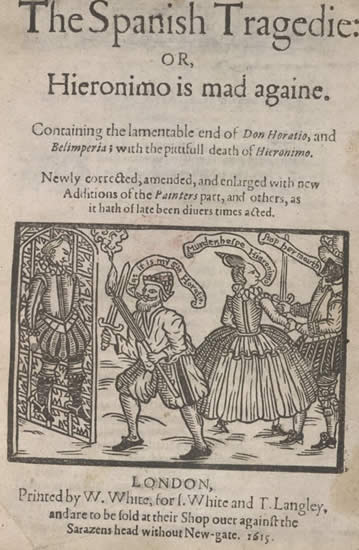 Title page of The Spanish Tragedy by Thomas Kyd According to one theory, Shakespeare's main source may be an earlier play—now lost—known today as the Ur-Hamlet. Possibly written by Thomas Kyd or by Shakespeare, the Ur-Hamlet would have existed by 1589, and would have incorporated a ghost.[15] Shakespeare's company, the Chamberlain's Men, may have purchased that play and performed a version for some time, which Shakespeare reworked.[16] However, no copy of the Ur-Hamlet has survived, and it is impossible to compare its language and style with the known works of any of its putative authors. In 1936 Andrew Cairncross suggested that, until more becomes known, it may be assumed that Shakespeare wrote the Ur-Hamlet.[17] Eric Sams lists reasons for supporting Shakespeare's authorship.[18] Harold Jenkins considers that there are no grounds for thinking that the Ur-Hamlet is an early work by Shakespeare, which he then rewrote.[19] Professor Terri Bourus in 2016, one of three general editors of the New Oxford Shakespeare,[20] in her paper "Enter Shakespeare's Young Hamlet, 1589" suggests that Shakespeare was "interested in sixteenth-century French literature, from the very beginning of his career" and therefore "did not need Thomas Kyd to pre-digest Belleforest's histoire of Amleth and spoon-feed it to him". She considers that the hypothesized Ur-Hamlet is Shakespeare's Q1 text, and that this derived directly from Belleforest's French version.[21] The precise combination of Shakespeare's use of the Ur-Hamlet, Belleforest, Saxo, or Kyd's The Spanish Tragedy as sources for Hamlet is not known. However, elements of Belleforest's version which are not in Saxo's story do appear in Shakespeare's play.[22] Most scholars reject the idea that Hamlet is in any way connected with Shakespeare's only son, Hamnet Shakespeare, who died in 1596 at age eleven. Conventional wisdom holds that Hamlet is strongly connected to legend, and the name Hamnet was quite popular at the time.[23] However, Stephen Greenblatt has argued that the coincidence of the names and Shakespeare's grief for the loss of his son may lie at the heart of the tragedy. He notes that the name of Hamnet Sadler, the Stratford neighbour after whom Hamnet was named, was often written as Hamlet Sadler and that, in the loose orthography of the time, the names were virtually interchangeable.[24][25] Scholars have often speculated that Hamlet's Polonius might have been inspired by William Cecil (Lord Burghley)—Lord High Treasurer and chief counsellor to Queen Elizabeth I. E. K. Chambers suggested Polonius's advice to Laertes may have echoed Burghley's to his son Robert Cecil.[26] John Dover Wilson thought it almost certain that the figure of Polonius caricatured Burghley.[27] A. L. Rowse speculated that Polonius's tedious verbosity might have resembled Burghley's.[28] Lilian Winstanley thought the name Corambis (in the First Quarto) did suggest Cecil and Burghley.[29] Harold Jenkins considers the idea of Polonius as a caricature of Burghley to be conjecture, perhaps based on the similar role they each played at court, and perhaps also based on the similarity between Burghley addressing his Ten Precepts to his son, and Polonius offering "precepts" to his son, Laertes.[30] Jenkins suggests that any personal satire may be found in the name "Polonius", which might point to a Polish or Polonian connection.[31] G. R. Hibbard hypothesised that differences in names (Corambis/Polonius:Montano/Raynoldo) between the First Quarto and other editions might reflect a desire not to offend scholars at Oxford University. (Robert Pullen, was the founder of Oxford University, and John Rainolds, was the President of Corpus Christi College.)[32] |
 トマス・カイド作『スペインの悲劇』のタイトルページ 一説によると、シェイクスピアの主な出典は、現在では失われてしまったが、『ウル=ハムレット』として知られる以前の戯曲かもしれない。シェイクスピアの 劇団「チェンバレンズ・メン」がこの戯曲を購入し、しばらくの間上演し、シェイクスピアはそれを手直ししたのかもしれない[16]。しかし、「ウル=ハム レット」のコピーは現存しておらず、その言語や文体を作者とされる人物の既知の作品と比較することは不可能である。1936年、アンドリュー・ケインクロ スは、より多くのことが判明するまでは、シェイクスピアが『ウル=ハムレット』を書いたと仮定してもよいと示唆した[17]。 エリック・サムズは、シェイクスピアの作者であることを支持する理由を挙げている[18]。ハロルド・ジェンキンスは、『ウル=ハムレット』がシェイクス ピアの初期の作品で、その後シェイクスピアが書き直したと考える根拠はないと考えている。 [19] New Oxford Shakespeareの3人の総編集者の一人である2016年のテリー・ブルース教授[20]は、論文「Enter Shakespeare's Young Hamlet, 1589」の中で、シェイクスピアは「キャリアのごく初期から、16世紀のフランス文学に興味を持っていた」ため、「トマス・カイドがベルフォーレの『ア ムレトの歴史』を事前に消化し、彼に匙を投げる必要はなかった」と示唆している。彼女は、仮説上の『ウル=ハムレット』はシェイクスピアのQ1テキストで あり、これはベルフォレストのフランス語版から直接派生したものだと考えている[21]。 シェイクスピアが『ハムレット』の典拠として『ウル=ハムレット』、ベルフォレスト、サクソ、カイドの『スペインの悲劇』を用いた正確な組み合わせはわかっていない。しかし、サクソの物語にはないベルフォレスト版の要素がシェイクスピアの戯曲には登場している[22]。 ほとんどの学者は、ハムレットがシェイクスピアの一人息子であり、1596年に11歳で亡くなったハムネット・シェイクスピアと何らかの関係があるという 考えを否定している。従来の常識では、ハムレットは伝説と強く結びついており、ハムネットという名前は当時かなり人気があった[23]。しかし、スティー ヴン・グリーンブラットは、名前の一致と息子を失ったシェイクスピアの悲しみが悲劇の核心にあるのではないかと主張している。彼は、ハムネットの名前の由 来となったストラットフォードの隣人ハムネット・サドラーの名前はしばしばハムレット・サドラーと書かれ、当時のゆるい正書法では、この2つの名前は事実 上交換可能であったと指摘している[24][25]。 学者たちはしばしば、ハムレットのポローニアスはウィリアム・セシル(バーグリー卿)、つまりエリザベス1世の大蔵卿兼最高顧問にインスパイアされたので はないかと推測してきた。 [26] ジョン・ドーヴァー・ウィルソンは、ポローニアスの姿がバーグリーを戯画化したものであることはほぼ間違いないと考えた[27] A. L. ロウスは、ポローニアスの退屈な冗舌さがバーグリーに似ているのではないかと推測した[28] 。 [29]ハロルド・ジェンキンズは、ポローニアスがバーグリーを戯画化したものであるという考えは憶測に過ぎないと考えているが、それはおそらく二人が宮 廷で演じた役割が似ていることに基づくものであり、またバーグリーが「十戒」を息子に宛てていることと、ポローニアスが息子のラーテスに「訓戒」を授けて いることが似ていることにも基づいている。 [30] ジェンキンズは、「ポローニアス」という名前に人格風刺が含まれている可能性を示唆しており、これはポーランド人またはポロニア人とのつながりを示してい るのかもしれない[31]。G.R.ヒバードは、第1版と他の版で名前(コランビス/ポローニアス:モンターノ/レイノルド)が異なるのは、オックス フォード大学の学者を怒らせたくないという願望を反映しているのかもしれないという仮説を立てた。(ロバート・プーレンはオックスフォード大学の創設者で あり、ジョン・レイノルドはコーパス・クリスティ・カレッジの学長であった)[32]。 |
Date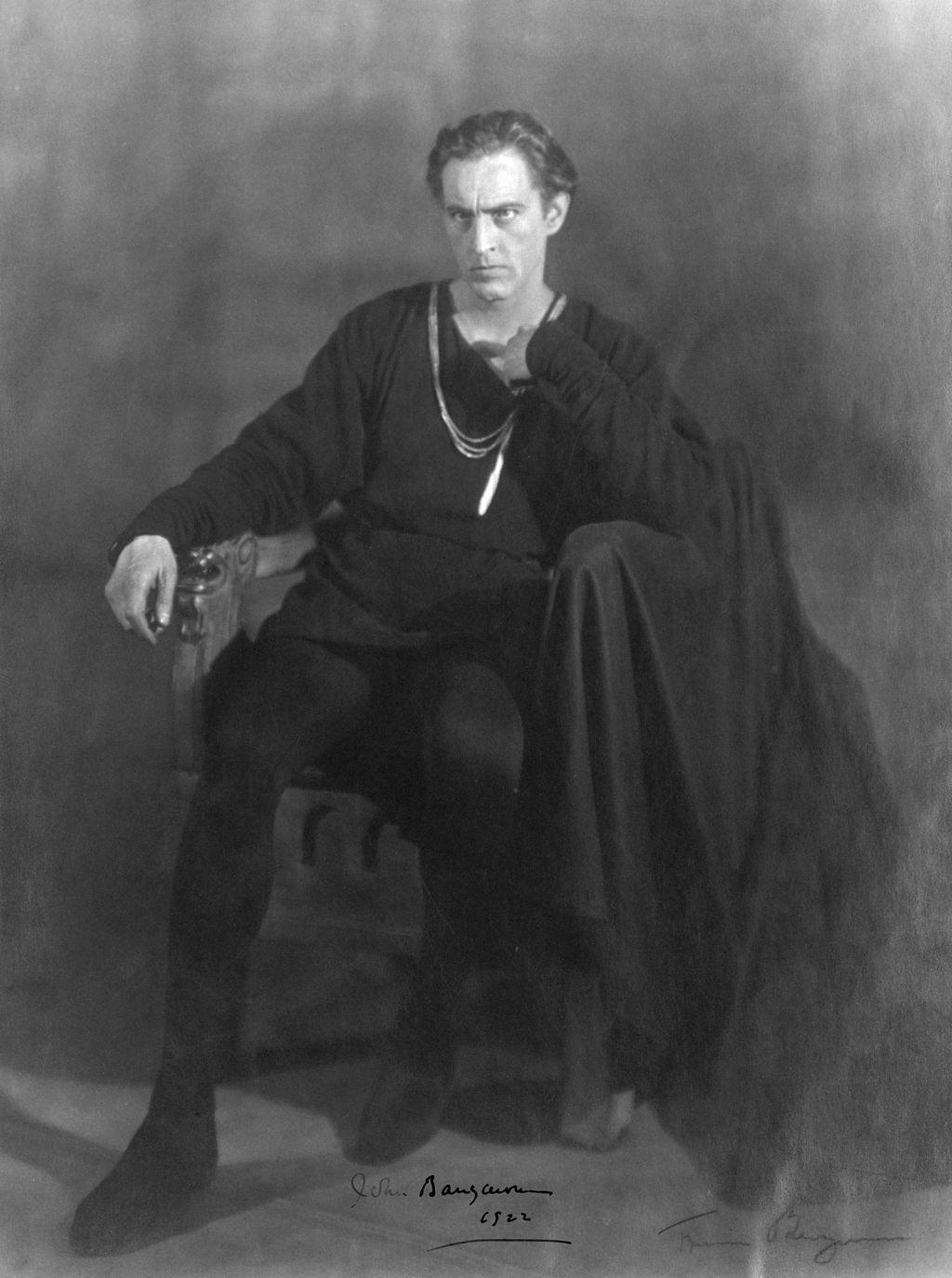 John Barrymore as Hamlet (1922) "Any dating of Hamlet must be tentative", states the New Cambridge editor, Phillip Edwards. MacCary suggests 1599 or 1600;[33] James Shapiro offers late 1600 or early 1601;[34] Wells and Taylor suggest that the play was written in 1600 and revised later;[35] the New Cambridge editor settles on mid-1601;[36] the New Swan Shakespeare Advanced Series editor agrees with 1601;[37] Thompson and Taylor, tentatively ("according to whether one is the more persuaded by Jenkins or by Honigmann") suggest a terminus ad quem of either Spring 1601 or sometime in 1600.[38] The earliest date estimate relies on Hamlet's frequent allusions to Shakespeare's Julius Caesar, itself dated to mid-1599.[39][40] The latest date estimate is based on an entry, of 26 July 1602, in the Register of the Stationers' Company, indicating that Hamlet was "latelie Acted by the Lo: Chamberleyne his servantes". In 1598, Francis Meres published his Palladis Tamia, a survey of English literature from Chaucer to its present day, within which twelve of Shakespeare's plays are named. Hamlet is not among them, suggesting that it had not yet been written. As Hamlet was very popular, Bernard Lott, the series editor of New Swan, believes it "unlikely that he [Meres] would have overlooked ... so significant a piece".[37] The phrase "little eyases"[41] in the First Folio (F1) may allude to the Children of the Chapel, whose popularity in London forced the Globe company into provincial touring.[42] This became known as the War of the Theatres, and supports a 1601 dating.[37] Katherine Duncan-Jones accepts a 1600–01 attribution for the date Hamlet was written, but notes that the Lord Chamberlain's Men, playing Hamlet in the 3000-capacity Globe, were unlikely to be put to any disadvantage by an audience of "barely one hundred" for the Children of the chapel's equivalent play, Antonio's Revenge; she believes that Shakespeare, confident in the superiority of his own work, was making a playful and charitable allusion to his friend John Marston's very similar piece.[43] A contemporary of Shakespeare's, Gabriel Harvey, wrote a marginal note in his copy of the 1598 edition of Chaucer's works, which some scholars use as dating evidence. Harvey's note says that "the wiser sort" enjoy Hamlet, and implies that the Earl of Essex—executed in February 1601 for rebellion—was still alive. Other scholars consider this inconclusive. Edwards, for example, concludes that the "sense of time is so confused in Harvey's note that it is really of little use in trying to date Hamlet". This is because the same note also refers to Spenser and Watson as if they were still alive ("our flourishing metricians"), but also mentions "Owen's new epigrams", published in 1607.[44] |
日付 ハムレット役ジョン・バリモア(1922年) ハムレット』の年代は暫定的なものでなければならない」とニュー・ケンブリッジの編集者フィリップ・エドワーズは述べている。MacCaryは1599年 か1600年、[33] James Shapiroは1600年後半か1601年前半、[34] WellsとTaylorは1600年に書かれ、その後改訂されたことを示唆、[35] New Cambridge editorは1601年半ば、[36] New Swan Shakespeare Advanced Series editorは1601年に同意、[37] ThompsonとTaylorは暫定的に(「JenkinsとHonigmannのどちらに説得されるかによって」)、1601年春か1600年のいつ か、という終着点を提案している。 [38] 最も早い時期の推定は、ハムレットがシェイクスピアの『ジュリアス・シーザー』を頻繁に引用していることに依拠している: Chamberleyne his servantes "とある。 1598年、フランシス・メレスは、チョーサーから現代までのイギリス文学を調査した『Palladis Tamia』を出版し、その中でシェイクスピアの戯曲12本の名前が挙げられている。ハムレットはその中に含まれておらず、まだ書かれていなかったことを 示唆している。ハムレット』は非常に人気があったため、『ニュー・スワン』のシリーズ・エディターであるバーナード・ロットは、「彼(メレス) が......これほど重要な作品を見落としたとは考えにくい」と考えている[37]。 ファースト・フォリオ(F1)の 「little eyases」[41]というフレーズは、ロンドンで人気を博したグローブ座を地方巡業に追いやった『チャペルの子供たち』[42]を暗示しているのかも しれない。 [37] キャサリン・ダンカン=ジョーンズは、『ハムレット』が書かれた時期について1600年から01年という推定を受け入れているが、3000人収容のグロー ブ座で『ハムレット』を演じる侍従長たちが、『礼拝堂の子供たち』に相当する『アントニオの復讐』の「かろうじて100人」の観客によって不利な立場に置 かれるとは考えにくいと指摘し、シェイクスピアは自身の作品の優位性に自信を持っており、友人ジョン・マーストンの非常によく似た作品に対して遊び心と慈 愛に満ちた暗示をかけたと考えている[43]。 シェイクスピアの同時代人であるガブリエル・ハーヴェイは、1598年版のチョーサー作品のコピーに余白を書き込んでおり、これを年代決定の証拠としてい る学者もいる。ハーヴェイの注によれば、「賢明な人々」はハムレットを楽しんでおり、1601年2月に謀反の罪で処刑されたエセックス伯爵がまだ生きてい たことを示唆している。他の学者たちは、これは決定的ではないと考えている。例えば、エドワーズは、「ハーヴェイのメモの時間感覚は非常に混乱しており、 ハムレットの年代を特定するにはほとんど役に立たない」と結論づけている。というのも、同じメモではスペンサーとワトソンがまだ生きているかのように言及 されており(「我々の繁栄する計量学者たち」)、1607年に出版された「オーウェンの新しいエピグラム」にも言及しているからである[44]。 |
| Texts Three early editions of the text, each different, have survived, making attempts to establish a single "authentic" text problematic.[45][46][47] First Quarto (Q1): In 1603 the booksellers Nicholas Ling and John Trundell published, and Valentine Simmes printed, the so-called "bad" first quarto, under the name The Tragicall Historie of Hamlet Prince of Denmarke. Q1 contains just over half of the text of the later second quarto. Second Quarto (Q2): In 1604 Nicholas Ling published, and James Roberts printed, the second quarto, under the same name as the first. Some copies are dated 1605, which may indicate a second impression; consequently, Q2 is often dated "1604/5". Q2 is the longest early edition, although it omits about 77 lines found in F1[48] (most likely to avoid offending James I's queen, Anne of Denmark).[49] First Folio (F1): In 1623 Edward Blount and William and Isaac Jaggard published The Tragedie of Hamlet, Prince of Denmarke in the First Folio, the first edition of Shakespeare's Complete Works.[50] This list does not include three additional early texts, John Smethwick's Q3, Q4, and Q5 (1611–37), which are regarded as reprints of Q2 with some alterations.[50] 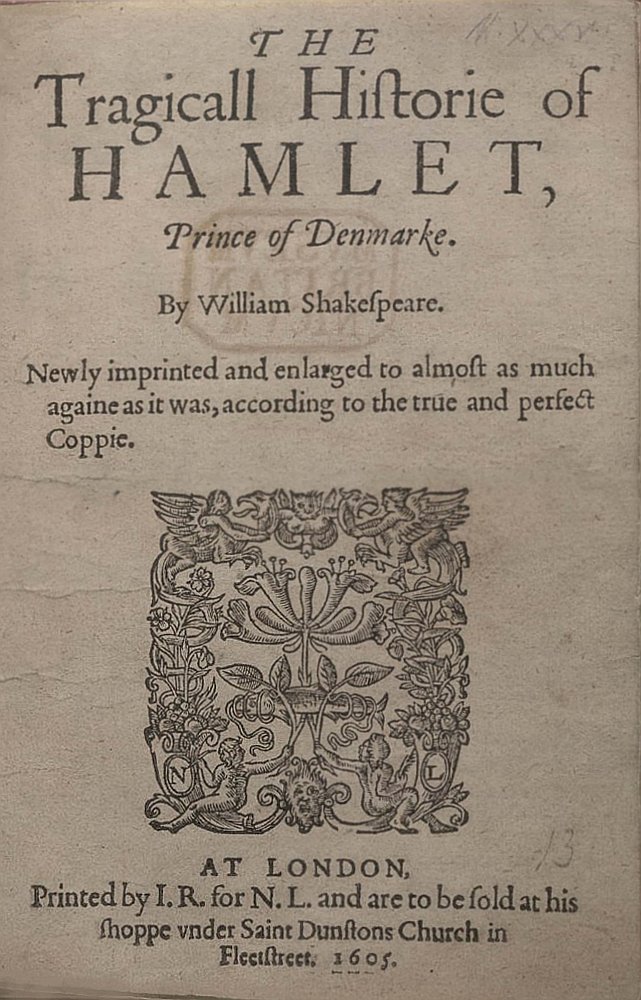 Title page of the 1605 printing (Q2) of Hamlet 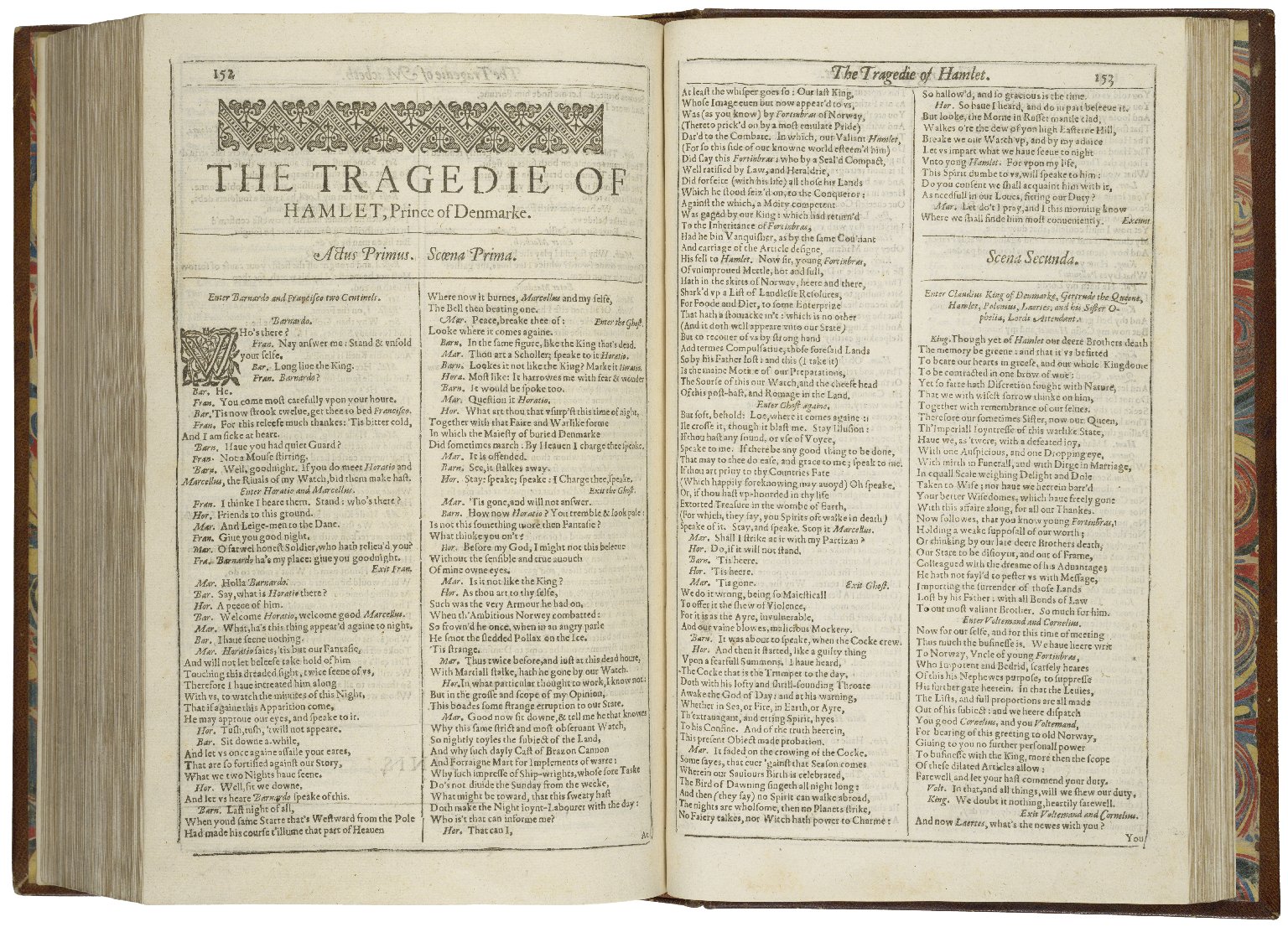 The first page of the First Folio printing of Hamlet, 1623 Early editors of Shakespeare's works, beginning with Nicholas Rowe (1709) and Lewis Theobald (1733), combined material from the two earliest sources of Hamlet available at the time, Q2 and F1. Each text contains material that the other lacks, with many minor differences in wording: scarcely 200 lines are identical in the two. Editors have combined them in an effort to create one "inclusive" text that reflects an imagined "ideal" of Shakespeare's original. Theobald's version became standard for a long time,[51] and his "full text" approach continues to influence editorial practice to the present day. Some contemporary scholarship, however, discounts this approach, instead considering "an authentic Hamlet an unrealisable ideal. ... there are texts of this play but no text".[52] The 2006 publication by Arden Shakespeare of different Hamlet texts in different volumes is perhaps evidence of this shifting focus and emphasis.[a] Other editors have continued to argue the need for well-edited editions taking material from all versions of the play. Colin Burrow has argued that most of us should read a text that is made up by conflating all three versions ... it's about as likely that Shakespeare wrote: "To be or not to be, ay, there's the point" [in Q1], as that he wrote the works of Francis Bacon. I suspect most people just won't want to read a three-text play ... [multi-text editions are] a version of the play that is out of touch with the needs of a wider public.[57] Traditionally, editors of Shakespeare's plays have divided them into five acts. None of the early texts of Hamlet, however, were arranged this way, and the play's division into acts and scenes derives from a 1676 quarto. Modern editors generally follow this traditional division but consider it unsatisfactory; for example, after Hamlet drags Polonius's body out of Gertrude's bedchamber, there is an act-break[58] after which the action appears to continue uninterrupted.[59] |
テキスト それぞれ異なる3つの初期版が現存しているため、単一の「真正」テキストを確立しようとする試みは問題になっている[45][46][47]。 第一版(Q1): 1603年、書店のニコラス・リングとジョン・トランデルが『The Tragicall Historie of Hamlet Prince of Denmarke(デンマークのハムレット王子の悲劇的な歴史)』という名で、いわゆる「悪い」第1四分冊を出版し、ヴァレンタイン・シムズが印刷した。 Q1には、後に出版される第2クォートのテキストの半分強が含まれている。 第二クオート(Q2): 1604年にニコラス・リングが出版し、ジェームズ・ロバーツが印刷した。一部の版には1605年という日付が入っているが、これは第2版であることを示 すもので、そのためQ2はしばしば 「1604/5 」と記されている。Q2は最も長い初期版であるが、F1に見られる約77行が省略されている[48](ジェームズ1世の王妃アン・オブ・デンマークの機嫌 を損ねないためと思われる)[49]。 ファースト・フォリオ(F1): 1623年、エドワード・ブラウントとウィリアム&アイザック・ジャガードはシェイクスピア全集の初版であるファースト・フォリオで『デンマークの王子ハムレットの悲劇』を出版した[50]。 このリストには、ジョン・スメスウィックのQ3、Q4、Q5(1611-37)という3つの初期のテキストは含まれていない。  ハムレット』1605年版(Q2)のタイトルページ  ハムレット』ファースト・フォリオの最初のページ(1623年 ニコラス・ロウ(Nicholas Rowe, 1709)とルイス・セオバルト(Lewis Theobald, 1733)に始まるシェイクスピア作品の初期の編集者たちは、当時入手可能であった『ハムレット』の2つの最も古い資料、Q2とF1の資料を組み合わせ た。それぞれのテキストには、もう一方のテキストに欠けている素材が含まれており、表現には多くの細かな差異がある。編集者たちは、シェイクスピアの原作 の「理想」を反映した「包括的」なテキストを作ろうとして、両者を組み合わせた。テオバードのバージョンは長い間標準となり[51]、彼の「全文」アプ ローチは現在に至るまで編集実務に影響を与え続けている。しかし、現代の学者の中にはこのアプローチを否定し、「本物のハムレットは実現不可能な理想であ る」と考える者もいる。2006年にアーデン・シェイクスピア社から出版された『ハムレット』の異なるテクストを異なる巻数で出版したことは、おそらくこ の焦点と重点の移行の証拠であろう[a]。他の編集者は、戯曲のすべての版から素材を取り入れた、よく編集された版の必要性を主張し続けている。コリン・ バローは次のように主張している。 シェイクスピアは、フランシス・ベーコンの著作を書いたのと同じように、「To be or not to be, ay, there's the point」 [Q1]を書いた可能性が高い。ほとんどの人は、3つのテキストからなる戯曲を読みたくはないだろう......。[複数テクスト版は)より広い大衆の ニーズとはかけ離れた戯曲の版である」[57]。 伝統的に、シェイクスピア戯曲の編集者は戯曲を5幕に分けている。しかし、『ハムレット』の初期のテキストはどれもこのような配置にはなっておらず、この 戯曲の幕と場面の分割は1676年の四分冊に由来する。例えば、ハムレットがガートルードの寝室からポローニアスの死体を引きずり出した後、幕切れ [58]があり、その後、行動は途切れることなく続いているように見える[59]。 |
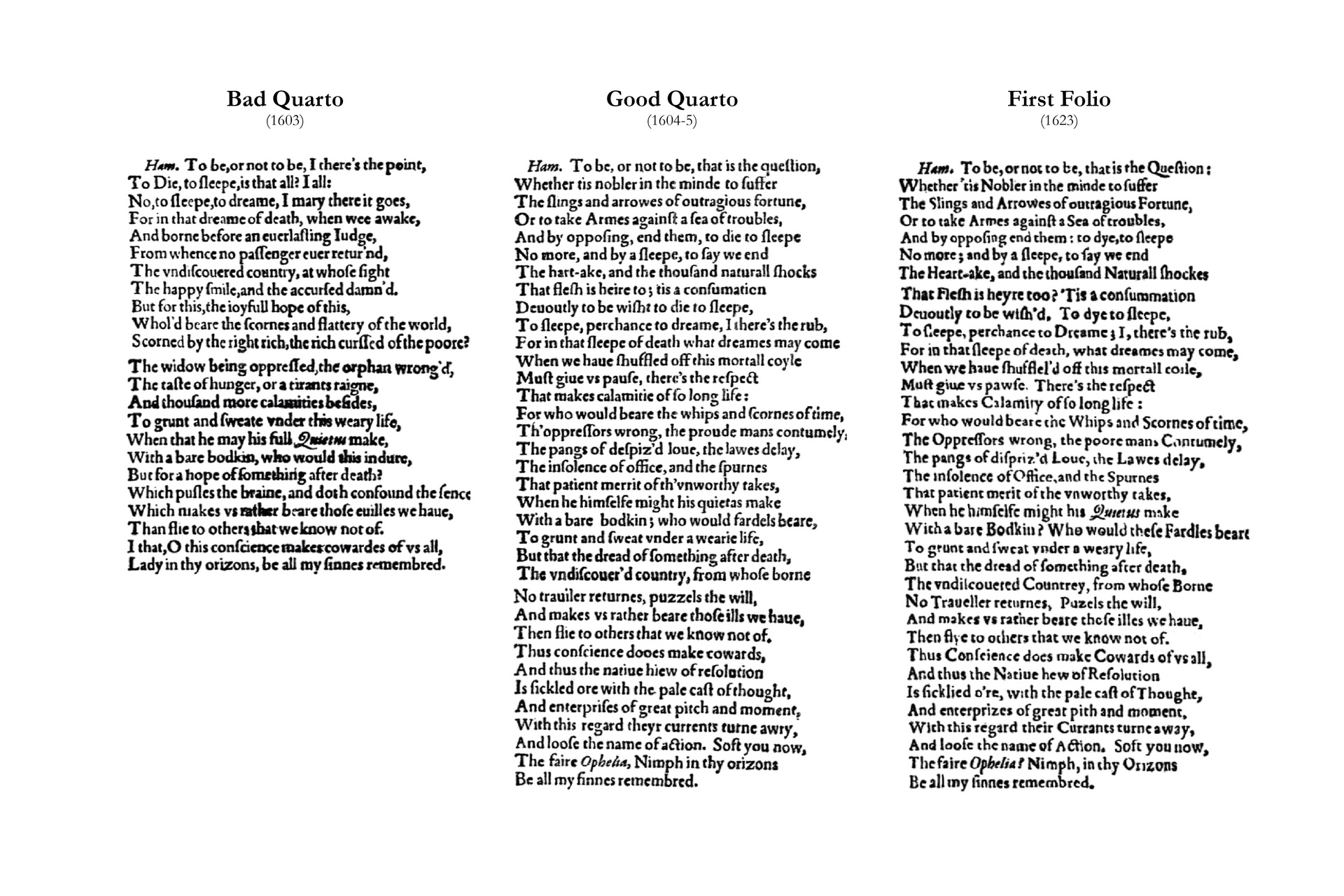 Comparison of the 'To be, or not to be' soliloquy in the first three editions of Hamlet, showing the varying quality of the text in the Bad Quarto, the Good Quarto and the First Folio Q1 was discovered in 1823. Only two copies are extant. According to Jenkins, "The unauthorized nature of this quarto is matched by the corruption of its text."[60] Yet Q1 has value: it contains stage directions (such as Ophelia entering with a lute and her hair down) that reveal actual stage practices in a way that Q2 and F1 do not; it contains an entire scene (usually labelled 4.6)[61] that does not appear in either Q2 or F1; and it is useful for comparison with the later editions. The major deficiency of Q1 is in the language: particularly noticeable in the opening lines of the famous "To be, or not to be" soliloquy: "To be, or not to be, aye there's the point. / To die, to sleep, is that all? Aye all: / No, to sleep, to dream, aye marry there it goes." However, the scene order is more coherent, without the problems of Q2 and F1 of Hamlet seeming to resolve something in one scene and enter the next drowning in indecision. New Cambridge editor Kathleen Irace has noted that "Q1's more linear plot design is certainly easier [...] to follow [...] but the simplicity of the Q1 plot arrangement eliminates the alternating plot elements that correspond to Hamlet's shifts in mood."[62] Q1 is considerably shorter than Q2 or F1 and may be a memorial reconstruction of the play as Shakespeare's company performed it, by an actor who played a minor role (most likely Marcellus).[63] Scholars disagree whether the reconstruction was pirated or authorised. It is suggested by Irace that Q1 is an abridged version intended especially for travelling productions, thus the question of length may be considered as separate from issues of poor textual quality.[56][64] Editing Q1 thus poses problems in whether or not to "correct" differences from Q2 and F. Irace, in her introduction to Q1, wrote that "I have avoided as many other alterations as possible, because the differences...are especially intriguing...I have recorded a selection of Q2/F readings in the collation." The idea that Q1 is not riddled with error but is instead eminently fit for the stage has led to at least 28 different Q1 productions since 1881.[65] Other productions have used the Q2 and Folio texts, but used Q1's running order, in particular moving the to be or not to be soliloquy earlier.[66] Developing this, some editors such as Jonathan Bate have argued that Q2 may represent "a 'reading' text as opposed to a 'performance' one" of Hamlet: an edition containing all of Shakespeare's material for the play for the pleasure of readers, so not representing the play as it would have been staged.[67][68] |
 ハムレット』の最初の3つの版における「To be, or not to be」の独り言(モノローグ)の比較。Bad Quarto、Good Quarto、First Folioにおけるテキストの質の違いを示している。 Q1は1823年に発見された。現存するのは2部のみである。ジェンキンスによれば、「このクオートの非公認性は、そのテキストの腐敗と一致している」 [60]。しかし、Q1には価値がある。Q2やF1にはない、実際の舞台のやり方を明らかにする舞台演出(オフィーリアがリュートを持って髪を下ろして登 場するなど)が含まれていること、Q2にもF1にも登場しない場面全体(通常は4.6とラベル付けされている)[61]が含まれていること、後期の版との 比較に有用であることなどが挙げられる。Q1の主な欠点は言葉遣いにあり、特に有名な独り言 「To be, or not to be 」の冒頭で顕著である: 「あるべきか、ないべきか、そこがポイントだ。/ 死ぬこと、眠ること、それだけか?そうだ、すべてだ: / いや、眠ること、夢見ること、そうだ、結婚しよう。」 しかし、シーンの順序はより首尾一貫しており、ハムレットがあるシーンで何かを解決し、優柔不断に溺れて次のシーンに入るように見えるQ2やF1の問題は ない。新ケンブリッジ編集者のキャスリーン・アイレイスは、「Q1のプロット設計がより直線的であることは確かに[...]追いやすい[...]が、Q1 のプロット配置が単純であるため、ハムレットの気分の変化に対応するプロット要素の交替が消去法によって排除されている」と指摘している[62]。 Q1はQ2やF1よりもかなり短く、シェイクスピアの劇団が上演した際に、脇役(おそらくマーセラス)を演じた俳優によって再現された記念碑的な作品であ る可能性がある[63]。したがって、Q1の編集は、Q2やFとの相違を「修正」するかどうかという問題を提起している[56][64]。イレイスはQ1 の序文で、「相違が...特に興味をそそるので...他の改変はできるだけ避けた...照合にはQ2/Fの読みを選んで記録した 」と書いている。Q1は誤りに満ちているわけではなく、むしろ舞台に非常に適しているという考えから、1881年以降、少なくとも28の異なるQ1が上演 された[65]。他の上演ではQ2とフォリオのテキストが使用されたが、Q1の上演順序が使用され、個別主義では特にto be or not to beの独り言が前に移動された。 [66]これを発展させ、ジョナサン・ベイトのような一部の編集者は、Q2は『ハムレット』の「『上演』とは対照的な『読書』テキスト」、つまり読者の楽 しみのためにシェイクスピアの戯曲のための素材をすべて収録した版であり、上演されたであろう戯曲を表しているのではないと主張している[67] [68]。 |
| Analysis and criticism Main article: Critical approaches to Hamlet Critical history From the early 17th century, the play was famous for its ghost and vivid dramatisation of melancholy and insanity, leading to a procession of mad courtiers and ladies in Jacobean and Caroline drama.[69][70] Though it remained popular with mass audiences, late 17th-century Restoration critics saw Hamlet as primitive and disapproved of its lack of unity and decorum.[71][72] This view changed drastically in the 18th century, when critics regarded Hamlet as a hero—a pure, brilliant young man thrust into unfortunate circumstances.[73] By the mid-18th century, however, the advent of Gothic literature brought psychological and mystical readings, returning madness and the ghost to the forefront.[74] Not until the late 18th century did critics and performers begin to view Hamlet as confusing and inconsistent. Before then, he was either mad, or not; either a hero, or not; with no in-betweens.[75] These developments represented a fundamental change in literary criticism, which came to focus more on character and less on plot.[76] In the 18th century, one negative French review of Hamlet would be widely discussed for centuries, in particular in publications throughout the 19th and 20th century.[77][78][79][80][81][82][83] In 1768, Voltaire wrote a negative review of Hamlet, stating that "it is vulgar and barbarous drama, which would not be tolerated by the vilest populace of France or Italy... one would imagine this piece to be a work of a drunken savage",[84] while acknowledging that it contains "some sublime strokes worthy of the greatest genius".[85] By the 19th century, Romantic critics valued Hamlet for its internal, individual conflict reflecting the strong contemporary emphasis on internal struggles and inner character in general.[86] Then too, critics started to focus on Hamlet's delay as a character trait, rather than a plot device.[76] This focus on character and internal struggle continued into the 20th century, when criticism branched in several directions, discussed in context and interpretation below. |
分析と批判 主な記事 ハムレットへの批評的アプローチ 批評の歴史 17世紀初頭から、この戯曲は憂鬱と狂気を亡霊のように鮮やかに劇化したことで有名であり、ジャコビアン劇やカロライン劇では狂気の廷臣や貴婦人の行列が 描かれた。 [69][70]大衆の間では人気を保っていたものの、17世紀末の王政復古期の批評家たちはハムレットを原始的なものとみなし、その統一性と礼儀の欠如 を不承認とした[71][72]。この見方は18世紀になると大きく変わり、批評家たちはハムレットを不運な境遇に突き落とされた純粋で優秀な若者である 英雄とみなした[73]。 しかし、18世紀半ばになると、ゴシック文学の登場によって心理学的、神秘学的な解釈がもたらされ、狂気と幽霊が再び前面に押し出されるようになった [74]。それ以前は、ハムレットは狂気であるか、そうでないか、英雄であるか、そうでないか、その中間はなかった[75]。このような動きは文芸批評の 根本的な変化を意味し、文芸批評は人物像を重視し、筋書きを重視しなくなった[76]。 [1768年、ヴォルテールは『ハムレット』の否定的な批評を書き、「下品で野蛮な劇であり、フランスやイタリアの最も下劣な民衆には容認されないだろ う...この作品は酔っぱらった野蛮人の作品だと想像するだろう」と述べる一方で[84]、「最も偉大な天才にふさわしい崇高なストローク」が含まれてい ることは認めている[85]。 19世紀になると、ロマン派の批評家たちは『ハムレット』の内面的な葛藤を評価するようになり、内面的な葛藤や内面的な性格が一般的に重視されるようになった現代を反映している[86]。 |
| Dramatic structure Modern editors have divided the play into five acts, and each act into scenes. The First Folio marks the first two acts only. The quartos do not have such divisions. The division into five acts follows Seneca, who in his plays, regularized the way ancient Greek tragedies contain five episodes, which are separated by four choral odes. In Hamlet the development of the plot or the action are determined by the unfolding of Hamlet's character. The soliloquies do not interrupt the plot, instead they are highlights of each block of action. The plot is the developing revelation of Hamlet's view of what is "rotten in the state of Denmark." The action of the play is driven forward in dialogue; but in the soliloquies time and action stop, the meaning of action is questioned, fog of illusion is broached, and truths are exposed. The contrast between appearance and reality is a significant theme. Hamlet is presented with an image, and then interprets its deeper or darker meaning. Examples begin with Hamlet questioning the reality of the ghost. It continues with Hamlet's taking on an "antic disposition" in order to appear mad, though he is not. The contrast (appearance and reality) is also expressed in several "spying scenes": Act two begins with Polonius sending Reynaldo to spy on his son, Laertes. Claudius and Polonius spy on Ophelia as she meets with Hamlet. In act two, Claudius asks Rosencrantz and Guildenstern to spy on Hamlet. Similarly, the play-within-a-play is used by Hamlet to reveal his step-father's hidden nature. There is no subplot, but the play presents the affairs of the courtier Polonius, his daughter, Ophelia, and his son, Laertes—who variously deal with madness, love and the death of a father in ways that contrast with Hamlet's. The graveyard scene eases tension prior to the catastrophe, and, as Hamlet holds the skull, it is shown that Hamlet no longer fears damnation in the afterlife, and accepts that there is a "divinity that shapes our ends".[87] Hamlet's enquiring mind has been open to all kinds of ideas, but in act five he has decided on a plan, and in a dialogue with Horatio he seems to answer his two earlier soliloquies on suicide: "We defy augury. There is special providence in the fall of a sparrow. If it be now, 'tis not to come; if it be not to come, it will be now; if it be not now, yet it will come. The readiness is all. Since no man, of aught he leaves, knows aught, what is't to leave betimes."[88][89] |
ドラマの構造 現代の編集者は、この戯曲を5つの幕に分け、それぞれの幕を場面に分けている。ファースト・フォリオでは、最初の2幕のみが記されている。クワルトにはそ のような区分はない。5幕に分けるのはセネカに倣ったもので、セネカは戯曲の中で、古代ギリシア悲劇が5つのエピソードを持ち、それが4つのコラール・ オードで区切られるのを規則化した。ハムレット』では、プロットやアクションの展開はハムレットの性格の展開によって決定される。独り言は筋書きを中断す るものではなく、それぞれのアクションのハイライトである。筋書きとは、ハムレットが考える 「デンマークの腐った部分 」が明らかになることである。劇の行動は対話の中で進められるが、独り言の中では時間と行動が止まり、行動の意味が問われ、幻想の霧が打ち破られ、真実が 暴かれる。 外見と現実の対比は重要なテーマである。ハムレットはイメージを提示され、その深い意味や暗い意味を解釈する。その例は、ハムレットが幽霊の実在を疑うと ころから始まる。ハムレットが狂っていないにもかかわらず、狂っているように見せかけるために 「破天荒な気質 」を取ることに続く。この対比(外見と現実)は、いくつかの「スパイシーン」でも表現されている: 第2幕は、ポローニアスが息子のレールテスをスパイするためにレイナルドを送り込むところから始まる。クローディアスとポローニアスは、ハムレットと会う オフィーリアをスパイする。第2幕では、クローディアスがローゼンクランツとギルデンスターンにハムレットのスパイを依頼する。同様に、劇中劇はハムレッ トが義父の隠された本性を暴くために使われる。 サブプロットはないが、劇中では廷臣ポローニアス、その娘オフィーリア、息子レアテスが、ハムレットとは対照的な方法で狂気、愛、父の死とさまざまに向き 合う。墓場の場面は大惨事の前の緊張を和らげ、ハムレットが頭蓋骨を手にすることで、ハムレットがもはや死後の世界での天罰を恐れず、「私たちの終わりを 形作る神性」の存在を受け入れていることが示される[87]。 ハムレットの探究心はあらゆるアイデアに開かれていたが、第5幕で彼は計画を決定し、ホレイショとの対話の中で、自殺に関する先の2つの独り言に答えてい るように見える: 「予言には逆らえない。雀の落下には特別な摂理がある。今でなければ来ない。今でなければ来る。覚悟がすべてだ。人は何一つ残すものがないのだから、何時 何を残すべきか、何も知らないのである」[88][89]。 |
| Length The First Quarto (1603) text of Hamlet contains 15,983 words, the Second Quarto (1604) contains 28,628 words, and the First Folio (1623) contains 27,602 words. Counting the number of lines varies between editions, partly because prose sections in the play may be formatted with varied lengths.[90] Editions of Hamlet that are created by conflating the texts of the Second Quarto and the Folio are said to have approximately 3,900 lines;[91] the number of lines varies between those editions based on formatting the prose sections, counting methods, and how the editors have joined the texts together.[92] Hamlet is by far the longest play that Shakespeare wrote, and one of the longest plays in the Western canon. It might require more than four hours to stage;[93] a typical Elizabethan play would need two to three hours.[94] It is speculated that because of the considerable length of Q2 and F1, there was an expectation that those texts would be abridged for performance, or that Q2 and F1 may have been aimed at a reading audience.[95] That Q1 is so much shorter than Q2 has spurred speculation that Q1 is an early draft, or perhaps an adaptation, a bootleg copy, or a stage adaptation. On the title page of Q2, its text is described as "newly imprinted and enlarged to almost as much again as it was." That is probably a comparison to Q1.[90] |
長さ ハムレット』の第1版(1603年)は15,983語、第2版(1604年)は28,628語、第1フォリオ(1623年)は27,602語である。行数 の数え方は版によって異なるが、これは劇中の散文部分の長さがまちまちなためである。 [ハムレット』はシェイクスピアが書いた戯曲の中で圧倒的に長く、西洋の正典の中でも最も長い戯曲の一つである。典型的なエリザベス朝時代の戯曲は2~3 時間を必要とする[93]。Q2とF1がかなり長いため、これらのテキストは上演のために要約されることが期待されていた、あるいはQ2とF1は朗読の聴 衆を対象としていたのではないかと推測されている[95]。 Q1がQ2よりも非常に短いことは、Q1が初期の草稿である、あるいはおそらく翻案、海賊版、舞台化であるとの憶測を呼んでいる。Q2のタイトル・ページ には、そのテキストが 「新たに打刻され、ほぼ元通りに拡大された 」と記述されている。これはおそらくQ1との比較であろう[90]。 |
Language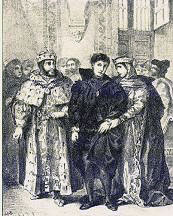 Hamlet's statement that his dark clothes are the outer sign of his inner grief demonstrates strong rhetorical skill (artist: Eugène Delacroix 1834). Much of Hamlet's language is courtly: elaborate, witty discourse, as recommended by Baldassare Castiglione's 1528 etiquette guide, The Courtier. This work specifically advises royal retainers to amuse their masters with inventive language. Osric and Polonius, especially, seem to respect this injunction. Claudius's speech is rich with rhetorical figures—as is Hamlet's and, at times, Ophelia's—while the language of Horatio, the guards, and the gravediggers is simpler. Claudius's high status is reinforced by using the royal first person plural ("we" or "us"), and anaphora mixed with metaphor to resonate with Greek political speeches.[96] Of all the characters, Hamlet has the greatest rhetorical skill. He uses highly developed metaphors, stichomythia, and in nine memorable words deploys both anaphora and asyndeton: "to die: to sleep— / To sleep, perchance to dream".[97] In contrast, when occasion demands, he is precise and straightforward, as when he explains his inward emotion to his mother: "But I have that within which passes show, / These but the trappings and the suits of woe".[98] At times, he relies heavily on puns to express his true thoughts while simultaneously concealing them.[99] Pauline Kiernan argues that Shakespeare changed English drama forever in Hamlet because he "showed how a character's language can often be saying several things at once, and contradictory meanings at that, to reflect fragmented thoughts and disturbed feelings". She gives the example of Hamlet's advice to Ophelia, "get thee to a nunnery",[100] which, she claims, is simultaneously a reference to a place of chastity and a slang term for a brothel, reflecting Hamlet's confused feelings about female sexuality.[101] However Harold Jenkins does not agree, having studied the few examples that are used to support that idea, and finds that there is no support for the assumption that "nunnery" was used that way in slang, or that Hamlet intended such a meaning. The context of the scene suggests that a nunnery would not be a brothel, but instead a place of renunciation and a "sanctuary from marriage and from the world's contamination".[102] Thompson and Taylor consider the brothel idea incorrect considering that "Hamlet is trying to deter Ophelia from breeding".[103] Hamlet's first words in the play are a pun; when Claudius addresses him as "my cousin Hamlet, and my son", Hamlet says as an aside: "A little more than kin, and less than kind."[104] An unusual rhetorical device, hendiadys, appears in several places in the play. Examples are found in Ophelia's speech at the end of the nunnery scene: "Th'expectancy and rose of the fair state"[105] and "And I, of ladies most deject and wretched".[106] Many scholars have found it odd that Shakespeare would, seemingly arbitrarily, use this rhetorical form throughout the play. One explanation may be that Hamlet was written later in Shakespeare's life, when he was adept at matching rhetorical devices to characters and the plot. Linguist George T. Wright suggests that hendiadys had been used deliberately to heighten the play's sense of duality and dislocation.[107] Hamlet's soliloquies have captured the attention of scholars. Hamlet interrupts himself, vocalising either disgust or agreement with himself and embellishing his own words. He has difficulty expressing himself directly and instead blunts the thrust of his thought with wordplay. It is not until late in the play, after his experience with the pirates, that Hamlet is able to articulate his feelings freely.[108] |
言語 ハムレットが、黒い服は内なる悲しみの外面的な表れであると述べているのは、強い修辞的技巧を示している(画家:ウジェーヌ・ドラクロワ 1834年)。 ハムレットの言葉の多くは、バルダッサーレ・カスティリオーネが1528年に出版した礼儀作法書『廷臣』(The Courtier)が推奨するような、手の込んだ機知に富んだ言説である。この作品では特に、王室の家来たちに独創的な言葉で主人を楽しませるよう勧めて いる。特にオスリックとポローニアスは、この命令を尊重しているようだ。クローディアスの演説は、ハムレットや時にはオフィーリアの演説のように修辞的な 表現が豊富である。クローディアスの地位の高さは、王族の一人称複数形(「我々 」または 「我々」)を使うことで強化され、ギリシャの政治演説と共鳴するように隠喩とアナフォラが混ざっている[96]。 すべての登場人物の中で、ハムレットは最も優れた修辞的技巧を持っている。彼は高度に発達した隠喩、スティコミティアを使い、記憶に残る9つの言葉ではア ナフォラとアシンデトンの両方を展開している: 「死ぬこと:眠ること-/眠ること、ひょっとしたら夢を見ること」[97]。これとは対照的に、母親に対して自分の内なる感情を説明するときのように、い ざというときには正確で率直である: ポーリン・キアナンは、シェイクスピアは『ハムレット』において、「登場人物の言葉が、断片的な思考や乱れた感情を反映するために、しばしば一度に複数の こと、それも矛盾した意味を口にすることがあることを示した」ため、イギリス演劇を永遠に変えたと論じている[99]。彼女は、ハムレットがオフィーリア に「尼僧院に行け」と忠告する例[100]を挙げ、これは同時に貞節の場所への言及であると同時に売春宿の俗語であり、女性の性についてのハムレットの混 乱した感情を反映していると主張する[101]。 しかし、ハロルド・ジェンキンズは、その考えを支持するために使用される数少ない例を研究した結果、同意しておらず、「尼僧院」が俗語でそのように使用さ れていた、あるいはハムレットがそのような意味を意図していたという仮定には何の裏付けもないと見なしている。トンプソンとテイラーは、「ハムレットはオ フィーリアの繁殖を抑止しようとしている」[103]ことを考慮すると、売春宿という考えは正しくないと考えている。 ハムレットの劇中最初の言葉はダジャレであり、クローディアスが彼を「いとこのハムレット、そして息子」と呼ぶと、ハムレットは余談としてこう言う。 珍しい修辞法であるヘンジアディスは、劇中に何箇所か登場する。その例は、尼僧院の場面の最後のオフィーリアの台詞に見られる: 「多くの研究者は、シェイクスピアが戯曲全体を通して、一見恣意的にこの修辞形式を使うことを奇妙に思ってきた。一つの説明は、『ハムレット』がシェイク スピアの人生の後半に書かれ、登場人物や筋書きに修辞的な仕掛けを合わせることに長けていた時期だったからかもしれない。言語学者のジョージ・T・ライト は、ヘンジアディスは戯曲の二重性と転位の感覚を高めるために意図的に使われたと示唆している[107]。 ハムレットの独り言は学者たちの注目を集めてきた。ハムレットは自分の言葉を遮り、自分自身への嫌悪や同意を口にし、自分の言葉を装飾する。ハムレットは 自分自身を直接表現することが難しく、その代わりに言葉遊びで自分の考えの核心を鈍らせる。ハムレットが自分の感情を自由に表現できるようになるのは、劇 の後半、海賊との体験の後である[108]。 |
| Context and interpretation Religious 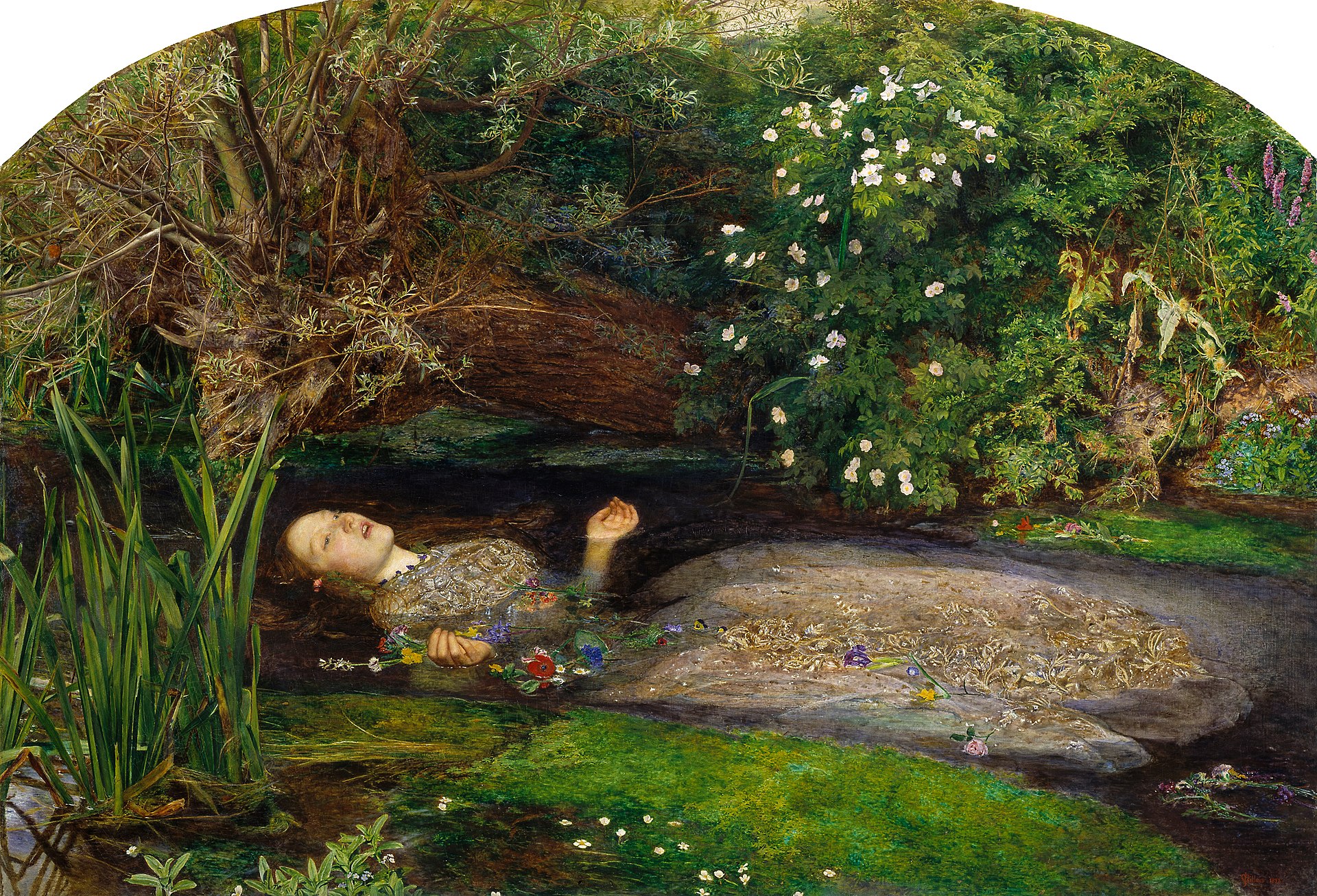 John Everett Millais' Ophelia (1852) depicts Lady Ophelia's mysterious death by drowning. In the play, the gravediggers discuss whether Ophelia's death was a suicide and whether she merits a Christian burial. Written at a time of religious upheaval and in the wake of the English Reformation, the play is alternately Catholic (or piously medieval) and Protestant (or consciously modern). The ghost describes himself as being in purgatory and as dying without last rites. This and Ophelia's burial ceremony, which is characteristically Catholic, make up most of the play's Catholic connections. Some scholars have observed that revenge tragedies come from Catholic countries such as Italy and Spain, where the revenge tragedies present contradictions of motives, since according to Catholic doctrine the duty to God and family precedes civil justice.[109] Much of the play's Protestant tones derive from its setting in Denmark—both then and now a predominantly Protestant country,[b] though it is unclear whether the fictional Denmark of the play is intended to portray this implicit fact. Dialogue refers explicitly to the German city of Wittenberg where Hamlet, Horatio, and Rosencrantz and Guildenstern attend university, implying where the Protestant reformer Martin Luther nailed the Ninety-five Theses to the church door in 1517.[110] |
文脈と解釈 宗教  ジョン・エヴァレット・ミレイの『オフィーリア』(1852年)は、オフィーリア夫人の謎めいた溺死を描いている。劇中、墓掘り人たちはオフィーリアの死が自殺であったかどうか、キリスト教式埋葬に値するかどうかを議論する。 宗教が激動し、イギリス宗教改革の後に書かれたこの戯曲は、カトリック(あるいは敬虔な中世)とプロテスタント(あるいは意識的な近代)が交互に描かれて いる。幽霊は自分自身を煉獄にいると表現し、最後の儀式を受けずに死ぬと表現する。これとオフィーリアの埋葬儀式が特徴的なカトリックであり、この劇のカ トリック的なつながりのほとんどを占めている。ある学者は、復讐悲劇はイタリアやスペインなどのカトリックの国から来たものであり、カトリックの教義によ れば、神や家族に対する義務が民事上の正義に優先するため、復讐悲劇は動機の矛盾を提示するものであると観察している[109]。 この劇のプロテスタント的色調の多くは、当時も現在もプロテスタントが多数を占めるデンマークを舞台にしていることに由来するが[b]、劇中の架空のデン マークがこの暗黙の事実を描くことを意図しているかどうかは不明である。対話では、ハムレット、ホレイショ、ローゼンクランツとギルデンスターンが大学に 通うドイツの都市ヴィッテンベルクについて明確に言及しており、プロテスタントの改革者マルティン・ルターが1517年に教会の扉に「九十五ヶ条の論題」 を釘で打ち付けた場所を暗示している[110]。 |
Philosophical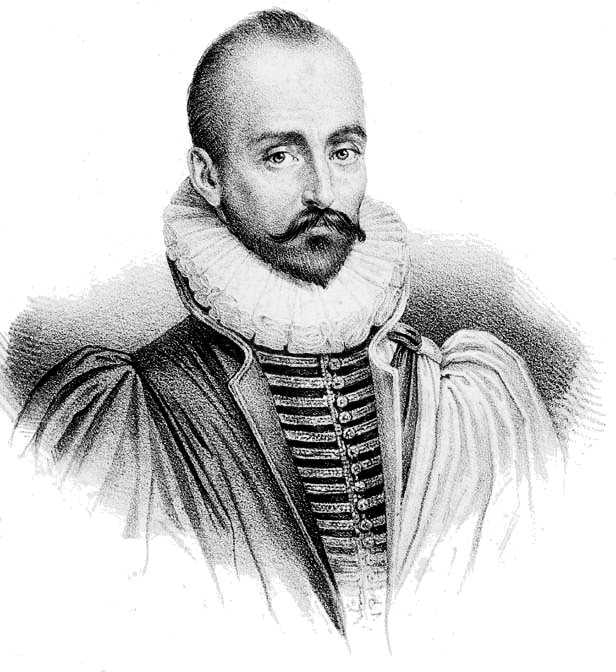 Philosophical ideas in Hamlet are similar to those of the French writer Michel de Montaigne, a contemporary of Shakespeare's (artist: Thomas de Leu, fl. 1560–1612). Hamlet is often perceived as a philosophical character, expounding ideas that are now described as relativist, existentialist, and sceptical. For example, he expresses a subjectivistic idea when he says to Rosencrantz: "there is nothing either good or bad, but thinking makes it so".[111] The idea that nothing is real except in the mind of the individual finds its roots in the Greek Sophists, who argued that since nothing can be perceived except through the senses—and since all individuals sense, and therefore perceive things differently—there is no absolute truth, but rather only relative truth.[112] The clearest alleged instance of existentialism is in the "to be, or not to be"[113] speech, where Hamlet is thought by some to use "being" to allude to life and action, and "not being" to death and inaction. Hamlet reflects the contemporary scepticism promoted by the French Renaissance humanist Michel de Montaigne.[114] Prior to Montaigne's time, humanists such as Pico della Mirandola had argued that man was God's greatest creation, made in God's image and able to choose his own nature, but this view was subsequently challenged in Montaigne's Essais of 1580. Hamlet's "What a piece of work is a man" seems to echo many of Montaigne's ideas, and many scholars have discussed whether Shakespeare drew directly from Montaigne or whether both men were simply reacting similarly to the spirit of the times.[115][116][114] |
哲学的 ハムレット』に登場する哲学的思想は、シェイクスピアと同時代のフランスの作家ミシェル・ド・モンテーニュ(画家:トマ・ド・レウ、1560-1612年頃)の思想に似ている。 ハムレットはしばしば哲学的な人物として認識され、現在では相対主義的、実存主義的、懐疑的と評される思想を述べている。例えば、彼はローゼンクランツに 「良いことも悪いこともない。 [ハムレットは「あること」を生と行動を、「ないこと」を死と無為を暗示していると考える人もいる。 ハムレットは、フランス・ルネサンス期の人文主義者ミシェル・ド・モンテーニュが推進した現代の懐疑主義を反映している[114]。モンテーニュの時代以 前には、ピコ・デッラ・ミランドラのような人文主義者が、人間は神の最も偉大な被造物であり、神に似せて造られ、自らの本性を選択することができると主張 していたが、この見解はその後、1580年のモンテーニュのエッセで否定された。ハムレットの「人間とはなんという作品であろうか」という言葉は、モン テーニュの考え方の多くを反映しているように思われ、多くの学者がシェイクスピアがモンテーニュから直接引用したのか、それとも両者が単に時代の精神に同 じように反応しただけなのかを論じている[115][116][114]。 |
Psychoanalytic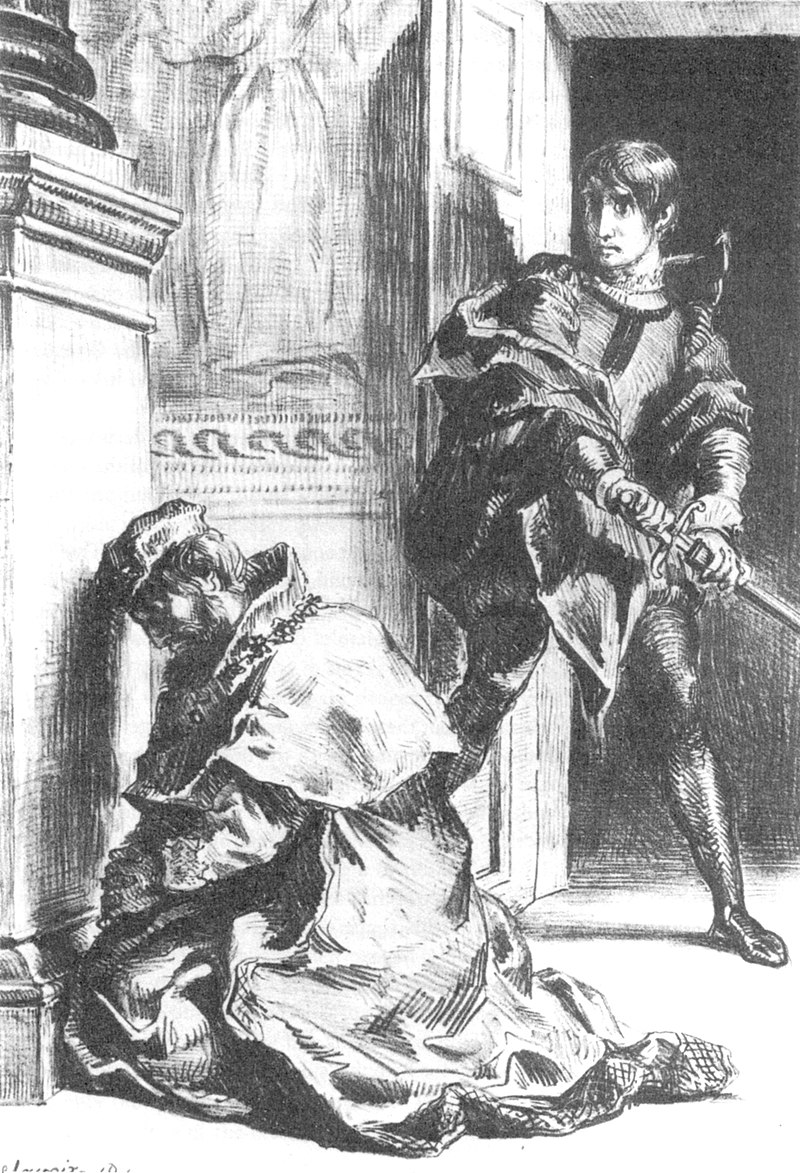 Freud suggested that an unconscious Oedipal conflict caused Hamlet's hesitations (artist: Eugène Delacroix 1844). Sigmund Freud Sigmund Freud’s thoughts regarding Hamlet were first published in his book The Interpretation of Dreams (1899), as a footnote to a discussion of Sophocles’ tragedy, Oedipus Rex, all of which is part of his consideration of the causes of neurosis. Freud does not offer over-all interpretations of the plays, but uses the two tragedies to illustrate and corroborate his psychological theories, which are based on his treatments of his patients and on his studies. Productions of Hamlet have used Freud's ideas to support their own interpretations.[117][118] In The Interpretation of Dreams, Freud says that according to his experience "parents play a leading part in the infantile psychology of all persons who subsequently become psychoneurotics," and that "falling in love with one parent and hating the other" is a common impulse in early childhood, and is important source material of "subsequent neurosis". He says that "in their amorous or hostile attitude toward their parents" neurotics reveal something that occurs with less intensity "in the minds of the majority of children". Freud considered that Sophocles’ tragedy, Oedipus Rex, with its story that involves crimes of parricide and incest, "has furnished us with legendary matter which corroborates" these ideas, and that the "profound and universal validity of the old legends" is understandable only by recognizing the validity of these theories of "infantile psychology".[119] Freud explores the reason "Oedipus Rex is capable of moving a modern reader or playgoer no less powerfully than it moved the contemporary Greeks". He suggests that "It may be that we were all destined to direct our first sexual impulses toward our mothers, and our first impulses of hatred and violence toward our fathers." Freud suggests that we "recoil from the person for whom this primitive wish of our childhood has been fulfilled with all the force of the repression which these wishes have undergone in our minds since childhood."[119] These ideas, which became a cornerstone of Freud's psychological theories, he named the "Oedipus complex", and, at one point, he considered calling it the "Hamlet complex".[120] Freud considered that Hamlet "is rooted in the same soil as Oedipus Rex." But the difference in the "psychic life" of the two civilizations that produced each play, and the progress made over time of "repression in the emotional life of humanity" can be seen in the way the same material is handled by the two playwrights: In Oedipus Rex incest and murder are brought into the light as might occur in a dream, but in Hamlet these impulses "remain repressed" and we learn of their existence through Hamlet's inhibitions to act out the revenge, while he is shown to be capable of acting decisively and boldly in other contexts. Freud asserts, "The play is based on Hamlet’s hesitation in accomplishing the task of revenge assigned to him; the text does not give the cause or the motive of this." The conflict is "deeply hidden".[121] Hamlet is able to perform any kind of action except taking revenge on the man who murdered his father and has taken his father's place with his mother—Claudius has led Hamlet to realize the repressed desires of his own childhood. The loathing which was supposed to drive him to revenge is replaced by "self-reproach, by conscientious scruples" which tell him "he himself is no better than the murderer whom he is required to punish".[122] Freud suggests that Hamlet's sexual aversion expressed in his "nunnery" conversation with Ophelia supports the idea that Hamlet is "an hysterical subject".[122][123] Freud suggests that the character Hamlet goes through an experience that has three characteristics, which he numbered: 1) "the hero is not psychopathic, but becomes so" during the course of the play. 2) "the repressed desire is one of those that are similarly repressed in all of us." It is a repression that "belongs to an early stage of our individual development". The audience identifies with the character of Hamlet, because "we are victims of the same conflict." 3) It is the nature of theatre that "the struggle of the repressed impulse to become conscious" occurs in both the hero onstage and the spectator, when they are in the grip of their emotions, "in the manner seen in psychoanalytic treatment".[124] Freud points out that Hamlet is an exception in that psychopathic characters are usually ineffective in stage plays; they "become as useless for the stage as they are for life itself", because they do not inspire insight or empathy, unless the audience is familiar with the character's inner conflict. Freud says, "It is thus the task of the dramatist to transport us into the same illness."[125] John Barrymore's long-running 1922 performance in New York, directed by Thomas Hopkins, "broke new ground in its Freudian approach to character", in keeping with the post-World War I rebellion against everything Victorian.[126] He had a "blunter intention" than presenting the genteel, sweet prince of 19th-century tradition, imbuing his character with virility and lust.[127] Beginning in 1910, with the publication of "The Œdipus-Complex as an Explanation of Hamlet's Mystery: A Study in Motive"[128] Ernest Jones—a psychoanalyst and Freud's biographer—developed Freud's ideas into a series of essays that culminated in his book Hamlet and Oedipus (1949). Influenced by Jones's psychoanalytic approach, several productions have portrayed the "closet scene", where Hamlet confronts his mother in her private quarters, in a sexual light.[129] In this reading, Hamlet is disgusted by his mother's "incestuous" relationship with Claudius while simultaneously fearful of killing him, as this would clear Hamlet's path to his mother's bed. Ophelia's madness after her father's death may also be read through the Freudian lens: as a reaction to the death of her hoped-for lover, her father. Ophelia is overwhelmed by having her unfulfilled love for him so abruptly terminated and drifts into the oblivion of insanity.[130][131] In 1937, Tyrone Guthrie directed Laurence Olivier in a Jones-inspired Hamlet at The Old Vic.[132] Olivier later used some of these same ideas in his 1948 film version of the play. In the Bloom's Shakespeare Through the Ages volume on Hamlet, editors Bloom and Foster express a conviction that the intentions of Shakespeare in portraying the character of Hamlet in the play exceeded the capacity of the Freudian Oedipus complex to completely encompass the extent of characteristics depicted in Hamlet throughout the tragedy: "For once, Freud regressed in attempting to fasten the Oedipus Complex upon Hamlet: it will not stick, and merely showed that Freud did better than T.S. Eliot, who preferred Coriolanus to Hamlet, or so he said. Who can believe Eliot, when he exposes his own Hamlet Complex by declaring the play to be an aesthetic failure?"[133] The book also notes James Joyce's interpretation, stating that he "did far better in the Library Scene of Ulysses, where Stephen marvellously credits Shakespeare, in this play, with universal fatherhood while accurately implying that Hamlet is fatherless, thus opening a pragmatic gap between Shakespeare and Hamlet."[133] Joshua Rothman has written in The New Yorker that "we tell the story wrong when we say that Freud used the idea of the Oedipus complex to understand Hamlet". Rothman suggests that "it was the other way around: Hamlet helped Freud understand, and perhaps even invent, psychoanalysis". He concludes, "The Oedipus complex is a misnomer. It should be called the 'Hamlet complex'."[134] |
精神分析 フロイトは、無意識のエディプスの葛藤がハムレットの逡巡を引き起こしたと示唆した(画家:ウジェーヌ・ドラクロワ 1844年)。 ジークムント・フロイト ハムレットに関するジークムント・フロイトの考えは、彼の著書『夢の解釈』(1899年)の中で、ソフォクレスの悲劇『オイディプス王』の考察の脚注とし て初めて発表された。フロイトは戯曲の全体的な解釈を提示するのではなく、2つの悲劇を用いて、患者の治療と研究に基づく彼の心理学理論を説明し、裏付け をとっている。夢の解釈』の中でフロイトは、彼の経験によれば、「両親は、その後精神神経症になるすべての人格の幼児心理において主導的な役割を果たして いる」と述べ、「一方の親を愛し、他方の親を憎む」ことは幼児期によく見られる衝動であり、「その後の神経症」の重要な材料であると述べている。彼は、神 経症患者は「両親に対する愛情や敵対的な態度において」、「大多数の子供たちの心の中で」それほど強くはないが起こっていることを明らかにしていると言 う。フロイトは、ソフォクレスの悲劇である『オイディプス王』は、パリサイドと近親相姦の犯罪を含む物語であり、これらの考えを「裏付ける伝説的な事柄を 我々に与えてくれた」と考え、「古い伝説の深遠で普遍的な妥当性」は、これらの「幼児心理学」の理論の妥当性を認識することによってのみ理解できると考え た[119]。 フロイトは「『オイディプス王』は、現代の読者や観劇者を、現代のギリシア人を感動させたに劣らないほど強力に感動させることができる」理由を探ってい る。彼は「私たちは皆、最初の性的衝動を母親に向け、最初の憎悪と暴力の衝動を父親に向けるように運命づけられていたのかもしれない」と示唆する。フロイ トは、われわれは「幼少期のこの原始的な願望が満たされた人格に対して、幼少期以来、これらの願望が心の中で受けてきた抑圧の力を総動員して反発する」 [119]と示唆している。 フロイトはハムレットが 「エディプス・レックスと同じ土壌に根ざしている 」と考えた。しかし、それぞれの戯曲を生み出した2つの文明の「精神生活」の異なる点、そして「人類の感情生活における抑圧」の時代的な進歩は、2人の劇 作家による同じ素材の扱い方に見ることができる: オイディプス王』では近親相姦と殺人が夢の中で起こるように明るみに出されるが、『ハムレット』ではこれらの衝動は「抑圧されたまま」であり、私たちはハ ムレットが復讐を実行することを抑制することによってその存在を知る。フロイトは、「この戯曲は、ハムレットが自分に課せられた復讐の任務を遂行すること に躊躇していることに基づいている。」と断言している。その葛藤は「深く隠されている」[121]。 ハムレットは、父を殺し、父の身代わりとなって母を殺した男に復讐すること以外には、どんな行動もとることができる-クラウディウスはハムレットに、自身 の幼少期に抑圧された欲望を実現させた。フロイトは、ハムレットがオフィーリアとの「尼僧院」での会話で表現した性的嫌悪が、ハムレットが「ヒステリック な主体」であるという考えを裏付けていると示唆している[122][123]。 1)「主人公は精神病質者ではないが、そうなる」。2)「抑圧された欲望は、私たち全員に同様に抑圧されているものの一つである」。それは「個人の発達の 初期段階に属する」抑圧である。観客がハムレットのキャラクターに共感するのは、「私たちが同じ葛藤の犠牲者だから 」である。3) 「抑圧された衝動が意識化しようとする葛藤」が、舞台上の主人公にも観客にも、感情に支配されているときに、「精神分析的治療に見られるような仕方で」起 こるのが演劇の本質である[124]。 フロイトは、サイコパスの登場人物は通常、舞台劇では効果がないという点で、『ハムレット』は例外であると指摘している。彼らは「人生そのものであるのと 同様に、舞台にとっても役に立たない存在となる」。フロイトは、「このように、私たちを同じ病気の中に連れて行くことが劇作家の仕事である」と言う [125]。 1922年にニューヨークで上演されたジョン・バリモアのロングラン公演(トーマス・ホプキンス演出)は、第一次世界大戦後のヴィクトリア朝的なものすべ てに対する反抗と歩調を合わせ、「キャラクターに対するフロイト的なアプローチにおいて新境地を開いた」[126]。彼は、19世紀の伝統にある上品で甘 美な王子様を表現するよりも「露骨な意図」を持っており、彼のキャラクターに男らしさと欲望を吹き込んでいた[127]。 1910年に出版された『ハムレットの謎の説明としてのウディプス=コンプレックス』(The Œdipus-Complex as an Explanation of Hamlet's Mystery)から始まる[128]: 精神分析医でありフロイトの伝記作家でもあるアーネスト・ジョーンズは、フロイトの考えを一連のエッセイに発展させ、彼の著書『ハムレットとエディプス』 (1949年)に結実させた。ジョーンズの精神分析的アプローチに影響され、いくつかの作品では、ハムレットが母の私室で母と対峙する「クローゼットの場 面」が性的な観点から描かれている[129]。この読み方では、ハムレットはクローディアスと母の「近親相姦」関係に嫌悪感を抱くと同時に、クローディア スを殺すことを恐れている。父の死後のオフィーリアの狂気も、フロイトのレンズを通して読むことができる。オフィーリアは、父への叶わぬ愛を突然打ち切ら れたことに打ちひしがれ、狂気の忘却の彼方へと流れていく。 1937年、タイロン・ガスリーはローレンス・オリヴィエを演出し、オールド・ヴィックでジョーンズにインスパイアされた『ハムレット』を上演した [132]。 ハムレット』に関するブルームの『シェイクスピア・スルー・ザ・エイジズ』の中で、編者のブルームとフォスターは、劇中でハムレットのキャラクターを描く シェイクスピアの意図主義は、フロイトのエディプス・コンプレックスが、悲劇全体を通してハムレットに描かれた特徴の範囲を完全に包含する能力を超えてい るという確信を表明している。 S.エリオットはハムレットよりもコリオレイナスを好んだ。この戯曲を美学的に失敗作であると断言することで、彼自身のハムレット・コンプレックスを露呈 しているのだから、誰がエリオットを信じることができるだろうか」[133]。この本はまた、ジェイムズ・ジョイスの解釈にも言及しており、彼は「『ユリ シーズ』の図書館の場面では、スティーヴンがこの戯曲におけるシェイクスピアの普遍的な父性を見事に信用する一方で、ハムレットには父親がいないことを正 確に暗示し、その結果、シェイクスピアとハムレットの間に現実的な隔たりができた」と述べている[133]。 ジョシュア・ロスマンは『ニューヨーカー』誌に、「フロイトがハムレットを理解するためにエディプス・コンプレックスの考えを用いたと言うとき、私たちは その話を間違って伝えている」と書いている。ロスマンは、「ハムレットはフロイトを理解するのに役立った: ハムレットはフロイトが精神分析を理解し、おそらくは発明するのに役立ったのだ」。エディプス・コンプレックスは誤用である。ハムレット・コンプレック ス』と呼ぶべきだ」と結論づけている[134]。 |
| Jacques Lacan In the 1950s, the French psychoanalyst Jacques Lacan analyzed Hamlet to illustrate some of his concepts. His structuralist theories about Hamlet were first presented in a series of seminars given in Paris and later published in "Desire and the Interpretation of Desire in Hamlet". Lacan postulated that the human psyche is determined by structures of language and that the linguistic structures of Hamlet shed light on human desire.[135] His point of departure is Freud's Oedipal theories, and the central theme of mourning that runs through Hamlet.[136] In Lacan's analysis, Hamlet unconsciously assumes the role of phallus—the cause of his inaction—and is increasingly distanced from reality "by mourning, fantasy, narcissism and psychosis", which create holes (or lack) in the real, imaginary, and symbolic aspects of his psyche.[135] Lacan's theories influenced some subsequent literary criticism of Hamlet because of his alternative vision of the play and his use of semantics to explore the play's psychological landscape.[135] |
ジャック・ラカン 1950年代、フランスの精神分析学者ジャック・ラカンは、自身の概念のいくつかを説明するためにハムレットを分析した。ハムレットに関する彼の構造主義 理論は、パリで行われた一連のセミナーで初めて発表され、後に『ハムレットにおける欲望と欲望の解釈』として出版された。ラカンは、人間の精神は言語の構 造によって決定され、『ハムレット』の言語構造が人間の欲望に光を当てていると仮定した[135]。 [136]ラカンの分析では、ハムレットは無意識のうちにファルスの役割-彼の無為の原因-を引き受け、「喪、空想、ナルシシズム、精神病によって」現実 からますます遠ざかっていく。 |
Feminist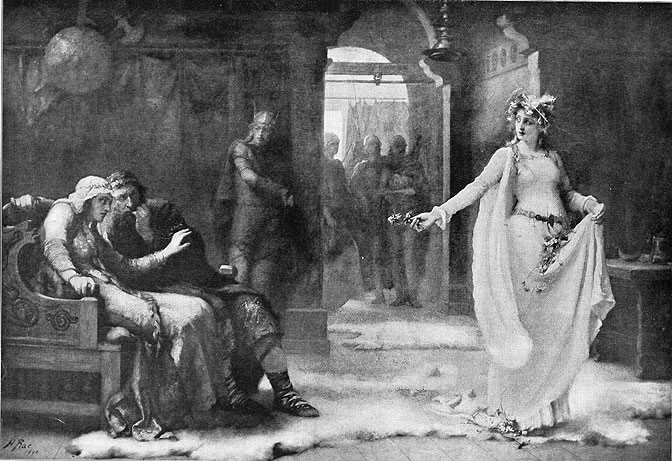 Ophelia is distracted by grief.[137] Feminist critics have explored her descent into madness (artist: Henrietta Rae 1890). In the 20th century, feminist critics opened up new approaches to Gertrude and Ophelia. New historicist and cultural materialist critics examined the play in its historical context, attempting to piece together its original cultural environment.[138] They focused on the gender system of early modern England, pointing to the common trinity of maid, wife, or widow, with whores outside of that stereotype. In this analysis, the essence of Hamlet is the central character's changed perception of his mother as a whore because of her failure to remain faithful to Old Hamlet. In consequence, Hamlet loses his faith in all women, treating Ophelia as if she too were a whore and dishonest with Hamlet.[139]  Hamlet tries to show his mother Gertrude his father's ghost (artist: Nicolai A. Abildgaard, c. 1778). Carolyn Heilbrun's 1957 essay "The Character of Hamlet's Mother" defends Gertrude, arguing that the text never hints that Gertrude knew of Claudius poisoning King Hamlet. This analysis has been praised by many feminist critics, combating what is, by Heilbrun's argument, centuries' worth of misinterpretation. By this account, Gertrude's worst crime is of pragmatically marrying her brother-in-law in order to avoid a power vacuum. This is borne out by the fact that King Hamlet's ghost tells Hamlet to leave Gertrude out of Hamlet's revenge, to leave her to heaven, an arbitrary mercy to grant to a conspirator to murder.[140][141][142] Ophelia has also been defended by feminist critics, most notably Elaine Showalter.[143] Ophelia is surrounded by powerful men: her father, brother, and Hamlet. All three disappear: Laertes leaves, Hamlet abandons her, and Polonius dies. Conventional theories had argued that without these three powerful men making decisions for her, Ophelia is driven into madness.[144] Feminist theorists argue that she goes mad with guilt because, when Hamlet kills her father, he has fulfilled her sexual desire to have Hamlet kill her father so they can be together. Showalter points out that Ophelia has become the symbol of the distraught and hysterical woman in modern culture.[145] |
フェミニスト オフィーリアは悲しみに取り乱す[137]。フェミニスト批評家たちは、彼女の狂気への転落を探求してきた(画家:ヘンリエッタ・レー1890年)。 20世紀には、フェミニスト批評家たちがガートルードとオフィーリアへの新たなアプローチを切り開いた。新歴史主義的、文化的唯物論的な批評家たちは、こ の戯曲を歴史的文脈の中で検討し、その本来の文化的環境をつなぎ合わせようとした[138]。彼らは近世イングランドのジェンダー・システムに注目し、メ イド、妻、未亡人という一般的な三位一体、そしてそのステレオタイプから外れた娼婦を指摘した。この分析では、『ハムレット』の本質は、主人公が老ハム レットに誠実であり続けられなかったために、母親を娼婦として認識するようになったことにある。その結果、ハムレットはすべての女性に対する信頼を失い、 オフィーリアも娼婦でありハムレットに不誠実であるかのように扱う[139]。  ハムレットは母ガートルードに父の亡霊を見せようとする(画家:ニコライ・A・アビルドガード、1778年頃)。 キャロライン・ハイルブランの1957年のエッセイ『ハムレットの母の性格』はガートルードを擁護し、テキストはガートルードがクローディアスがハムレッ ト王に毒を盛ったことを知っていたことをほのめかしていないと論じている。この分析は多くのフェミニスト批評家たちから賞賛され、ハイルブランの議論によ れば、何世紀にもわたる誤った解釈に対抗するものである。この説明によれば、ガートルードの最悪の罪は、権力の空白を避けるために現実的に義弟と結婚した ことである。このことは、ハムレット王の亡霊がハムレットに、ガートルードをハムレットの復讐から外すように、天に任せるように、殺人の共謀者に与えるに は恣意的な慈悲であると告げていることからも裏付けられる[140][141][142]。 オフィーリアはまた、フェミニスト批評家、特にエレイン・ショウォルターによって擁護されている[143]。3人とも姿を消す: ラールテスは去り、ハムレットは彼女を見捨て、ポローニアスは死ぬ。従来の理論では、オフィーリアはこの3人の強力な男性に意思決定をしてもらわなけれ ば、狂気に追い込まれると論じられていた[144]。フェミニストの理論家は、ハムレットが父親を殺したとき、ハムレットに父親を殺してもらい、2人で一 緒になりたいという性的欲求が満たされたため、オフィーリアは罪悪感で狂ってしまったと主張する。ショウォルターは、オフィーリアが現代文化において取り 乱したヒステリックな女性の象徴になっていると指摘する[145]。 |
| Influence See also: Literary influence of Hamlet Hamlet is one of the most quoted works in the English language, and is often included on lists of the world's greatest literature.[c] As such, it reverberates through the writing of later centuries. Academic Laurie Osborne identifies the direct influence of Hamlet in numerous modern narratives, and divides them into four main categories: fictional accounts of the play's composition, simplifications of the story for young readers, stories expanding the role of one or more characters, and narratives featuring performances of the play.[147] 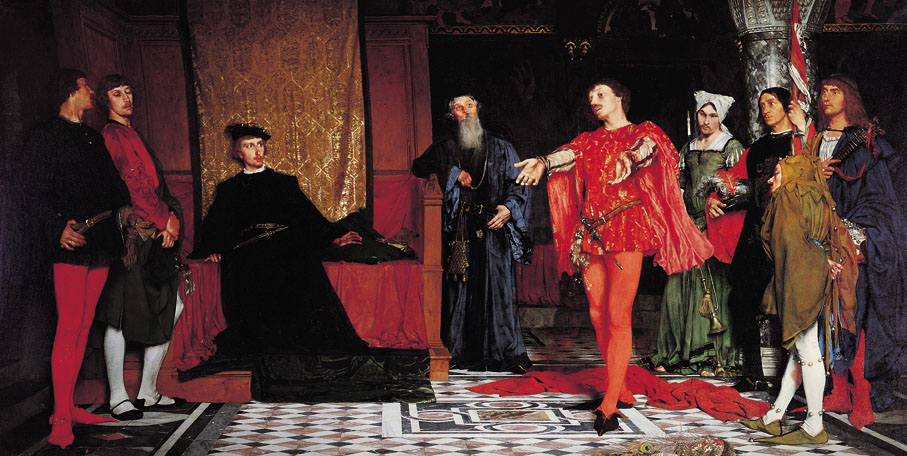 Actors before Hamlet by Władysław Czachórski (1875), National Museum in Warsaw English poet John Milton was an early admirer of Shakespeare and took evident inspiration from his work. As John Kerrigan discusses, Milton originally considered writing his epic poem Paradise Lost (1667) as a tragedy.[148] While Milton did not ultimately go that route, the poem still shows distinct echoes of Shakespearean revenge tragedy, and of Hamlet in particular. As scholar Christopher N. Warren argues, Paradise Lost's Satan "undergoes a transformation in the poem from a Hamlet-like avenger into a Claudius-like usurper," a plot device that supports Milton's larger Republican internationalist project.[149] The poem also reworks theatrical language from Hamlet, especially around the idea of "putting on" certain dispositions, as when Hamlet puts on "an antic disposition," similarly to the Son in Paradise Lost who "can put on / [God's] terrors."[150] Henry Fielding's Tom Jones, published about 1749, describes a visit to Hamlet by Tom Jones and Mr Partridge, with similarities to the "play within a play".[151] In contrast, Goethe's Bildungsroman Wilhelm Meister's Apprenticeship, written between 1776 and 1796, not only has a production of Hamlet at its core but also creates parallels between the ghost and Wilhelm Meister's dead father.[151] In the early 1850s, in Pierre, Herman Melville focuses on a Hamlet-like character's long development as a writer.[151] Ten years later, Dickens's Great Expectations contains many Hamlet-like plot elements: it is driven by revenge-motivated actions, contains ghost-like characters (Abel Magwitch and Miss Havisham), and focuses on the hero's guilt.[151] Academic Alexander Welsh notes that Great Expectations is an "autobiographical novel" and "anticipates psychoanalytic readings of Hamlet itself".[152] About the same time, George Eliot's The Mill on the Floss was published, introducing Maggie Tulliver "who is explicitly compared with Hamlet"[153] though "with a reputation for sanity".[154] In the 1920s, James Joyce managed "a more upbeat version" of Hamlet—stripped of obsession and revenge—in Ulysses, though its main parallels are with Homer's Odyssey.[151] In the 1990s, two novelists were explicitly influenced by Hamlet. In Angela Carter's Wise Children, To be or not to be is reworked as a song and dance routine, and Iris Murdoch's The Black Prince has Oedipal themes and murder intertwined with a love affair between a Hamlet-obsessed writer, Bradley Pearson, and the daughter of his rival.[153] In the late 20th century, David Foster Wallace's novel Infinite Jest draws heavily from Hamlet and takes its title from the play's text. There is the story of the woman who read Hamlet for the first time and said, "I don't see why people admire that play so. It is nothing but a bunch of quotations strung together." — Isaac Asimov, Asimov's Guide to Shakespeare, p. vii, Avenal Books, 1970 |
影響力 こちらも参照のこと: ハムレット』の文学的影響 ハムレット』は英語で最も引用される作品のひとつであり、世界の名作文学のリストにもしばしば名を連ねる[c]。学者であるローリー・オズボーンは、数多 くの現代の物語におけるハムレットの直接的な影響を特定し、それらを4つの主要なカテゴリーに分類している:戯曲の構成に関するフィクションの説明、若い 読者のための物語の単純化、1人または複数の登場人物の役割を拡大した物語、戯曲の上演を特徴とする物語である[147]。  ヴワディスワフ・チャチョルスキ作『ハムレットの前の俳優たち』(1875年)、ワルシャワ国民博物館蔵 イギリスの詩人ジョン・ミルトンは、早くからシェイクスピアを敬愛し、彼の作品から明らかなインスピレーションを得ていた。ジョン・ケリガンが論じている ように、ミルトンは当初、叙事詩『失楽園』(1667年)を悲劇として書くことを考えていた[148]。ミルトンは最終的にそのような路線には進まなかっ たものの、この詩にはシェイクスピアの復讐悲劇、特に『ハムレット』の明確な響きが残っている。学者クリストファー・N・ウォーレンが論じているように、 『失楽園』のサタンは「詩の中でハムレットのような復讐者からクローディアスのような簒奪者へと変貌を遂げる」のであり、これはミルトンのより大きな共和 主義的国際主義プロジェクトを支える筋立てである。 [149] この詩はまた『ハムレット』から演劇的な言葉、特にハムレットが「反抗的な気質」を身につけるときのように、ある気質を「身につける」というアイデアにま つわる言葉を再構築しており、『失楽園』における「(神の)恐怖を身につけることができる」息子に似ている[150]。 1749年頃に出版されたヘンリー・フィールディングの『トム・ジョーンズ』では、トム・ジョーンズとミスター・パートリッジによるハムレットの訪問が描 かれており、「劇中劇」との類似性が指摘されている[151]。 対照的に、1776年から1796年にかけて書かれたゲーテのビルドゥングスロマン『ヴィルヘルム・マイスターの徒弟時代』では、ハムレットの演出が核と なっているだけでなく、幽霊とヴィルヘルム・マイスターの死んだ父親との間に類似性が生じている[151]。 [151]その10年後、ディケンズの『Great Expectations』にはハムレットに似たプロットの要素が多く含まれている。復讐を動機とする行動によって駆動され、幽霊のような登場人物(アベ ル・マグウィッチとミス・ハビシャム)が登場し、主人公の罪の意識に焦点が当てられている。 [151]学者のアレクサンダー・ウェルシュは、『Great Expectations』は「自伝的小説」であり、「『ハムレット』そのものの精神分析的読解を先取りしている」と指摘する[152]。ほぼ同時期に、 ジョージ・エリオットの『The Mill on the Floss』が出版され、「正気であるという評判はあるが」[153]「ハムレットと明確に比較される」マギー・タリバーが登場する[154]。 1920年代には、ジェイムズ・ジョイスが『ユリシーズ』の中で執着と復讐を取り除いたハムレットの「より明るいバージョン」を作り上げているが、その主 な類似点はホメロスの『オデュッセイア』である[151]。 1990年代には、2人の小説家がハムレットから明確な影響を受けている。アンジェラ・カーターの『ワイズ・チルドレン』では、『To be or not to be』が歌とダンスのルーティンとして再構築され、アイリス・マードックの『The Black Prince』では、エディプスのテーマと殺人が、ハムレットに取り憑かれた作家ブラッドリー・ピアソンとライバルの娘との恋愛と絡み合っている。 初めて『ハムレット』を読んだ女性が、「あの戯曲を賞賛する理由がわからない。あの戯曲は引用の羅列にすぎない」。 - アイザック・アシモフ『アシモフのシェイクスピア・ガイド』p.vii、アヴェナル・ブックス、1970年 |
| Performance history Main articles: Hamlet in performance and Shakespeare in performance The day we see Hamlet die in the theatre, something of him dies for us. He is dethroned by the spectre of an actor, and we shall never be able to keep the usurper out of our dreams. Maurice Maeterlinck in La Jeune Belgique (1890).[155] Shakespeare's day to the Interregnum Shakespeare almost certainly wrote the role of Hamlet for Richard Burbage. He was the chief tragedian of the Lord Chamberlain's Men, with a capacious memory for lines and a wide emotional range.[156][157][d] Judging by the number of reprints, Hamlet appears to have been Shakespeare's fourth most popular play during his lifetime—only Henry IV Part 1, Richard III and Pericles eclipsed it.[161] Shakespeare provides no clear indication of when his play is set; however, as Elizabethan actors performed at the Globe in contemporary dress on minimal sets, this would not have affected the staging.[162] Firm evidence for specific early performances of the play is scant. It is sometimes argued that the crew of the ship Red Dragon, anchored off Sierra Leone, performed Hamlet in September 1607;[163][164][165] however, this claim is based on a 19th-century insert of a 'lost' passage into a period document, and is today widely regarded as a hoax, likely to have been perpetrated by John Payne Collier.[166] More credible is that the play toured in Germany within five years of Shakespeare's death,[165] and that it was performed before James I in 1619 and Charles I in 1637.[167] Oxford editor George Hibbard argues that, since the contemporary literature contains many allusions and references to Hamlet (only Falstaff is mentioned more, from Shakespeare), the play was surely performed with a frequency that the historical record misses.[168] All theatres were closed down by the Puritan government during the Interregnum.[169] Even during this time, however, playlets known as drolls were often performed illegally, including one called The Grave-Makers based on act 5, scene 1 of Hamlet.[170] |
パフォーマンスの歴史 主な記事 上演されるハムレット、上演されるシェイクスピア ハムレットが劇場で死ぬのを見た日、彼の何かが私たちのために死ぬ。彼は俳優という亡霊によって退位させられ、われわれはその簒奪者をわれわれの夢から遠ざけておくことはできないだろう。 モーリス・メーテルリンク『La Jeune Belgique』(1890年)所収[155]。 シェイクスピアと摂政時代 シェイクスピアはほぼ間違いなく、リチャード・バーベッジのためにハムレット役を書いた。再版の数から判断すると、『ハムレット』はシェイクスピアにとっ て生涯で4番目に人気のある戯曲であり、『ヘンリー四世』第1部、『リチャード三世』、『ペリクリーズ』に次ぐものであった[161]。 [161] シェイクスピアは戯曲の舞台がいつであるかを明確に示していないが、エリザベス朝時代の俳優たちはグローブ座で最小限のセットで現代的な服装で上演してい たため、演出に影響はなかっただろう[162]。 この戯曲の具体的な初期の上演に関する確かな証拠は乏しい。シエラレオネ沖に停泊していたレッド・ドラゴン号の乗組員が1607年9月に『ハムレット』を 上演したと主張されることもあるが[163][164][165]、この主張は19世紀に挿入された当時の文献の「失われた」一節に基づくものであり、今 日ではジョン・ペイン・コリアーによって行われた可能性が高いデマと広くみなされている[166]。 [166]より信憑性が高いのは、シェイクスピアの死後5年以内にドイツで巡演されたこと[165]、1619年にジェームズ1世の前で、1637年に チャールズ1世の前で上演されたことである[167]。オックスフォードの編集者ジョージ・ヒバードは、現代の文献にはハムレットに対する多くの暗示や言 及が含まれていることから(シェイクスピアからはファルスタッフだけがより多く言及されている)、この戯曲は史実が見逃している頻度で上演されていたこと は確かだと論じている[168]。 しかし、この時期にも、『ハムレット』の第5幕第1場に基づいて作られた『The Grave-Makers』と呼ばれるものなど、ドロールと呼ばれる劇がしばしば違法に上演されていた[170]。 |
Restoration and 18th century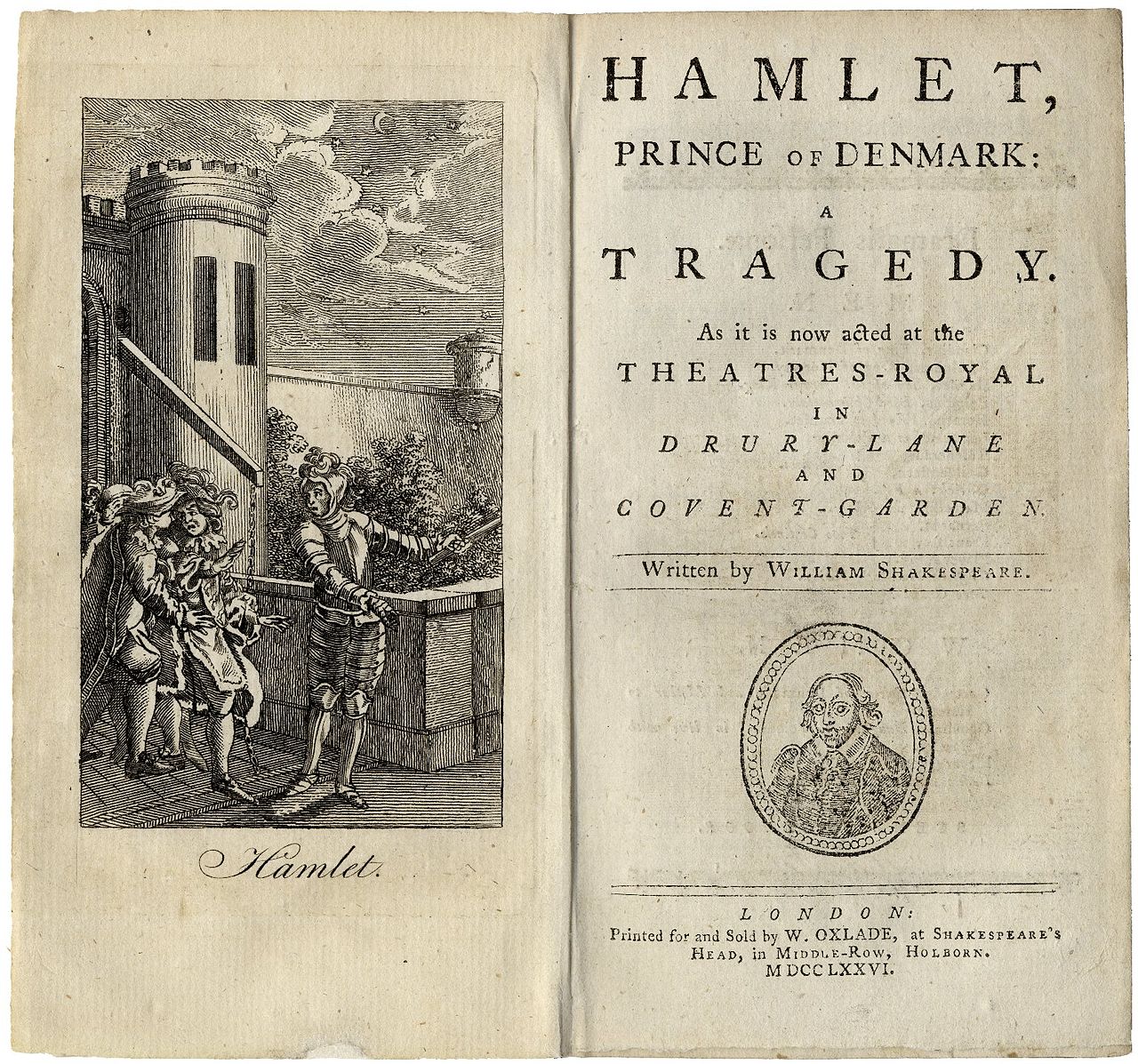 Title page and frontispiece for Hamlet, Prince of Denmark: A Tragedy. As it is now acted at the Theatres-Royal in Drury-Lane and Covent-Garden. London, 1776 The play was revived early in the Restoration. When the existing stock of pre-civil war plays was divided between the two newly created patent theatre companies, Hamlet was the only Shakespearean favourite that Sir William Davenant's Duke's Company secured.[171] It became the first of Shakespeare's plays to be presented with movable flats painted with generic scenery behind the proscenium arch of Lincoln's Inn Fields Theatre.[e] This new stage convention highlighted the frequency with which Shakespeare shifts dramatic location, encouraging the recurrent criticism of his failure to maintain unity of place.[173] In the title role, Davenant cast Thomas Betterton, who continued to play the Dane until he was 74.[174] David Garrick at Drury Lane produced a version that adapted Shakespeare heavily; he declared: "I had sworn I would not leave the stage till I had rescued that noble play from all the rubbish of the fifth act. I have brought it forth without the grave-digger's trick, Osrick, & the fencing match".[f] The first actor known to have played Hamlet in North America is Lewis Hallam Jr., in the American Company's production in Philadelphia in 1759.[176] 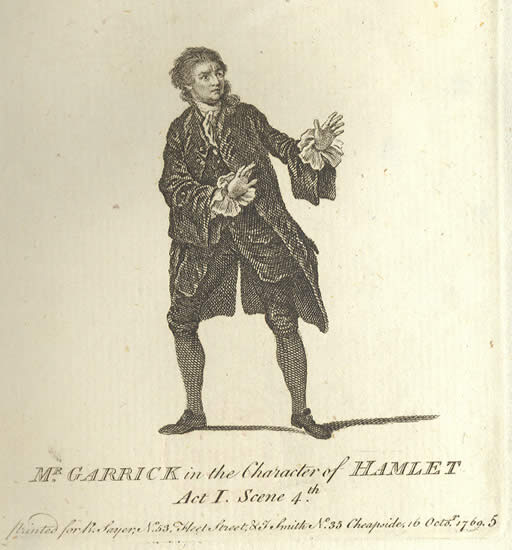 David Garrick expresses Hamlet's shock at his first sighting of the ghost (artist: unknown). John Philip Kemble made his Drury Lane debut as Hamlet in 1783.[177] His performance was said to be 20 minutes longer than anyone else's, and his lengthy pauses provoked the suggestion by Richard Brinsley Sheridan that "music should be played between the words".[178] Sarah Siddons was the first actress known to play Hamlet; many women have since played him as a breeches role, to great acclaim.[179] In 1748, Alexander Sumarokov wrote a Russian adaptation that focused on Prince Hamlet as the embodiment of an opposition to Claudius's tyranny—a treatment that would recur in Eastern European versions into the 20th century.[180] In the years following America's independence, Thomas Abthorpe Cooper, the young nation's leading tragedian, performed Hamlet among other plays at the Chestnut Street Theatre in Philadelphia, and at the Park Theatre in New York. Although chided for "acknowledging acquaintances in the audience" and "inadequate memorisation of his lines", he became a national celebrity.[181] |
復刻と18世紀 ハムレット、デンマークの王子』のタイトルページと扉絵: 悲劇。現在ドゥルリー・レーンとコーヴェント・ガーデンの王立劇場で上演されている。ロンドン、1776年 この戯曲は、王政復古の初期に再演された。内戦前の戯曲の既存のストックが、新しく創設された2つの特許劇団に分割されたとき、『ハムレット』は、サー・ ウィリアム・ダヴェナントのデュークス・カンパニーが確保した唯一のシェイクスピア戯曲であった[171]。この戯曲は、リンカーンズ・イン・フィールズ 劇場のプロセニアム・アーチの背後に一般的な風景を描いた可動式のフラットで上演されたシェイクスピア戯曲の最初の作品となった。 [ダヴェナントはタイトルロールにトーマス・ベタートンを起用し、彼は74歳までデーンを演じ続けた[174]: 「私は、この高貴な戯曲を第五幕のあらゆるゴミから救い出すまで、舞台を降りないと誓っていた。私は、墓掘り人のトリック、オズリック、フェンシングの試 合なしに、この戯曲を世に送り出した」[f] 北米でハムレットを演じた最初の俳優として知られているのは、1759年にフィラデルフィアで上演されたアメリカン・カンパニーのルイス・ハラム・ジュニ アである[176]。  デイヴィッド・ギャリックが初めて幽霊を見たハムレットの衝撃を表現している(作者不詳)。 ジョン・フィリップ・ケンブルは1783年にハムレット役でドラリー・レーンにデビューした[177]。彼の演技は他の誰よりも20分長かったと言われ、 その長い間奏はリチャード・ブリンスリー・シェリダンの「言葉の間に音楽を流すべきだ」という提案を誘発した[178]。サラ・シドンズはハムレットを演 じた最初の女優として知られている。 [179]1748年、アレクサンドル・スマロコフは、クローディアスの専制政治に反対する体現者としてのハムレット王子に焦点を当てたロシア語版を書い たが、この扱いは20世紀まで東欧版で繰り返されることになる[180]。 アメリカ独立後の数年間、若き国民を代表する悲劇家トーマス・アブソープ・クーパーは、フィラデルフィアのチェスナット・ストリート劇場やニューヨークの パーク劇場で、他の戯曲に混じってハムレットを上演した。客席に知り合いがいることを認める」「セリフの暗記が不十分」と非難されたが、彼は国民的な有名 人になった[181]。 |
19th century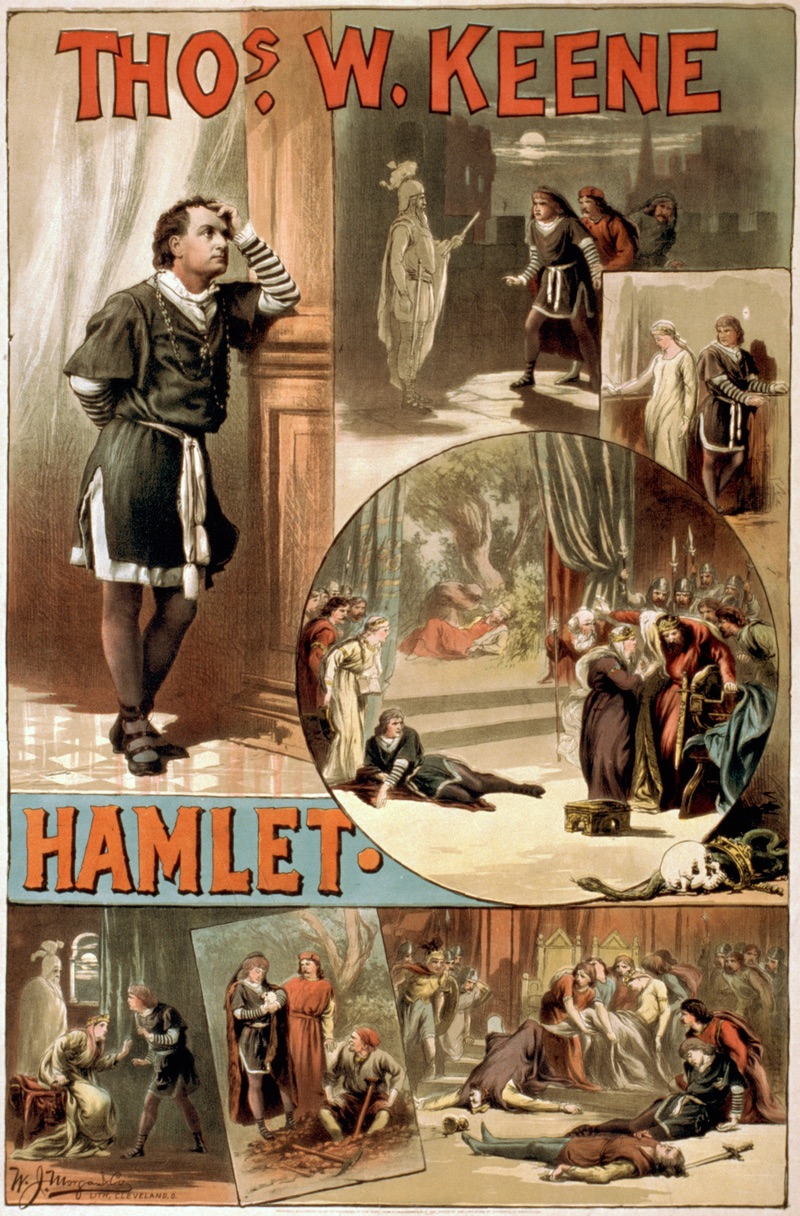 A poster, c. 1884, for an American production of Hamlet (starring Thomas W. Keene), showing several of the key scenes From around 1810 to 1840, the best-known Shakespearean performances in the United States were tours by leading London actors—including George Frederick Cooke, Junius Brutus Booth, Edmund Kean, William Charles Macready, and Charles Kemble. Of these, Booth remained to make his career in the States, fathering the nation's most notorious actor, John Wilkes Booth (who later assassinated Abraham Lincoln), and its most famous Hamlet, Edwin Booth.[182] Edwin Booth's Hamlet at the Fifth Avenue Theatre in 1875 was described as "... the dark, sad, dreamy, mysterious hero of a poem. [... acted] in an ideal manner, as far removed as possible from the plane of actual life".[183][184] Booth played Hamlet for 100 nights in the 1864/5 season at the Winter Garden Theatre, inaugurating the era of long-run Shakespeare in America.[184] In the United Kingdom, the actor-managers of the Victorian era (including Kean, Samuel Phelps, Macready, and Henry Irving) staged Shakespeare in a grand manner, with elaborate scenery and costumes.[185] The tendency of actor-managers to emphasise the importance of their own central character did not always meet with the critics' approval. George Bernard Shaw's praise for Johnston Forbes-Robertson's performance contains a sideswipe at Irving: "The story of the play was perfectly intelligible, and quite took the attention of the audience off the principal actor at moments. What is the Lyceum coming to?"[g] In London, Edmund Kean was the first Hamlet to abandon the regal finery usually associated with the role in favour of a plain costume, and he is said to have surprised his audience by playing Hamlet as serious and introspective.[187] In stark contrast to earlier opulence, William Poel's 1881 production of the Q1 text was an early attempt at reconstructing the Elizabethan theatre's austerity; his only backdrop was a set of red curtains.[49][188] Sarah Bernhardt played the prince in her popular 1899 London production. In contrast to the "effeminate" view of the central character that usually accompanied a female casting, she described her character as "manly and resolute, but nonetheless thoughtful ... [he] thinks before he acts, a trait indicative of great strength and great spiritual power".[h] In France, Charles Kemble initiated an enthusiasm for Shakespeare; and leading members of the Romantic movement such as Victor Hugo and Alexandre Dumas saw his 1827 Paris performance of Hamlet, particularly admiring the madness of Harriet Smithson's Ophelia.[190] In Germany, Hamlet had become so assimilated by the mid-19th century that Ferdinand Freiligrath declared that "Germany is Hamlet".[191] From the 1850s, the Parsi theatre tradition in India transformed Hamlet into folk performances, with dozens of songs added.[192] |
19世紀 1884年頃、アメリカにおける『ハムレット』(トーマス・W・キーン主演)のポスター。 1810年頃から1840年頃まで、アメリカで最もよく知られたシェイクスピア劇は、ジョージ・フレデリック・クック、ジュニアス・ブルータス・ブース、 エドモンド・キーン、ウィリアム・チャールズ・マクリーディ、チャールズ・ケンブルをはじめとするロンドンの一流俳優によるツアーだった。1875年に五 番街劇場で上演されたエドウィン・ブースのハムレットは、「......暗く、悲しく、夢見がちで、ミステリアスな詩の主人公」と評された。[183] [184]ブースは1864/5シーズンにウィンター・ガーデン・シアターで100夜にわたってハムレットを演じ、アメリカにおけるシェイクスピアのロン グラン時代を築いた[184]。 イギリスでは、ヴィクトリア朝時代の俳優監督たち(キーン、サミュエル・フェルプス、マクリーディ、ヘンリー・アーヴィングなど)が、凝った舞台美術と衣 装でシェイクスピアを盛大に上演した[185]。俳優監督たちが自分たちの中心人物の重要性を強調する傾向は、必ずしも批評家たちの賛同を得るものではな かった。ジョージ・バーナード・ショーはジョンストン・フォーブス・ロバートソンの演技を賞賛しているが、その中にはアーヴィングに対する横やりが含まれ ている: 「戯曲のストーリーは完璧に理解できるもので、観客の注意を主役の俳優から奪っていた。ライシアムはどうなっているんだ」[g]。 ロンドンでは、エドモンド・キーンが、通常ハムレット役に付随する威厳のある華美さを捨て、地味な衣装を選んだ最初のハムレットであり、彼はハムレットを 真面目で内省的な役として演じて観客を驚かせたと言われている[187]。 それ以前の豪華さとは対照的に、ウィリアム・ポエルの1881年のQ1テキストの演出は、エリザベス朝劇場の厳格さを再構築する初期の試みであり、彼の背 景は赤いカーテンのセットだけであった[49][188]。通常、女性の配役に伴う中心人物の「女々しい」見方とは対照的に、彼女は自分の役柄を「男らし くて毅然としているが、それにもかかわらず思慮深い......」と表現した。[彼は)行動する前に考えるが、それは大きな強さと大きな精神力を示す特徴 である」と評している[h]。 フランスでは、シャルル・ケンブルがシェイクスピアに熱狂するきっかけとなり、ヴィクトル・ユーゴーやアレクサンドル・デュマといったロマン主義運動の主 要メンバーが1827年にパリで上演された『ハムレット』を観劇し、特にハリエット・スミッソンが演じたオフィーリアの狂気に感嘆した。 [190]ドイツでは、19世紀半ばまでにハムレットは同化し、フェルディナント・フライリヒラートは「ドイツはハムレットである」と宣言した [191]。1850年代から、インドのパールシー演劇の伝統は、ハムレットを民俗的な演目に変え、何十もの歌を加えた[192]。 |
| 20th century Apart from some western troupes' 19th-century visits, the first professional performance of Hamlet in Japan was Otojirō Kawakami's 1903 Shinpa ("new school theatre") adaptation.[193] Tsubouchi Shōyō translated Hamlet and produced a performance in 1911 that blended Shingeki ("new drama") and Kabuki styles.[193] This hybrid-genre reached its peak in Tsuneari Fukuda's 1955 Hamlet.[193] In 1998, Yukio Ninagawa produced an acclaimed version of Hamlet in the style of Nō theatre, which he took to London.[194] Konstantin Stanislavski and Edward Gordon Craig—two of the 20th century's most influential theatre practitioners—collaborated on the Moscow Art Theatre's seminal production of 1911–12.[i] While Craig favoured stylised abstraction, Stanislavski, armed with his 'system,' explored psychological motivation.[196] Craig conceived of the play as a symbolist monodrama, offering a dream-like vision as seen through Hamlet's eyes alone.[j] This was most evident in the staging of the first court scene.[200][k] The most famous aspect of the production is Craig's use of large, abstract screens that altered the size and shape of the acting area for each scene, representing the character's state of mind spatially or visualising a dramaturgical progression.[202] The production attracted enthusiastic and unprecedented worldwide attention for the theatre and placed it "on the cultural map for Western Europe".[203][204] The first modern dress stagings of Hamlet happened in 1925 in London and then New York. Barry Jackson's Birmingham Repertory Theatre opened their production, directed by H.K. Ayliff at the Kingsway Theatre on August 25, 1925.[205] Ivor Brown reported, "Many of the first night audience came to scoff and remained to hold its breath, to marvel and enjoy. . . .Shakespeare's victory over time and tailoring was swift and sweeping."[206] Horace Brisbin Liveright's modern dress production opened at the Booth Theater in New York on November 9, 1925, the same night that the London production moved to Birmingham. It was known "more dryly, and perhaps with a touch of something more sinister, as 'the plain-clothes Hamlet'" and did not reach the same level of success.[205] Hamlet is often played with contemporary political overtones. Leopold Jessner's 1926 production at the Berlin Staatstheater portrayed Claudius's court as a parody of the corrupt and fawning court of Kaiser Wilhelm.[207] In Poland, the number of productions of Hamlet has tended to increase at times of political unrest, since its political themes (suspected crimes, coups, surveillance) can be used to comment on a contemporary situation.[208] Similarly, Czech directors have used the play at times of occupation: a 1941 Vinohrady Theatre production "emphasised, with due caution, the helpless situation of an intellectual attempting to endure in a ruthless environment".[209][210] In China, performances of Hamlet often have political significance: Gu Wuwei's 1916 The Usurper of State Power, an amalgam of Hamlet and Macbeth, was an attack on Yuan Shikai's attempt to overthrow the republic.[211] In 1942, Jiao Juyin directed the play in a Confucian temple in Sichuan Province, to which the government had retreated from the advancing Japanese.[211] In the immediate aftermath of the collapse of the protests at Tiananmen Square, Lin Zhaohua staged a 1990 Hamlet in which the prince was an ordinary individual tortured by a loss of meaning. In this production, the actors playing Hamlet, Claudius and Polonius exchanged roles at crucial moments in the performance, including the moment of Claudius's death, at which point the actor mainly associated with Hamlet fell to the ground.[212] 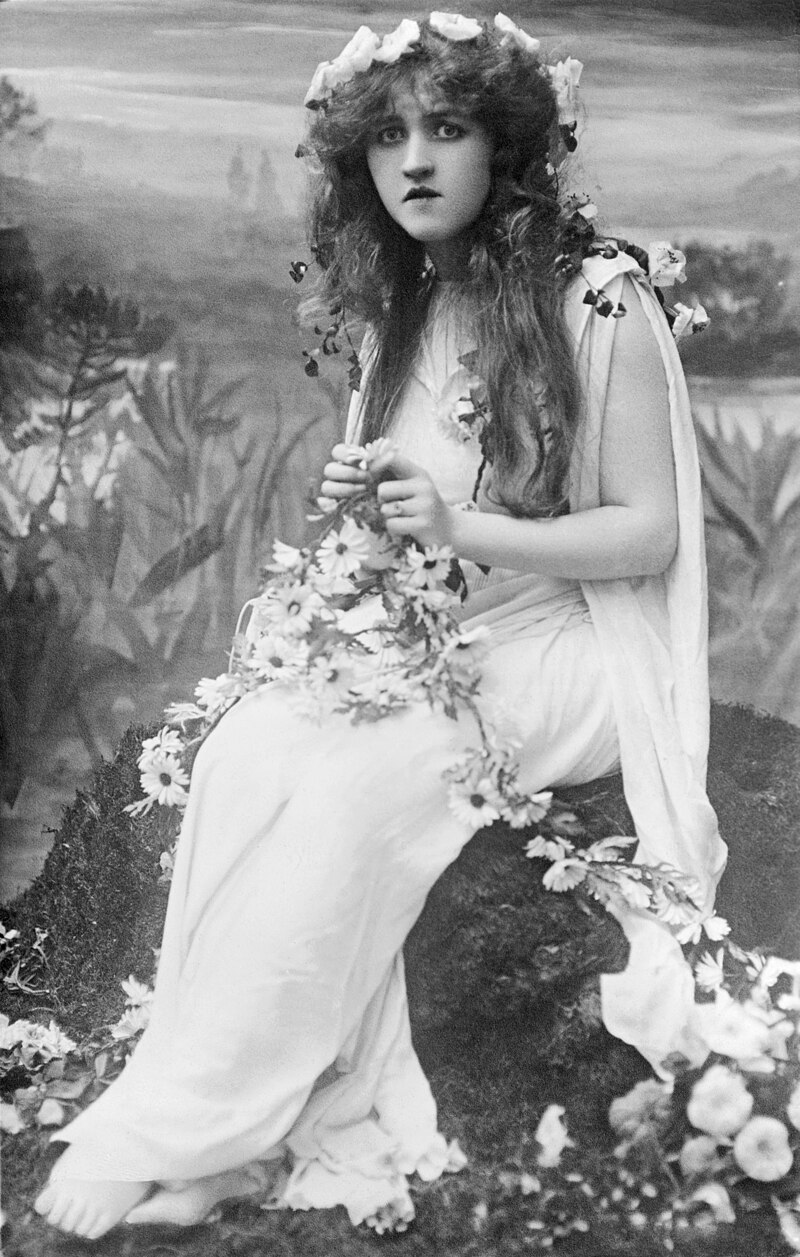 Mignon Nevada as Ophelia, 1910 Notable stagings in London and New York include Barrymore's 1925 production at the Haymarket; it influenced subsequent performances by John Gielgud and Laurence Olivier.[213][214] Gielgud played the central role many times: his 1936 New York production ran for 132 performances, leading to the accolade that he was "the finest interpreter of the role since Barrymore".[215] Although "posterity has treated Maurice Evans less kindly", throughout the 1930s and 1940s he was regarded by many as the leading interpreter of Shakespeare in the United States and in the 1938/39 season he presented Broadway's first uncut Hamlet, running four and a half hours.[216] Evans later performed a highly truncated version of the play that he played for South Pacific war zones during World War II which made the prince a more decisive character. The staging, known as the "G.I. Hamlet", was produced on Broadway for 131 performances in 1945/46.[217] Olivier's 1937 performance at The Old Vic was popular with audiences but not with critics, with James Agate writing in a famous review in The Sunday Times, "Mr. Olivier does not speak poetry badly. He does not speak it at all."[218] In 1937 Tyrone Guthrie directed the play at Elsinore, Denmark, with Laurence Olivier as Hamlet and Vivien Leigh as Ophelia. In 1963, Olivier directed Peter O'Toole as Hamlet in the inaugural performance of the newly formed National Theatre; critics found resonance between O'Toole's Hamlet and John Osborne's hero, Jimmy Porter, from Look Back in Anger.[219][220] Richard Burton received his third Tony Award nomination when he played his second Hamlet, his first under John Gielgud's direction, in 1964 in a production that holds the record for the longest run of the play in Broadway history (137 performances). In 1968, Joseph Papp staged at The Public Theater what became known as "Naked" Hamlet because the text was stripped down. It starred Martin Sheen as Hamlet, and Sheen delivered the monologues either in Spanish or with a Spanish accent, as Hamlet's alter-ego, a Puerto Rican janitor named Ramon.[221] Other New York portrayals of Hamlet of note include that of Ralph Fiennes's in 1995 (for which he won the Tony Award for Best Actor)—which ran, from first preview to closing night, a total of one hundred performances. About the Fiennes Hamlet Vincent Canby wrote in The New York Times that it was "... not one for literary sleuths and Shakespeare scholars. It respects the play, but it doesn't provide any new material for arcane debates on what it all means. Instead it's an intelligent, beautifully read ..."[222] Stacy Keach played the role with an all-star cast at Joseph Papp's Delacorte Theater in the early 1970s, with Colleen Dewhurst's Gertrude, James Earl Jones's King, Barnard Hughes's Polonius, Sam Waterston's Laertes and Raul Julia's Osric. Sam Waterston later played the role himself at the Delacorte for the New York Shakespeare Festival, and the show transferred to the Vivian Beaumont Theater in 1975 (Stephen Lang played Bernardo and other roles). Stephen Lang's Hamlet for the Roundabout Theatre Company in 1992 received mixed reviews[223][224] and ran for sixty-one performances. David Warner played the role with the Royal Shakespeare Theatre in 1965. William Hurt (at Circle Repertory Company off-Broadway, memorably performing "To be, or not to be" while lying on the floor), Jon Voight at Rutgers,[clarification needed] and Christopher Walken (fiercely) at Stratford, Connecticut, have all played the role, as has Diane Venora at The Public Theatre. The Internet Broadway Database lists sixty-six productions of Hamlet.[225] Ian Charleson performed Hamlet from 9 October to 13 November 1989, in Richard Eyre's production at the Olivier Theatre, replacing Daniel Day-Lewis, who had abandoned the production. Seriously ill from AIDS at the time, Charleson died eight weeks after his last performance. Fellow actor and friend, Sir Ian McKellen, said that Charleson played Hamlet so well it was as if he had rehearsed the role all his life; McKellen called it "the perfect Hamlet".[226][227] The performance garnered other major accolades as well, some critics echoing McKellen in calling it the definitive Hamlet performance.[228] Keanu Reeves performed Hamlet from 12 January to 4 February 1995 at the Royal Manitoba Theatre Centre (Winnipeg, Manitoba). The production garnered positive reviews from worldwide media outlets.[229] |
20世紀 19世紀に西洋の劇団が『ハムレット』を上演したのを除けば、日本で最初に上演されたのは川上音二郎による1903年の新派『ハムレット』であった [193]。 [193]このハイブリッド・ジャンルは、1955年の福田恒存の『ハムレット』で頂点に達した。 1998年には、蜷川幸雄が能楽のスタイルで『ハムレット』を上演し、高い評価を得てロンドンに持ち込んだ[194]。 クレイグが様式化された抽象化を好んだのに対し、スタニスラフスキーは「システム」を武器に、心理的な動機を探求した[196]。 [この演出で最も有名な点は、クレイグが大きな抽象的なスクリーンを使用したことで、シーンごとに演技エリアの大きさや形を変え、登場人物の心理状態を空 間的に表現したり、ドラマの進行を視覚化したりした[202]。 ハムレット』の最初の近代的なドレス演出は、1925年にロンドンとニューヨークで行われた。バリー・ジャクソンのバーミンガム・レパートリー・シアター は、1925年8月25日にキングスウェイ劇場でH.K.アイリフ演出の作品を上演した[205]。シェイクスピアの時間と仕立てに対する勝利は、迅速か つ一掃された」[206]。ホレス・ブリスビン・リバライトのモダン・ドレスのプロダクションは、ロンドンのプロダクションがバーミンガムに移ったのと同 じ夜、1925年11月9日にニューヨークのブース劇場で開幕した。この作品は「より辛口で、おそらくより不吉なものを感じさせる『私服のハムレット』」 として知られ、同じレベルの成功には至らなかった[205]。 ハムレット』はしばしば現代の政治的な含みをもって演じられる。1926年にベルリン国立劇場で上演されたレオポルド・ジェスナーの作品では、クラウディ ウスの宮廷が、カイザー・ヴィルヘルムの堕落し媚びへつらう宮廷のパロディとして描かれた[207]。ポーランドでは、政治的なテーマ(疑惑のある犯罪、 クーデター、監視)が現代の状況を論評するために使われることがあるため、『ハムレット』の上演数は政情不安の時期に増加する傾向にある。 [1941年のヴィノフラディ劇場の上演では、「冷酷な環境の中で耐えようとする知識人の無力な状況が、注意深く強調されていた」[209][210]。 中国では、『ハムレット』の上演はしばしば政治的な意味を持つ: 顧武偉が1916年に上演した『国家権力の簒奪者』は、ハムレットとマクベスを合体させたもので、共和制を転覆させようとした袁世凱に対する攻撃であった [211]。 [211] 天安門事件の直後、林兆華は1990年に『ハムレット』を上演した。この演出では、ハムレット、クローディアス、ポローニアスを演じる俳優が、クローディ アスの死の瞬間など、上演中の重要な場面で役を交換し、その際、主にハムレットを演じる俳優が地面に倒れ込んだ[212]。  オフィーリア役のミニョン・ネヴァダ、1910年 ロンドンとニューヨークでの注目すべきパフォーマティには、1925年にヘイマーケットで上演されたバリモアの作品があり、その後のジョン・ギールグッド やローレンス・オリヴィエの上演に影響を与えた[213][214]。 [215]「後世はモーリス・エヴァンスをあまり好意的に扱っていない」が、1930年代から1940年代にかけて、彼はアメリカにおけるシェイクスピア 解釈の第一人者として多くの人に評価され、1938/39年のシーズンには、ブロードウェイ初のノーカット版『ハムレット』を上演し、上演時間は4時間半 にも及んだ[216]。オリヴィエの1937年のオールド・ヴィックでの上演は、観客には好評だったが、批評家には不評で、ジェームズ・アゲイトは『サン デー・タイムズ』紙の有名な批評で「オリヴィエ氏は詩を悪く語らない。彼は詩をまったく語らない」[218] 1937年、タイロン・ガスリーはデンマークのエルシノアで、ローレンス・オリヴィエをハムレット役に、ヴィヴィアン・リーをオフィーリア役に演出した。 1963年、オリヴィエはピーター・オトゥールをハムレット役で演出し、新しく結成された国民劇場の初公演を飾った。批評家たちは、オトゥールのハムレッ トとジョン・オズボーンの『Look Back in Anger』の主人公ジミー・ポーターとの間に共鳴を見出した[219][220]。 リチャード・バートンは、1964年にジョン・ギールグッド演出のもとで2度目のハムレットを演じた際、3度目のトニー賞にノミネートされた。1968 年、ジョセフ・パップはパブリック・シアターで『裸のハムレット』を上演した。マーティン・シーンがハムレット役を演じ、シーンはハムレットの分身である プエルトリコ人の清掃員ラモンを演じ、スペイン語またはスペイン語なまりで独白を行った[221]。 その他のニューヨークでのハムレットのパフォーマティビティとしては、ラルフ・ファインズが1995年に演じたもの(彼はこの作品でトニー賞主演男優賞を 受賞した)が挙げられる。ファインズの『ハムレット』について、ヴィンセント・キャンビーは『ニューヨーク・タイムズ』紙に、「......文学的探究者 やシェイクスピア研究者のための作品ではない。この作品は戯曲を尊重しているが、それが何を意味するのかという難解な議論に新たな材料を提供するものでは ない。その代わり、知的で美しく読める......」[222] ステイシー・キーチは、1970年代初頭にジョセフ・パップのデラコルテ劇場で、コリーン・デューハーストのガートルード、ジェームズ・アール・ジョーン ズの国王、バーナード・ヒューズのポローニアス、サム・ウォーターストンのラールテス、ラウル・ジュリアのオスリックというオールスターキャストでこの役 を演じた。サム・ウォーターストンはその後、ニューヨーク・シェイクスピア・フェスティバルのためにデラコルテで自らこの役を演じ、1975年にはビビア ン・ボーモント劇場に移った(スティーヴン・ラングがラングと他の役を演じた)。1992年にラウンドアバウト・シアター・カンパニーで上演されたス ティーヴン・ラングの『ハムレット』は様々な評価を受け[223][224]、61回上演された。デヴィッド・ワーナーは1965年にロイヤル・シェイク スピア・シアターでこの役を演じた。ウィリアム・ハート(オフ・ブロードウェイのサークル・レパートリー・カンパニーで、床に寝そべりながら 「To be, or not to be 」を演じたのが印象的)、ジョン・ヴォイト(ラトガーズ大学)、クリストファー・ウォーケン(コネチカット州ストラトフォードで(激しく)演じた[要出 典]。インターネット・ブロードウェイ・データベースには、66の『ハムレット』プロダクションが掲載されている[225]。 イアン・チャールソンは、1989年10月9日から11月13日まで、オリヴィエ劇場のリチャード・エア演出のハムレットを演じた。当時エイズで重病を 患っていたチャールズンは、最後の出演から8週間後に亡くなった。俳優仲間であり友人でもあるサー・イアン・マッケレンは、チャールズンがハムレットを見 事に演じ、まるで生涯この役をリハーサルしてきたかのようだと語った。 キアヌ・リーブスは1995年1月12日から2月4日まで、ロイヤル・マニトバ・シアター・センター(マニトバ州ウィニペグ)で『ハムレット』を演じた。このプロダクションは世界中のメディアから好意的な評価を得た[229]。 |
| 21st century Hamlet continues to be staged regularly. Actors performing the lead role have included: Simon Russell Beale, Ben Whishaw, David Tennant, Tom Hiddleston, Angela Winkler, Samuel West, Christopher Eccleston, Maxine Peake, Rory Kinnear, Oscar Isaac, Michael Sheen, Christian Camargo, Paapa Essiedu and Michael Urie.[230][231][232][233] In May 2009, Hamlet opened with Jude Law in the title role at the Donmar Warehouse West End season at Wyndham's Theatre. The production officially opened on 3 June and ran through 22 August 2009.[234][235] A further production with Jude Law ran at Elsinore Castle in Denmark from 25 to 30 August 2009,[236] and then moved to Broadway, and ran for 12 weeks at the Broadhurst Theatre in New York.[237][238] In October 2011, a production starring Michael Sheen opened at the Young Vic, in which the play was set inside a psychiatric hospital.[239] In 2013, American actor Paul Giamatti played the title role of Hamlet in modern dress, at the Yale Repertory Theatre, at Yale University in New Haven, Connecticut.[240][241] The Globe Theatre of London initiated a project in 2014 to perform Hamlet in every country in the world in the space of two years. Titled Globe to Globe Hamlet, it began its tour on 23 April 2014, the 450th anniversary of Shakespeare's birth, and performed in 197 countries.[242] Benedict Cumberbatch played the role for a 12-week run in a production at the Barbican Theatre, opening on 25 August 2015. It was called the "most in-demand theatre production of all time" and sold out in seven hours after tickets went on sale 11 August 2014, more than a year before the play opened.[243][244] A 2017 Almeida Theatre production, directed by Robert Icke and starring Andrew Scott, was transferred that same year to the West End's Harold Pinter Theatre.[245] Tom Hiddleston played the role for a three-week run at Vanbrugh Theatre that opened on 1 September 2017 and was directed by Kenneth Branagh.[246][247] In 2018, The Globe Theatre's newly instated artistic director Michelle Terry played the role in a production notable for its gender-blind casting.[248] A production by Bristol Old Vic starring Billy Howle in title role, Niamh Cusack as Gertrude, Mirren Mack as Ophelia opened on 13 October 2022.[249] |
21世紀 ハムレットは現在も定期的に上演されている。主役を演じる俳優には次のようなものがある: サイモン・ラッセル・ビール、ベン・ウィショー、デヴィッド・テナント、トム・ヒドルストン、アンジェラ・ウィンクラー、サミュエル・ウェスト、クリスト ファー・エクルストン、マキシン・ピーク、ローリー・キニア、オスカー・アイザック、マイケル・シーン、クリスチャン・カマルゴ、パアパ・エシエドゥ、マ イケル・ウリなどである[230][231][232][233]。 2009年5月、ウィンダムズ・シアターで行われたドンマー・ウェアハウスのウェストエンド・シーズンで、ジュード・ロウがタイトルロールを演じた『ハム レット』が開幕した。このプロダクションは6月3日に正式に開幕し、2009年8月22日まで上演された[234][235]。ジュード・ロウ主演のさら なるプロダクションは2009年8月25日から30日までデンマークのエルシノア城で上演され[236]、その後ブロードウェイに移り、ニューヨークのブ ロードハースト・シアターで12週間上演された[237][238]。 2011年10月、マイケル・シーン主演のプロダクションがヤング・ヴィックで開幕し、精神病院内が舞台となった[239]。 2013年、アメリカの俳優ポール・ジアマッティが、コネチカット州ニューヘイブンにあるイェール大学のイェール・レパートリー・シアターで、ハムレットのタイトルロールを現代的な衣装で演じた[240][241]。 ロンドンのグローブ座は2014年、2年間で世界のすべての国でハムレットを上演するプロジェクトを開始した。Globe to Globe Hamlet』と題されたこのツアーは、シェイクスピア生誕450周年にあたる2014年4月23日に始まり、197カ国で上演された[242]。 2015年8月25日に開幕したバービカン劇場での上演では、ベネディクト・カンバーバッチがこの役を12週間演じた。史上最も需要のある演劇作品」と呼ばれ、開幕1年以上前の2014年8月11日のチケット発売開始から7時間で完売した[243][244]。 ロバート・アイクが演出し、アンドリュー・スコットが主演した2017年のアルメイダ劇場のプロダクションは、同じ年にウェスト・エンドのハロルド・ピンター劇場に移された[245]。 2017年9月1日に開幕したヴァンブラウ劇場での3週間の上演では、トム・ヒドルストンがこの役を演じ、ケネス・ブラナーが演出した[246][247]。 2018年、グローブ座の新芸術監督に就任したミシェル・テリーは、ジェンダーにとらわれないキャスティングで注目されたプロダクションでこの役を演じた[248]。 ブリストル・オールド・ヴィックによるタイトルロールのビリー・ハウル、ガートルード役のナイアム・キューザック、オフィーリア役のミレン・マック主演のプロダクションが2022年10月13日に開幕した[249]。 |
| Film and TV performances Main article: Hamlet on screen See also: Cultural references to Hamlet An early film version of Hamlet is Sarah Bernhardt's five-minute film of the fencing scene,[250] which was produced in 1900. The film was an early attempt at combining sound and film; music and words were recorded on phonograph records, to be played along with the film.[251] Silent versions were released in 1907, 1908, 1910, 1913, 1917, and 1920.[252] In the 1921 film Hamlet, Danish actress Asta Nielsen played the role of Hamlet as a woman who spends her life disguised as a man.[251] Laurence Olivier's 1948 moody black-and-white Hamlet won Best Picture and Best Actor Academy Awards and is as of 2024, the only Shakespeare film to have done so. His interpretation stressed the Oedipal overtones of the play and cast 28-year-old Eileen Herlie as Hamlet's mother opposite himself at 41 as Hamlet.[253] In 1953, actor Jack Manning performed the play in 15-minute segments over two weeks in the short-lived late night DuMont series Monodrama Theater. New York Times TV critic Jack Gould praised Manning's performance as Hamlet.[254] The 1964 Soviet film Hamlet (Russian: Гамлет) is based on a translation by Boris Pasternak and directed by Grigori Kozintsev, with a score by Dmitri Shostakovich.[255] Innokenty Smoktunovsky was cast in the role of Hamlet. John Gielgud directed Richard Burton in a Broadway production at the Lunt-Fontanne Theatre in 1964–65, the longest-running Hamlet in the U.S. to date. A live film of the production was produced using "Electronovision", a method of recording a live performance with multiple video cameras and converting the image to film.[256] Eileen Herlie repeated her role from Olivier's film version as the Queen, and the voice of Gielgud was heard as the ghost. The Gielgud/Burton production was also recorded complete and released on LP by Columbia Masterworks. 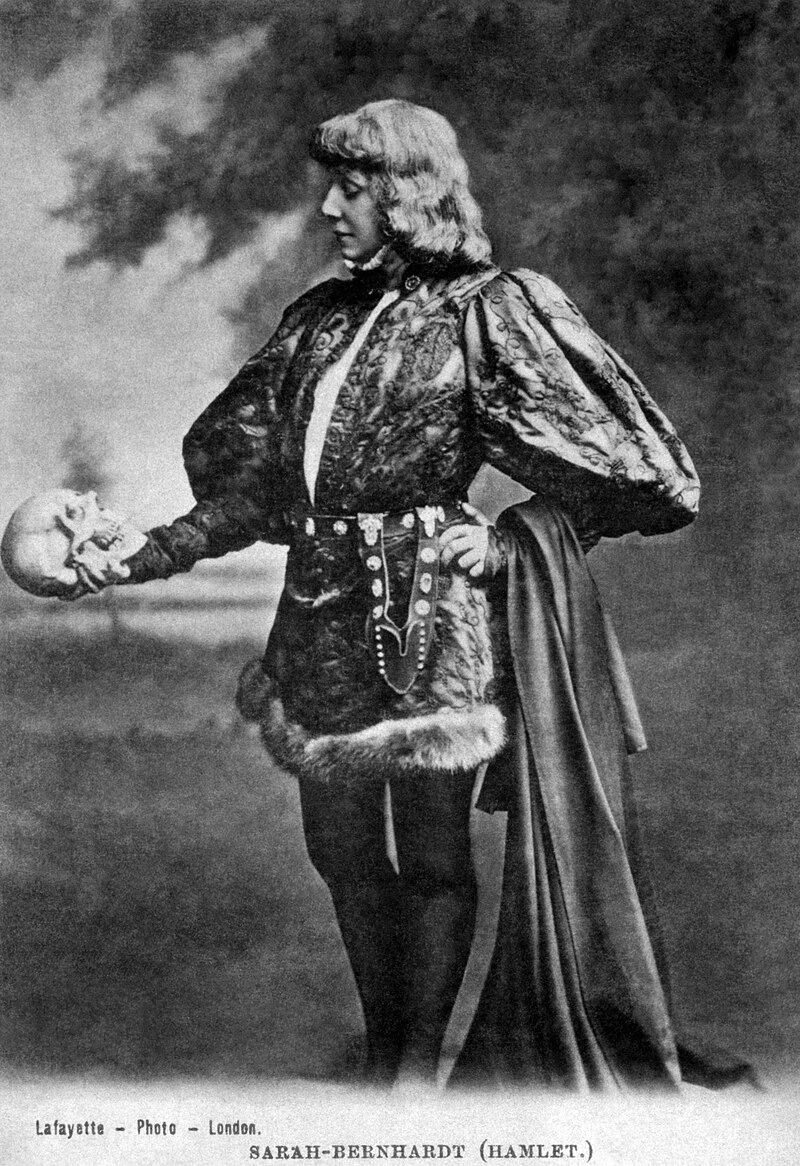 Sarah Bernhardt as Hamlet, with Yorick's skull (photographer: James Lafayette, c. 1885–1900) The first Hamlet in color was a 1969 film directed by Tony Richardson with Nicol Williamson as Hamlet and Marianne Faithfull as Ophelia. In 1990 Franco Zeffirelli, whose Shakespeare films have been described as "sensual rather than cerebral",[257] cast Mel Gibson—then famous for the Mad Max and Lethal Weapon movies—in the title role of his 1990 version; Glenn Close—then famous as the psychotic "other woman" in Fatal Attraction—played Gertrude, and Paul Scofield played Hamlet's father.[258] Kenneth Branagh adapted, directed, and starred in a 1996 film version of Hamlet that contained material from the First Folio and the Second Quarto. Branagh's Hamlet was the first unabridged theatrical film adaptation of the play and has a runtime of 242 minutes (just over four hours).[259][260] Branagh set the film with late 19th-century costuming and furnishings, a production in many ways reminiscent of a Russian novel of the time,[261] and Blenheim Palace, built in the early 18th century, became Elsinore Castle in the external scenes. The film is structured as an epic and makes frequent use of flashbacks to highlight elements not made explicit in the play: Hamlet's sexual relationship with Kate Winslet's Ophelia, for example, or his childhood affection for Yorick (played by Ken Dodd).[262] In 2000, Michael Almereyda's Hamlet set the story in contemporary Manhattan, with Ethan Hawke playing Hamlet as a film student. Claudius (played by Kyle MacLachlan) became the CEO of "Denmark Corporation", having taken over the company by killing his brother.[263] The 2014 Bollywood film Haider is an adaptation set in modern Kashmir.[264] |
映画とテレビ出演 主な記事 映画『ハムレット 以下も参照のこと: ハムレット』への文化的言及 ハムレット』の初期の映画版は、1900年にサラ・ベルナールがフェンシングのシーンを5分間撮影したものである[250]。このフィルムは音とフィルム を組み合わせた初期の試みであり、音楽と言葉は蓄音機のレコードに録音され、フィルムと一緒に再生された[251]。サイレント版は1907年、1908 年、1910年、1913年、1917年、1920年に公開された[252]。 ローレンス・オリヴィエが1948年に監督したモノクロームの不機嫌な『ハムレット』は、アカデミー作品賞と主演男優賞を受賞し、2024年現在、シェイ クスピア映画で唯一受賞している。彼の解釈は戯曲のエディプスの含みを強調し、ハムレットの母親役には28歳のアイリーン・ハーリーを配し、41歳のハム レットを演じた彼自身と対峙させた[253]。 1953年、俳優のジャック・マニングは、デュモントの短命の深夜番組『モノドラマ・シアター』シリーズで、2週間にわたってこの戯曲を15分ずつ上演し た。ニューヨーク・タイムズ紙のテレビ批評家ジャック・グールドは、ハムレットを演じたマニングの演技を賞賛した[254]。 1964年のソビエト映画『ハムレット』(ロシア語: Гамлет)は、ボリス・パステルナークの翻訳に基づき、グリゴリ・コジンツェフが監督、ドミトリ・ショスタコーヴィチが音楽を担当した[255]。 1964年から65年にかけて、ジョン・ギールグッドがリチャード・バートンを演出し、ラント・フォンタンヌ劇場でブロードウェイ公演を行った。このプロ ダクションのライヴ・フィルムは、複数のビデオカメラでライヴ・パフォーマンスを録画し、その映像をフィルムに変換する方法である「エレクトロノヴィジョ ン」を使って制作された[256]。アイリーン・ハーリーが女王役でオリヴィエの映画版と同じ役を演じ、幽霊役でギールグッドの声が聞けた。ギールグッド /バートンのプロダクションは、コロンビア・マスターワークスからLPでリリースされた。  ハムレット役のサラ・ベルナールとヨリックの頭蓋骨(撮影者:ジェームズ・ラファイエット、1885~1900年頃) 1969年、トニー・リチャードソンが監督し、ハムレット役をニコル・ウィリアムソン、オフィーリア役をマリアンヌ・フェイスフルが演じた。 1990年、フランコ・ゼフィレッリは、そのシェイクスピア映画を「頭脳的というより官能的」と評し[257]、1990年版のタイトルロールに当時映画 『マッドマックス』や『リーサル・ウェポン』で有名だったメル・ギブソンを起用し、当時『フェイタル・アトラクション』のサイコな「もうひとりの女」とし て有名だったグレン・クローズがガートルードを演じ、ポール・スコフィールドがハムレットの父親を演じた[258]。 ケネス・ブラナーは、1996年の映画版『ハムレット』の脚色、監督、主演を務め、ファースト・フォリオとセカンド・クオートからの素材を盛り込んだ。ブ ラナーの『ハムレット』は、この戯曲の初の劇場映画化であり、上映時間は242分(4時間強)である[259][260]。ブラナーはこの映画を19世紀 末の衣装と調度品で設定し、当時のロシアの小説を彷彿とさせる演出を行った[261]。18世紀初頭に建てられたブレナム宮殿は、外部のシーンではエルシ ノア城となった。映画は叙事詩として構成され、戯曲では明示されていない要素を強調するためにフラッシュバックが頻繁に使われる: 例えば、ハムレットとケイト・ウィンスレット演じるオフィーリアとの性的関係や、ケン・ドッド演じるヨリックへの幼少期の愛情などである[262]。 2000年、マイケル・アルメレイダ監督の『ハムレット』は、現代のマンハッタンを舞台に、イーサン・ホークが映画学生としてハムレットを演じた。カイ ル・マクラクラン演じるクローディアスは、兄を殺して会社を乗っ取り、「デンマーク・コーポレーション」のCEOとなった[263]。 2014年のボリウッド映画『Haider』は、現代のカシミールを舞台にした映画化作品である[264]。 |
Derivative works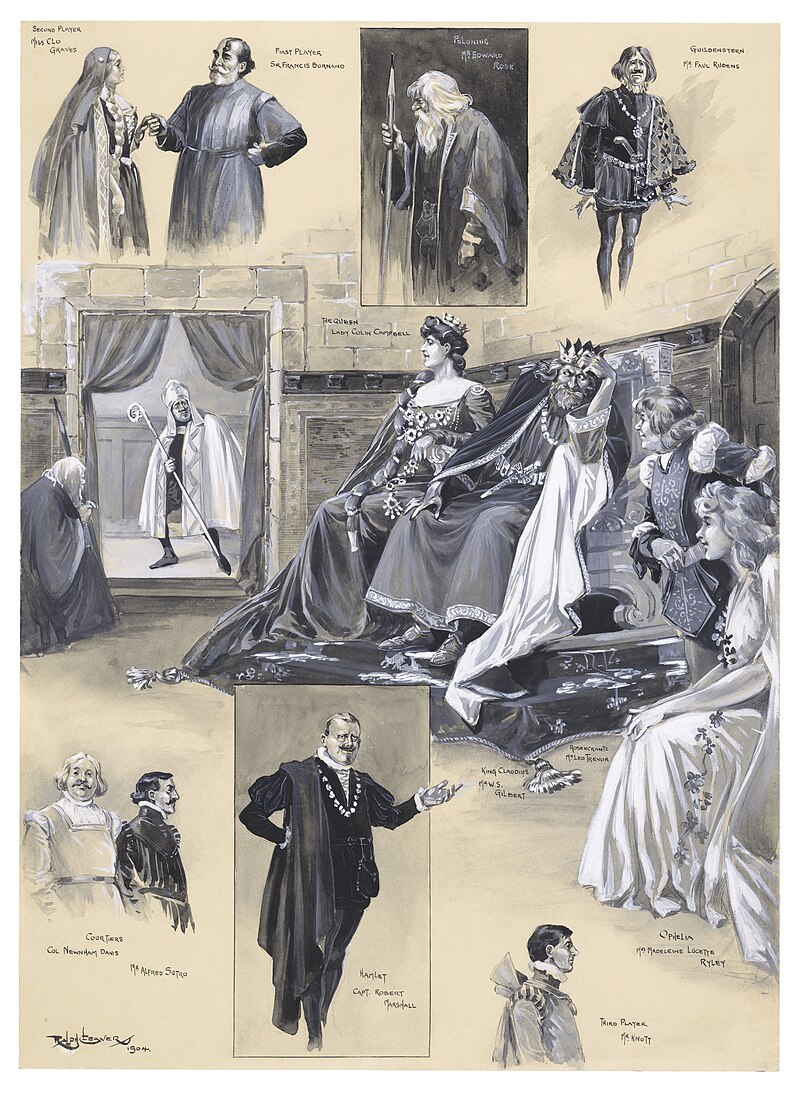 Scenes from a 1904 benefit performance of W. S. Gilbert's Rosencrantz and Guildenstern, with Gilbert as Claudius This section is limited to derivative works written for the stage. Tom Stoppard's 1966 play Rosencrantz and Guildenstern Are Dead retells many of the events of the story from the point of view of the characters Rosencrantz and Guildenstern and gives them a backstory of their own. Several times since 1995, the American Shakespeare Center has mounted repertories that included both Hamlet and Rosencrantz and Guildenstern, with the same actors performing the same roles in each.[265] W. S. Gilbert wrote a short comic play titled Rosencrantz and Guildenstern, in which Hamlet's play is presented as a tragedy written by Claudius in his youth of which he is greatly embarrassed. Through the chaos triggered by Hamlet's staging of it, Guildenstern helps Rosencrantz vie with Hamlet to make Ophelia his bride.[266] Lee Blessing's Fortinbras is a comical sequel to Hamlet in which all the deceased characters come back as ghosts. The New York Times said it is "scarcely more than an extended comedy sketch, lacking the portent and linguistic complexity of Tom Stoppard's Rosencrantz and Guildenstern Are Dead. Fortinbras operates on a far less ambitious plane, but it is a ripping yarn and offers Keith Reddin a role in which he can commit comic mayhem".[267] Caridad Svich's 12 Ophelias (a play with broken songs) includes elements of the story of Hamlet but focuses on Ophelia. In Svich's play, Ophelia is resurrected and rises from a pool of water, after her death in Hamlet. The play is a series of scenes and songs, and was first staged at a public swimming pool in Brooklyn.[268] David Davalos's Wittenberg is a "tragical-comical-historical" prequel to Hamlet that depicts the Danish prince as a student at Wittenberg University (now known as the University of Halle-Wittenberg), where he is torn between the conflicting teachings of his mentors John Faustus and Martin Luther. The New York Times reviewed the play, saying, "Mr. Davalos has molded a daft campus comedy out of this unlikely convergence",[269] and Nytheatre.com's review said the playwright "has imagined a fascinating alternate reality, and quite possibly, given the fictional Hamlet a back story that will inform the role for the future."[270] Mad Boy Chronicle by Canadian playwright Michael O'Brien is a dark comedy loosely based on Hamlet, set in Viking Denmark in 999 AD.[271] |
派生作品 1904年に上演されたW.S.ギルバートの『ローゼンクランツとギルデンスターン』(ギルバート扮するクローディアス)の上演風景。 このセクションでは、舞台用に書かれた派生作品に限定する。 トム・ストッパードの1966年の戯曲『ローゼンクランツとギルデンスターンは死んだ』は、登場人物のローゼンクランツとギルデンスターンの視点から物語 の出来事の多くを再構成し、彼ら自身のバックストーリーを与えている。1995年以降、アメリカン・シェイクスピア・センターは、『ハムレット』と『ロー ゼンクランツとギルデンスターン』の両方を含むレパートリーを何度か上演しており、同じ俳優がそれぞれ同じ役を演じている[265]。 W. S.ギルバートは『ローゼンクランツとギルデンスターン』という短いコミカルな戯曲を書いた。ギルデンスターンは、ハムレットがその戯曲を上演したことに よって引き起こされた混乱を通して、ローゼンクランツがオフィーリアを自分の花嫁にするためにハムレットと争うのを助ける[266]。 リー・ブレッシングの『フォーティンブラス』は、『ハムレット』のコミカルな続編であり、亡くなった登場人物全員が幽霊として蘇る。ニューヨーク・タイム ズ』紙は、この作品を「コメディ・スケッチの延長に過ぎず、トム・ストッパードの『ローゼンクランツとギルデンスターンは死んだ』のような含蓄と言語的な 複雑さはない」と評している。フォーティンブラス』は野心的な面でははるかに劣るが、破裂しそうな毛糸であり、キース・レディンにコミカルな大騒動を巻き 起こす役を与えている」と評している[267]。 カリダッド・スヴィッチの『12人のオフィーリア』(歌割れの戯曲)は、『ハムレット』の物語の要素を含むが、オフィーリアに焦点を当てた作品である。ス ヴィッチの戯曲では、オフィーリアは『ハムレット』で死んだ後、復活し、水たまりからよみがえる。この戯曲は一連のシーンと歌で構成され、ブルックリンの 市民プールで初演された[268]。 デイヴィッド・ダヴァロスの『ヴィッテンベルク』は、『ハムレット』の前日譚で、デンマークの王子がヴィッテンベルク大学(現在のハレ・ヴィッテンベルク 大学)の学生として、師であるヨハネ・ファウストゥスとマルティン・ルターの相反する教えの間で葛藤する姿を描いた「悲劇的・コミカル・歴史的」な作品で ある。ニューヨーク・タイムズ紙の劇評では、「ダヴァロス氏は、このありそうもない収束から、おどけたキャンパス・コメディを作り上げた」と評され [269]、Nytheatre.comの劇評では、「魅力的な別の現実を想像し、そしておそらくは、架空のハムレットに、将来の役作りに役立つバックス トーリーを与えた」と評されている[270]。 カナダの劇作家マイケル・オブライエンによる『マッドボーイ・クロニクル』は、西暦999年のバイキング・デンマークを舞台にした、ハムレットをゆるくベースにしたダークコメディである[271]。 |
| List of idioms attributed to Shakespeare | シェークスピアに起因する慣用句のリスト |
| Sources Editions of Hamlet Barnet, Sylvan, ed. (1998). Hamlet. Signet Classics. ISBN 978-0451526922. Bate, Jonathan; Rasmussen, Eric, eds. (2007). Complete Works. The RSC Shakespeare. New York: Royal Shakespeare Company. ISBN 978-0-679-64295-4. Bate, Jonathan; Rasmussen, Eric, eds. (2008). Hamlet. The RSC Shakespeare. The Royal Shakespeare Company. ISBN 978-0-230-21786-7. Edwards, Phillip, ed. (1985). Hamlet, Prince of Denmark. New Cambridge Shakespeare. Cambridge: Cambridge University Press. ISBN 978-0-521-29366-2. Evans, G. Blakemore, ed. (1974). The Riverside Shakespeare. The Riverside Shakespeare. Houghton Mifflin for Riverside Shakespeare Company. ISBN 978-0-395-04402-5. Hibbard, G. R., ed. (1987). Hamlet. Oxford World's Classics. Oxford: Oxford University Press. ISBN 0-19-283416-9. Irace, Kathleen O., ed. (1998). The First Quarto of Hamlet. New Cambridge Shakespeare. Cambridge: Cambridge University Press. ISBN 0-521-65390-8. Jenkins, Harold, ed. (1982). Hamlet. Arden Shakespeare, second series. London: Methuen. ISBN 1-903436-67-2. Lott, Bernard, ed. (1970). Hamlet. New Swan Shakespeare, Advanced series (New ed.). London: Longman. ISBN 0-582-52742-2. Thompson, Ann; Taylor, Neil, eds. (2006). Hamlet. Arden Shakespeare, third series. Vol. 1. London: Cengage Learning. ISBN 1-904271-33-2. Thompson, Ann; Taylor, Neil, eds. (2006). Hamlet: The Texts of 1603 and 1623. Arden Shakespeare, third series. Vol. 2. London: Cengage Learning. ISBN 1-904271-80-4. Wells, Stanley; Taylor, Gary, eds. (1988). The Complete Works. The Oxford Shakespeare (Compact ed.). Oxford: Clarendon Press. ISBN 0-19-871190-5. Weiner, Albert B., ed. (1962). William Shakespeare, Hamlet; The First Quarto 1603. Barrons Educational Series. Secondary sources Banham, Martin, ed. (1998). The Cambridge Guide to Theatre. Cambridge Guides. Cambridge: Cambridge University Press. ISBN 0-521-43437-8. Barratt, Mark (2005). Ian Mckellen: An Unofficial Biography. Virgin Books. ISBN 978-1-85227-251-7. Benedetti, Jean (1999) [1988]. Stanislavski: His Life and Art (Revised ed.). London: Methuen. ISBN 0-413-52520-1. Billington, Michael (4 May 2001). "Hamlet – Royal Shakespeare Theatre, Stratford Upon Avon". Theatre. The Guardian. London. Billington, Michael (6 August 2008). "Hamlet – Courtyard, Stratford-upon-Avon". Theatre. The Guardian. London. Bloom, Harold (1994). The Western Canon. New York: Harcourt Brace. ISBN 978-1-57322-514-4. Bloom, Harold (2003). Hamlet: Poem Unlimited. Edinburgh: Canongate. ISBN 1-84195-461-6. Bloom, Harold; Foster, Brett, eds. (2008). Hamlet. Bloom's Shakespeare through the ages. Bloom's Literary Criticism. ISBN 978-0-7910-9592-8. Blum, Daniel C. (1981). A Pictorial History of the American Theatre, 1860–1980 (5th ed.). Crown Publishers. ISBN 978-0-517-54262-0. Brandes, Philip (5 July 2001). "A Viking Helmet for Hamlet in Satirical Mad Boy Chronicle". Los Angeles Times. Retrieved 20 December 2017. Braun, Edward (1982). The Director and the Stage: From Naturalism to Grotowski. London: Methuen. ISBN 978-0-413-46300-5. Britton, Celia (1995). "Structuralist and poststructuralist psychoanalytic and Marxist theories". In Seldon, Raman (ed.). From Formalism to Poststructuralism. Cambridge History of Literary Criticism. Vol. 8. Cambridge: Cambridge University Press. ISBN 978-0-521-30013-1. Brode, Douglas (2001). Shakespeare in the Movies: From the Silent Era to Today. New York: Berkley Boulevard Books. ISBN 0-425-18176-6. "Cook, Eyre, Lee And More Join Jude Law In Grandage's Hamlet". Broadwayworld. 4 February 2009. Retrieved 18 February 2009. Brown, Mark (1 April 2016). "Sherlock star Andrew Scott to play Hamlet in new UK production". Theatre. The Guardian. London. Retrieved 22 July 2016. Brown, Mark (11 April 2018). "Shakespeare's Globe casts its own artistic director as Hamlet". Theatre. The Guardian. London. Budd, Susan (2005). Rusbridger, Richard (ed.). Introducing Psychoanalysis: Essential Themes and Topics. Routledge. ISBN 978-1-135-44570-6. Burian, Jarka (2004) [1993]. "Hamlet in Postwar Czech Theatre". In Kennedy, Dennis (ed.). Foreign Shakespeare: Contemporary Performance (New ed.). Cambridge: Cambridge University Press. ISBN 0-521-61708-1. Burnett, Mark Thornton (2003). "'To Hear and See the Matter': Communicating Technology in Michael Almereyda's Hamlet (2000)". Cinema Journal. 42 (3): 48–69. doi:10.1353/cj.2003.0007. ISSN 1527-2087. JSTOR 1225904. S2CID 191444329. Burrow, Colin (19 May 2002). "Will the real Hamlet please stand up?". The Times. p. 6 – via InfoTrac Newsstand. Calia, Michael (11 August 2014). "Benedict Cumberbatch as 'Hamlet' Opens Next Year, And Is Now Sold Out". Speakeasy. The Wall Street Journal. Canby, Vincent (3 May 1995). "Ralph Fiennes as Mod Hamlet". The New York Times. Retrieved 21 July 2016. Cairncross, Andrew S. (1975) [1936]. The Problem of Hamlet: A Solution (Reprint ed.). Norwood, PA: Norwood Editions. ISBN 0-88305-130-3. Cartmell, Deborah. "Franco Zeffirelli and Shakespeare". In Jackson (2000), pp. 212–221. Cecil, William (2012) [First published in 1916]. "Ten Precepts". In Craik, Henry (ed.). English Prose, Selections with Critical Introductions by Various Writers and General Introductions to Each Period; edited by Henry Craik (Online edition by Bartleby.com ed.). New York: The Macmillan Company. Chambers, E. K. (2009) [First published 1923]. The Elizabethan Stage. Vol. 3. New York: Oxford University Press. ISBN 978-0-19-956750-8. Chambers, E. K. (1930). William Shakespeare: A Study of Facts and Problems. Oxford: Clarendon Press. ISBN 0-19-811774-4. Cotsell, Michael (2005). The Theater of Trauma: American modernist drama and the psychological struggle for the American Mind. New York: Peter Lang. ISBN 978-0-8204-7466-3. Crowl, Samuel. "Flamboyant Realist: Kenneth Branagh". In Jackson (2000), pp. 222–240. Crowl, Samuel (2014). Shakespeare's Hamlet: The Relationship Between Text and Film. Screen Adaptations. Arden Shakespeare. ISBN 978-1-4725-3893-2. "Jude Law to play Hamlet at 'home' Kronborg Castle". The Daily Mirror. 10 July 2009. Retrieved 14 July 2009. Davies, Anthony. "The Shakespeare films of Laurence Olivier". In Jackson (2000), pp. 163–182. Davison, Richard Allan (1999). "The Readiness Was All: Ian Charleson and Richard Eyre's Hamlet". In Potter, Lois; Kinney, Arthur F. (eds.). Shakespeare, Text and Theater: Essays in Honor of Jay L. Halio. Newark: University of Delaware Press. ISBN 978-0-87413-699-9. Dawson, Anthony B. "International Shakespeare". In Wells & Stanton (2002), pp. 174–193. Duncan-Jones, Catherine (2001). Ungentle Shakespeare: scenes from his life. London: Arden Shakespeare. ISBN 1-903436-26-5. Fine, Marshall (10 April 2013). "Paul Giamatti in Hamlet". Onstage. The Huffington Post. Retrieved 11 July 2015. Fox, Margalit (18 September 2009). "Jack Manning, Character Actor, Dies at 93". Theater. The New York Times. Retrieved 14 September 2013. Freud, Sigmond; Bunker, Henry Alden (1960). "Psychopathic Characters on the Stage". The Tulane Drama Review. 4 (3). The MIT Press: 144–148. doi:10.2307/1124852. ISSN 0886-800X. JSTOR 1124852. S2CID 149658226. Freud, Sigmund (1991) [1900]. Richards, Angela (ed.). The Interpretation of Dreams. The Penguin Freud Library. Vol. 4. Translated by Strachey, James. London: Penguin. ISBN 0-14-013794-7. Freud, Sigmund (1995) [1900]. Brill, A. A. (ed.). The Basic Writings of Sigmund Freud. Translated by Brill, A. A. New York: The Modern Library. ISBN 978-0-679-60166-1. Gardner, Lyn (8 November 2002). "Hamlet – West Yorkshire Playhouse, Leeds". Theatre. The Guardian. London. Gay, Penny. "Women and Shakespearean Performance". In Wells & Stanton (2002), pp. 155–173. Gilbert, W. S. (1892). "Rosencrantz and Guildenstern". Foggerty's Fairy: and other tales. London: George Routledge & Sons. Retrieved 27 June 2016. Gillies, John; Minami, Ryuta; Li, Ruru; Trivedi, Poonam. "Shakespeare on the Stages of Asia". In Wells & Stanton (2002), pp. 259–283. "About the Project". Globe to Globe Hamlet. Shakespeare's Globe. n.d. Archived from the original on 8 July 2016. Retrieved 25 July 2020. de Grazia, Margreta (2007). Hamlet without Hamlet. Cambridge: Cambridge University Press. ISBN 978-0-521-69036-2. Greenblatt, Stephen (2004a). Will in the World: How Shakespeare Became Shakespeare. New York: W. W. Norton & Company. ISBN 0-393-05057-2. Greenblatt, Stephen (21 October 2004). "The Death of Hamnet and the Making of Hamlet". The New York Review of Books. Vol. 51, no. 16. Grode, Eric (30 March 2011). "Dueling Mentors Bedevil a Dithering Young Dane". Theater Reviews. The New York Times. Retrieved 10 December 2011. Guernsey, Otis L.; Sweet, Jeffrey, eds. (2000). The Applause/Best Plays Theater Yearbook 1991–1992. Illustrated by Al Hirschfeld (illustrated ed.). Hal Leonard. ISBN 978-1-55783-147-7. Guntner, J. Lawrence. "Hamlet, Macbeth and King Lear on film". In Jackson (2000), pp. 117–134. Gupta, Priya (7 February 2014). "Bollywood returns to their favourite destination Kashmir". The Times of India. Retrieved 10 February 2018. Gussow, Mel (3 April 1992). "A High-Keyed Hamlet Starring Stephen Lang". The New York Times. Retrieved 13 July 2016. Gussow, Mel (14 October 1992). "Theater in Review". Theater. The New York Times. Retrieved 26 June 2011. Halliday, F. E. (1969) [first ed. 1964]. A Shakespeare Companion 1564–1964. Shakespeare Library. Baltimore: Penguin. ISBN 0-14-053011-8. Hattaway, Michael (1982). Elizabethan Popular Theatre: Plays in Performance. Theatre Production. London and Boston: Routledge & Kegan Paul. ISBN 0-7100-9052-8. Hattaway, Michael (1987). Hamlet. The Critics Debate. Basingstoke, Hampshire: Macmillan. ISBN 0-333-38524-1. Heilbrun, Carolyn (1957). "The Character of Hamlet's Mother". Shakespeare Quarterly. 8 (2): 201–206. doi:10.2307/2866964. eISSN 1538-3555. ISSN 0037-3222. JSTOR 2866964. Hirrel, Michael J. (2010). "Duration of Performances and Lengths of Plays: How Shall We Beguile the Lazy Time?". Shakespeare Quarterly. 61 (2). Folger Shakespeare Library: 159–182. doi:10.1353/shq.0.0140. eISSN 1538-3555. ISSN 0037-3222. JSTOR 40731154. S2CID 191661049. Holland, Peter. "Touring Shakespeare". In Wells & Stanton (2002), pp. 194–211. Holland, Peter (2007). "Shakespeare Abbreviated". In Shaughnessy, Robert (ed.). The Cambridge Companion to Shakespeare and Popular Culture. Cambridge Companions to Literature. Cambridge: Cambridge University Press. ISBN 978-0-521-60580-9. Hortmann, Wilhelm. "Shakespeare on the Political Stage in the Twentieth Century". In Wells & Stanton (2002), pp. 212–229. Howard, Jean E. (2003). "Feminist Criticism". In Wells, Stanley; Orlin, Lena (eds.). Shakespeare: An Oxford Guide. Oxford Guides. Oxford: Oxford University Press. ISBN 0-19-924522-3. Innes, Christopher (1983). Edward Gordon Craig. Directors in Perspective. Cambridge: Cambridge University Press. ISBN 0-521-27383-8. Isherwood, Charles (26 March 1995). "Middle-Aged, Yet a Prince, Slouching but Haunted". The New York Times. Itzkoff, Dave (30 June 2009). "Donmar Warehouse's Hamlet Coming to Broadway With Jude Law". ArtsBeat. The New York Times. Retrieved 10 September 2009. Jackson, MacDonald (1986). "The Transmission of Shakespeare's Text". In Wells, Stanley (ed.). The Cambridge Companion to Shakespeare Studies. Cambridge Companions to Literature. Cambridge: Cambridge University Press. pp. 163–185. ISBN 0-521-31841-6. Jackson, Russell, ed. (2000). The Cambridge Companion to Shakespeare on Film. Cambridge Companions to Literature. Cambridge: Cambridge University Press. ISBN 0-521-63975-1. Jones, Ernest (1910). "The Œdipus-Complex as an Explanation of Hamlet's Mystery: A Study in Motive". American Journal of Psychology. 21 (1). University of Illinois Press: 72–113. doi:10.2307/1412950. eISSN 1939-8298. ISSN 0002-9556. JSTOR 1412950. S2CID 46623868. Kellaway, Kate (25 June 2017). "Hamlet review – an all-consuming marvel – 5 out of 5 stars". The Guardian. Retrieved 4 November 2020. Kerrigan, John (1996). Revenge Tragedy: Aeschylus to Armageddon. Oxford: Clarendon Press. ISBN 978-0-19-159172-3. Keyishian, Harry. "Shakespeare and Movie Genre: The Case of Hamlet". In Jackson (2000), pp. 72–84. Kiernan, Pauline (2007). Filthy Shakespeare: Shakespeare's Most Outrageous Sexual Puns (revised ed.). Quercus. ISBN 978-1-84724-073-6. Kirsch, Arthur C. (1969). "A Caroline Commentary on the Drama". Modern Philology. 66 (3). The University of Chicago Press: 256–261. doi:10.1086/390087. eISSN 1545-6951. ISSN 0026-8232. JSTOR 436454. S2CID 162049086. Kliman, Bernice W. (Summer 2011). "At Sea about Hamlet at Sea: A Detective Story". Shakespeare Quarterly. 62 (2): 180–204. doi:10.1353/shq.2011.0025. ISSN 0037-3222. JSTOR 23025627. S2CID 192187966. Knowles, Ronald (1999). "Hamlet and Counter-Humanism". Renaissance Quarterly. 52 (4). Renaissance Society of America: 1046–1069. doi:10.2307/2901835. eISSN 1935-0236. JSTOR 2901835. S2CID 170767175. Law, Jude (2 October 2009). "Shakespeare's Hamlet with Jude Law". Charlie Rose (Interview). Interviewed by Charlie Rose. PBS. Retrieved 6 October 2009. MacCary, W. Thomas (1998). "Hamlet": A Guide to the Play. Greenwood Guides to Shakespeare. Westport, Connecticut: Greenwood Press. ISBN 0-313-30082-8. Marsden, Jean I. "Improving Shakespeare: from the Restoration to Garrick". In Wells & Stanton (2002), pp. 21–36. McKellen, Ian; Puttnam, David; Wax, Ruby; Redgrave, Vanessa; Bates, Alan (1990). For Ian Charleson: A Tribute. London: Constable and Company. ISBN 978-0-09-470250-9. Moody, Jane. "Romantic Shakespeare". In Wells & Stanton (2002), pp. 37–57. Morrison, Michael A. "Shakespeare in North America". In Wells & Stanton (2002), pp. 230–258. Morrison, Michael A. (1997). John Barrymore, Shakespearean Actor. Cambridge: Cambridge University Press. ISBN 0-521-62028-7. "Hamlet 1963". Royal National Theatre. n.d. Archived from the original on 11 August 2010. Retrieved 21 July 2016. Novy, Marianne L. (1994). Engaging with Shakespeare: Responses of George Eliot and Other Women Novelists. Athens, Georgia: University of Georgia Press. ISBN 978-0-8203-1596-6. O'Connor, Marion. "Reconstructive Shakespeare: Reproducing Elizabethan and Jacobean Stages". In Wells & Stanton (2002), pp. 76–97. Osborne, Laurie (2007). "Narration and Staging in Hamlet and its afternovels". In Shaughnessy, Robert (ed.). The Cambridge Companion to Shakespeare and Popular Culture. Cambridge Companions to Literature. Cambridge: Cambridge University Press. pp. 114–133. ISBN 978-0-521-60580-9. Pitcher, John; Woudhuysen, Henry (1969). Shakespeare Companion, 1564–1964. London: Penguin. ISBN 0-14-053011-8. Rosenberg, Marvin (1992). The Masks of Hamlet. London: Associated University Presses. ISBN 0-87413-480-3. Rothman, Joshua (14 August 2013). "Hamlet: A Love Story". The New Yorker. Retrieved 20 July 2016. Rowse, A. L. (1995) [1963]. William Shakespeare: A Biography. New York: Barnes & Noble Books. ISBN 1-56619-804-6. Sams, Eric (1995). The Real Shakespeare; Retrieving the Early Years, 1564-1594. Yale University Press. ISBN 978-0300072822. Saxo Grammaticus (1983). Hansen, William (ed.). Saxo Grammaticus and the Life of Hamlet: A Translation, History, and Commentary. Lincoln: University of Nebraska Press. ISBN 0-8032-2318-8. Schoch, Richard W. "Pictorial Shakespeare". In Wells & Stanton (2002), pp. 58–75. Schultz, David G. (16 July 2008). "A Play at Poolside: Caridad Svich's 12 Ophelias". The Brooklyn Rail. Retrieved 26 June 2011. Shapiro, James (2005). 1599: A Year in the Life of William Shakespeare. London: Faber. ISBN 0-571-21481-9. Shaw, George Bernard (1961). Wilson, Edwin (ed.). Shaw on Shakespeare. New York: Applause. ISBN 1-55783-561-6. Shenton, Mark (10 September 2007). "Jude Law to star in Donmar's Hamlet". The Stage. Retrieved 19 November 2007. Showalter, Elaine (1985). "Representing Ophelia: Women, Madness, and the Responsibilities of Feminist Criticism". In Parker, Patricia; Hartman, Geoffrey (eds.). Shakespeare and the Question of Theory. New York and London: Methuen. pp. 77–94. ISBN 0-416-36930-8. Small, Alan (19 April 2019). "International Magazine Recalls Reeves' Reign As Hamlet". Winnipeg Free Press. Retrieved 26 November 2022. Smallwood, Robert. "Twentieth-century Performance: The Stratford and London Companies". In Wells & Stanton (2002), pp. 98–117. Spencer, Charles (10 November 2011). "Hamlet, The Young Vic Theatre: review". The Daily Telegraph. Archived from the original on 10 January 2022. Retrieved 18 March 2019. Starks, Lisa S. (1999). "The Displaced Body of Desire: Sexuality in Kenneth Branagh's Hamlet". In Desmet, Christy; Sawyer, Robert (eds.). Shakespeare and Appropriation. Accents on Shakespeare. London: Routledge. pp. 160–178. ISBN 0-415-20725-8. Stewart, Rachel (11 August 2014). "Cumberbatch's Hamlet most in-demand show of all time". The Daily Telegraph. London. Sulcas, Roslyn (1 August 2017). "Kenneth Branagh to Direct Tom Hiddleston in Hamlet". Theater. The New York Times. Retrieved 21 December 2017. Tanitch, Robert (1985). Olivier: The complete career. Abbeville Press. ISBN 978-0-89659-590-3. Taxidou, Olga (1998). The Mask: A Periodical Performance by Edward Gordon Craig. Contemporary Theatre Studies. Vol. 30. Amsterdam: Harwood Academic Publishers. ISBN 90-5755-046-6. Taylor, Gary (1989). Reinventing Shakespeare: A Cultural History from the Restoration to the Present. London: Hogarth Press. ISBN 0-7012-0888-0. Taylor, Gary. "Shakespeare Plays on Renaissance Stages". In Wells & Stanton (2002). Thompson, Ann (2001). Alexander, Catherine M.S.; Wells, Stanley (eds.). Shakespeare and Sexuality. Cambridge: Cambridge University Press. pp. 1–13. ISBN 0-521-80475-2. Thompson, Ann; Taylor, Neil (1996). William Shakespeare, "Hamlet". Plymouth, UK: Northcote House, in association with the British Council. ISBN 978-0-74630-765-6. OCLC 954440601. Thomson, Peter (1983). Shakespeare's Theatre. Theatre Production. London and Boston: Routledge and Kegan Paul. ISBN 0-7100-9480-9. Todoroff, Aimee (19 March 2011). "Wittenberg". Nytheatre.com. Archived from the original on 23 October 2017. Retrieved 23 October 2017. Trilling, Lionel (2009). Sincerity and Authenticity. The Charles Eliot Norton Lectures. Harvard University Press. ISBN 978-0-674-50419-6. Uglow, Jenny (2002) [1977]. Hogarth: A Life and a World (New ed.). London: Faber and Faber. ISBN 0-571-19376-5. Vickers, Brian, ed. (1995a) [1974]. Shakespeare: The Critical Heritage (1623–1692). Vol. 1 (New ed.). London: Routledge. ISBN 0-415-13404-8. Vickers, Brian, ed. (1995b) [1974]. Shakespeare: The Critical Heritage (1753–1765). Vol. 4 (New ed.). London: Routledge. ISBN 0-415-13407-2. Vickers, Brian, ed. (1995c) [1974]. Shakespeare: The Critical Heritage (1765–1774). Vol. 5 (New ed.). London: Routledge. ISBN 0-415-13408-0. Warren, Christopher N. (2016). "Big Leagues: Specters of Milton and Republican International Justice between Shakespeare and Marx". Humanity. 7 (3). University of Pennsylvania Press: 365–389. doi:10.1353/hum.2016.0020. ISSN 2151-4372. S2CID 159721222. Warren, Jim (n.d.). "Every Exit is an Entrance Someplace Else". Director's Notes. American Shakespeare Center. Archived from the original on 22 December 2015. Retrieved 20 June 2009. Wells, Stanley; Stanton, Sarah, eds. (2002). The Cambridge Companion to Shakespeare on Stage. Cambridge Companions to Literature. Cambridge: Cambridge University Press. ISBN 0-521-79711-X. Welsh, Alexander (2001). Hamlet in his Modern Guises. Princeton University Press. ISBN 978-0-691-05093-5. Wild, Stephi (1 September 2022). "Billy Howle Joined by Niamh Cusack and Mirren Mack in Hamlet at Bristol Old Vic; Full Cast Announced". BroadwayWorld. Wilson, J. Dover (1932). The Essential Shakespeare: A Biographical Adventure. Cambridge: Cambridge University Press. ISBN 9780521068277. Winstanley, Lilian (1977) [1921]. Hamlet and the Scottish succession, Being an Examination of the Relations of the Play of Hamlet to the Scottish Succession and the Essex Conspiracy. Philadelphia: R. West. ISBN 0-8492-2912-X. Winter, William (26 October 1875). "Fifth Avenue Theater – Edwin Booth as Hamlet". The Drama. New-York Tribune. p. 5. ISSN 1941-0646. LCCN sn83030214. OCLC 9405688. Wofford, Susanne L. (1994). "A Critical History of Hamlet". Hamlet: Complete, Authoritative Text with Biographical and Historical Contexts, Critical History, and Essays from Five Contemporary Critical Perspectives. Boston: Bedford Books. pp. 181–207. ISBN 0-312-08986-4. Zhuk, Nataliia (2 September 2017). "Tom Hiddleston in Hamlet review: A Supremely Self-Assured Prince – Rada's Jerwood Vanbrugh Theatre". The Telegraph. ISSN 0307-1235. Further reading Alexander, Peter (1964). Alexander's Introductions to Shakespeare. London: Collins. OCLC 257743100. Bloom, Harold (2001). Shakespeare: The Invention of the Human (Open Market ed.). Harlow, Essex: Longman. ISBN 1-57322-751-X. Brennan, Sandra (2015). "Innokenti Smoktunovsky". The New York Times. Archived from the original on 18 February 2015. Retrieved 29 May 2010. Chambers, E. K. (2009) [First published 1923]. The Elizabethan Stage. Vol. 1. New York: Oxford University Press. ISBN 978-0-19-956748-5. Crystal, David; Crystal, Ben (2005). The Shakespeare Miscellany. New York: Penguin. ISBN 0-14-051555-0. Jackson, MacDonald (1991). "The Year's Contributions to Shakespeare Studies: 3 – Editions and Textual Studies". In Wells, Stanley (ed.). The Tempest and After. Shakespeare Survey. Vol. 43. Cambridge University Press. pp. 255–270. ISBN 978-1-139-05320-4. Kermode, Frank (2000). Shakespeare's Language. London: Penguin. ISBN 0-14-028592-X. |
情報源 ハムレット』エディション バーネット、シルヴァン編 (1998). ハムレット. シグネット・クラシックス. ISBN 978-0451526922. ベイト、ジョナサン; ラスムッセン、エリック編 (2007). 全集. The RSC Shakespeare. ニューヨーク: ロイヤル・シェイクスピア・カンパニー. ISBN 978-0-679-64295-4. Bate, Jonathan; Rasmussen, Eric, eds. (2008). ハムレット. The RSC Shakespeare. ロイヤル・シェイクスピア・カンパニー. ISBN 978-0-230-21786-7. Edwards, Phillip, ed. (1985). Hamlet, Prince of Denmark. New Cambridge Shakespeare. Cambridge: Cambridge: Cambridge University Press. ISBN 978-0-521-29366-2. Evans, G. Blakemore, ed. (1974). The Riverside Shakespeare. The Riverside Shakespeare. Houghton Mifflin for Riverside Shakespeare Company. ISBN 978-0-395-04402-5. Hibbard, G. R., ed. (1987). ハムレット. Oxford World's Classics. オックスフォード: Oxford University Press. ISBN 0-19-283416-9. Irace, Kathleen O., ed. (1998). The First Quarto of Hamlet. New Cambridge Shakespeare. Cambridge: Cambridge University Press. ISBN 0-521-65390-8. Jenkins, Harold, ed. (1982). Hamlet. Arden Shakespeare, second series. London: Methuen. ISBN 1-903436-67-2. Lott, Bernard, ed. (1970). ハムレット. New Swan Shakespeare, Advanced series (New ed.). London: Longman. ISBN 0-582-52742-2. Thompson, Ann; Taylor, Neil, eds. (2006). Hamlet. Arden Shakespeare, third series. 第1巻。London: Cengage Learning. ISBN 1-904271-33-2. Thompson, Ann; Taylor, Neil, eds. (2006). Hamlet: The Texts of 1603 and 1623. Arden Shakespeare, third series. 第2巻: Cengage Learning. ISBN 1-904271-80-4. Wells, Stanley; Taylor, Gary, eds. (1988). The Complete Works. オックスフォード・シェイクスピア(コンパクト版). オックスフォード: Clarendon Press. ISBN 0-19-871190-5. Weiner, Albert B., ed. (1962). William Shakespeare, Hamlet; The First Quarto 1603. Barrons Educational Series. 二次資料 Banham, Martin, ed. (1998). The Cambridge Guide to Theatre. Cambridge Guides. ケンブリッジ: Cambridge University Press. ISBN 0-521-43437-8. Barratt, Mark (2005). Ian Mckellen: An Unofficial Biography. Virgin Books. ISBN 978-1-85227-251-7. Benedetti, Jean (1999) [1988]. Stanislavski: His Life and Art (Revised ed.). London: Methuen. ISBN 0-413-52520-1. Billington, Michael (4 May 2001). 「Hamlet - Royal Shakespeare Theatre, Stratford Upon Avon」. Theatre. The Guardian. ロンドン。 Billington, Michael (6 August 2008). 「Hamlet - Courtyard, Stratford-upon-Avon」. Theatre. The Guardian. ロンドン。 Bloom, Harold (1994). The Western Canon. New York: Harcourt Brace. ISBN 978-1-57322-514-4. Bloom, Harold (2003). Hamlet: Poem Unlimited. Edinburgh: Canongate. ISBN 1-84195-461-6. ブルーム、ハロルド; フォスター、ブレット編 (2008). Hamlet. Bloom's Shakespeare through the ages. Bloom's Shakespeare through the ages. ISBN 978-0-7910-9592-8. Blum, Daniel C. (1981). A Pictorial History of the American Theatre, 1860-1980 (5th ed.). Crown Publishers. ISBN 978-0-517-54262-0. Brandes, Philip (5 July 2001). 「A Viking Helmet for Hamlet in Satirical Mad Boy Chronicle」. Los Angeles Times. 2017年12月20日取得。 Braun, Edward (1982). 監督と舞台: From Naturalism to Grotowski. ロンドン: Methuen. ISBN 978-0-413-46300-5. Britton, Celia (1995). 「構造主義とポスト構造主義の精神分析とマルクス主義理論」. In Seldon, Raman (ed.). From Formalism to Poststructuralism. Cambridge History of Literary Criticism. 第8巻: Cambridge: Cambridge University Press. ISBN 978-0-521-30013-1. Brode, Douglas (2001). 映画の中のシェイクスピア: サイレント時代から今日まで。ニューヨーク: Berkley Boulevard Books. ISBN 0-425-18176-6. 「クック、エアー、リーらがグランデージのハムレットにジュード・ロウと共演」. Broadwayworld. 4 February 2009. Retrieved 18 February 2009. Brown, Mark (1 April 2016). 「Sherlock star Andrew Scott to play Hamlet in new UK production」. Theatre. The Guardian. London. 2016年7月22日取得。 Brown, Mark (11 April 2018). 「Shakespeare's Globe casts its own artistic director as Hamlet」. Theatre. The Guardian. London. Budd, Susan (2005). Rusbridger, Richard (ed.). Introducing Psychoanalysis: Essential Themes and Topics. Routledge. ISBN 978-1-135-44570-6. Burian, Jarka (2004) [1993]. 「戦後チェコ演劇におけるハムレット」. In Kennedy, Dennis (ed.). Foreign Shakespeare: Contemporary Performance (New ed.). Cambridge: Cambridge University Press. ISBN 0-521-61708-1. Burnett, Mark Thornton (2003). 「'To hear and see the matter': マイケル・アルメレイダの『ハムレット』(2000)におけるコミュニケーション・テクノロジー」. Cinema Journal. 42 (3): 48–69. doi:10.1353/cj.2003.0007. ISSN 1527-2087. JSTOR 1225904. s2cid 191444329. Burrow, Colin (19 May 2002). 「Will the real Hamlet please stand up?」. The Times. p. 6 - via InfoTrac Newsstand. Calia, Michael (11 August 2014). 「Benedict Cumberbatch as 'Hamlet' Opens Next Year, And Is Now Sold Out」. Speakeasy. ウォール・ストリート・ジャーナル紙。 Canby, Vincent (3 May 1995). 「Ralph Fiennes as Mod Hamlet」. The New York Times. 2016年7月21日取得。 Cairncross, Andrew S. (1975) [1936]. ハムレットの問題: The Problem of Hamlet: A Solution (Reprint ed.). Norwood, PA: Norwood Editions. ISBN 0-88305-130-3. Cartmell, Deborah. 「Franco Zeffirelli and Shakespeare」. Jackson (2000), pp. 212-221. Cecil, William (2012) [First published in 1916]. 「十戒」. In Craik, Henry (ed.). English Prose, Selections with Critical Introductions by Various Writers and General Introductions to Each Period; edited by Henry Craik (Online edition by Bartleby.com ed.). New York: The Macmillan Company. Chambers, E. K. (2009) [First published 1923]. The Elizabethan Stage. 第3巻: オックスフォード大学出版局. ISBN 978-0-19-956750-8. Chambers, E. K. (1930). William Shakespeare: A Study of Facts and Problems. Oxford: Clarendon Press. ISBN 0-19-811774-4. Cotsell, Michael (2005). The Theater of Trauma: The Theater of Trauma: American Modernist drama and the psychological struggle for the American Mind. ニューヨーク: ピーター・ラング。ISBN 978-0-8204-7466-3. Crowl, Samuel. 「Flamboyant Realist: ケネス・ブラナー」. Jackson (2000), pp. 222-240. Crowl, Samuel (2014). シェイクスピアのハムレット: テキストと映画の関係。Screen Adaptations. Arden Shakespeare. ISBN 978-1-4725-3893-2. 「ジュード・ロウ、「ホーム」クロンボー城でハムレットを演じる」. The Daily Mirror. 10 July 2009. Retrieved 14 July 2009. Davies, Anthony. 「ローレンス・オリヴィエのシェイクスピア映画」. Jackson (2000), pp. 163-182. Davison, Richard Allan (1999). 「覚悟がすべてだった:イアン・チャールソンとリチャード・エアのハムレット」. In Potter, Lois; Kinney, Arthur F. (eds.). Shakespeare, Text and Theater: Essays in Honor of Jay L. Halio. Newark: University of Delaware Press. ISBN 978-0-87413-699-9. Dawson, Anthony B. 「International Shakespeare」. Wells & Stanton (2002), pp.174-193. Duncan-Jones, Catherine (2001). Ungentle Shakespeare: Scenes from his life. London: Arden Shakespeare. ISBN 1-903436-26-5. Fine, Marshall (10 April 2013). 「Paul Giamatti in Hamlet」. オンステージ。The Huffington Post. 2015年7月11日取得。 Fox, Margalit (18 September 2009). 「Jack Manning, Character Actor, Dies at 93」. Theater. The New York Times. Retrieved 14 September 2013. Freud, Sigmond; Bunker, Henry Alden (1960). 「舞台における精神病質キャラクター」. The Tulane Drama Review. 4 (3). The MIT Press: 144-148. doi:10.2307/1124852. ISSN 0886-800X. JSTOR 1124852. S2CID 149658226. Freud, Sigmund (1991) [1900]. Richards, Angela (ed.). 夢の解釈. The Penguin Freud Library. ストラチー、ジェイムズ訳。London: ペンギン. ISBN 0-14-013794-7. Freud, Sigmund (1995) [1900]. Brill, A. A. (ed.). The Basic Writings of Sigmund Freud. ニューヨーク: The Modern Library. ISBN 978-0-679-60166-1. Gardner, Lyn (8 November 2002). 「Hamlet - West Yorkshire Playhouse, Leeds」. Theatre. The Guardian. ロンドン。 Gay, Penny. 「Women and Shakespearean Performance」. Wells & Stanton (2002), pp.155-173. Gilbert, W. S. (1892). 「Rosencrantz and Guildenstern」. Foggerty's Fairy: and other tales. London: George Routledge & Sons. Retrieved 27 June 2016. Gillies, John; Minami, Ryuta; Li, Ruru; Trivedi, Poonam. 「Shakespeare on the Stages of Asia」. Wells & Stanton (2002), pp.259-283. 「プロジェクトについて」. Globe to Globe Hamlet. Shakespeare's Globe. n.d. Archived from the original on 8 July 2016. 2020年7月25日取得。 de Grazia, Margreta (2007). Hamlet without Hamlet. Cambridge: Cambridge University Press. ISBN 978-0-521-69036-2. Greenblatt, Stephen (2004a). Will in the World: How Shakespeare Became Shakespeare. New York: W. W. Norton & Company. ISBN 0-393-05057-2. Greenblatt, Stephen (21 October 2004). 「The Death of Hamnet and the Making of Hamlet」. ニューヨーク・レビュー・オブ・ブックス。51巻16号。 Grode, Eric (30 March 2011). 「Dueling Mentors Bedevil a Dithering Young Dane」. シアターレビュー。ニューヨーク・タイムズ紙。2011年12月10日取得。 Guernsey, Otis L.; Sweet, Jeffrey, eds. (2000). The Applause/Best Plays Theater Yearbook 1991-1992. Illustrated by Al Hirschfeld (illustrated ed.). Hal Leonard. ISBN 978-1-55783-147-7. Guntner, J. Lawrence. 「Hamlet, Macbeth and King Lear on film」. Jackson (2000), pp. 117-134. Gupta, Priya (7 February 2014). 「Bollywood returns to their favorite destination Kashmir」. The Times of India. 2018年2月10日取得。 Gussow, Mel (3 April 1992). 「A High-Keyed Hamlet Starring Stephen Lang」. ニューヨーク・タイムズ紙。2016年7月13日取得。 Gussow, Mel (14 October 1992). 「Theater in Review」. シアター。The New York Times. 2011年6月26日取得。 Halliday, F. E. (1969) [初版1964年]. A Shakespeare Companion 1564-1964. Shakespeare Library. ボルチモア: Penguin. ISBN 0-14-053011-8. Hattaway, Michael (1982). Elizabethan Popular Theatre: Plays in Performance. Theatre Production. London and Boston: Routledge & Kegan Paul. ISBN 0-7100-9052-8. Hattaway, Michael (1987). Hamlet. The Critics Debate. Basingstoke, Hampshire: マクミラン. ISBN 0-333-38524-1. Heilbrun, Carolyn (1957). 「The Character of Hamlet's Mother」. Shakespeare Quarterly. 8 (2): 201-206. doi:10.2307/2866964. ISSN 0037-3222. JSTOR 2866964. Hirrel, Michael J. (2010). 「パフォーマティビティと芝居の長さ: How Shall We Beguile the Lazy Time?」. Shakespeare Quarterly. 61 (2). Folger Shakespeare Library: 159-182. doi:10.1353/shq.0.0140. ISSN 0037-3222. jstor 40731154. s2cid 191661049. Holland, Peter. 「Touring Shakespeare」. Wells & Stanton (2002), pp.194-211. Holland, Peter (2007). 「Shakespeare Abbreviated」. Shaughnessy, Robert (ed.). The Cambridge Companion to Shakespeare and Popular Culture. Cambridge Companions to Literature. Cambridge: Cambridge University Press. ISBN 978-0-521-60580-9. Hortmann, Wilhelm. 「20世紀の政治舞台におけるシェイクスピア」. Wells & Stanton (2002), pp.212-229. Howard, Jean E. (2003). 「フェミニズム批評」. Wells, Stanley; Orlin, Lena (eds.). Shakespeare: An Oxford Guide. Oxford Guides. オックスフォード: オックスフォード大学出版局. ISBN 0-19-924522-3. Innes, Christopher (1983). エドワード・ゴードン・クレイグ. Director in Perspective. Cambridge: Cambridge University Press. ISBN 0-521-27383-8. Isherwood, Charles (26 March 1995). 「中年でありながら王子である。The New York Times. Itzkoff, Dave (30 June 2009). ドンマー・ウェアハウスの『ハムレット』がジュード・ロウとブロードウェイで上演される。ArtsBeat. ニューヨーク・タイムズ。2009年9月10日取得。 Jackson, MacDonald (1986). 「The Transmission of Shakespeare's Text」. In Wells, Stanley (ed.). The Cambridge Companion to Shakespeare Studies. Cambridge Companions to Literature. Cambridge: ケンブリッジ大学出版局. ISBN 0-521-31841-6. Jackson, Russell, ed. (2000). The Cambridge Companion to Shakespeare on Film. Cambridge Companions to Literature. Cambridge: Cambridge University Press. ISBN 0-521-63975-1. Jones, Ernest (1910). 「The Œdipus-Complex as an Explanation of Hamlet's Mystery: A Study in Motive」. American Journal of Psychology. 21 (1). イリノイ大学出版局: doi:10.2307/1412950. eISSN 1939-8298. ISSN 0002-9556. JSTOR 1412950. S2CID 46623868. Kellaway, Kate (25 June 2017). 「ハムレットのレビュー - すべてを飲み込む驚異 - 5つ星のうち5」. The Guardian. 2020年11月4日取得。 Kerrigan, John (1996). 復讐悲劇: Revenge Tragedy: Aeschylus to Armageddon. オックスフォード: Clarendon Press. ISBN 978-0-19-159172-3. Keyishian, Harry. 「シェイクスピアと映画のジャンル: The Case of Hamlet」. Jackson (2000), pp. 72-84. Kiernan, Pauline (2007). Filthy Shakespeare: Shakespeare's Most Outrageous Sexual Puns(改訂版). Quercus. ISBN 978-1-84724-073-6. Kirsch, Arthur C. (1969). 「キャロラインの戯曲解説」. Modern Philology. 66 (3). The University of Chicago Press: doi:10.1086/390087. eISSN 1545-6951. ISSN 0026-8232. JSTOR 436454. s2cid 162049086. Kliman, Bernice W. (Summer 2011). 「At Sea about Hamlet at Sea: A Detective Story」. Shakespeare Quarterly. 62 (2): 180–204. doi:10.1353/shq.2011.0025. issn 0037-3222. jstor 23025627. s2cid 192187966. Knowles, Ronald (1999). 「Hamlet and Counter-Humanism」. Renaissance Quarterly. 52 (4). Renaissance Society of America: 1046-1069. JSTOR 2901835. s2cid 170767175. Law, Jude (2 October 2009). 「Shakespeare's Hamlet with Jude Law」. Charlie Rose (Interview). Interviewed by Charlie Rose. PBS. 2009年10月6日取得。 MacCary, W. Thomas (1998). 「ハムレット」: A Guide to the Play. Greenwood Guides to Shakespeare. コネチカット州ウェストポート: Greenwood Press. ISBN 0-313-30082-8. Marsden, Jean I. 「Improving Shakespeare: from the Restoration to Garrick」. Wells & Stanton (2002), pp.21-36. McKellen, Ian; Puttnam, David; Wax, Ruby; Redgrave, Vanessa; Bates, Alan (1990). イアン・チャールソンに捧ぐ: A Tribute. ロンドン: コンスタブル・アンド・カンパニー. ISBN 978-0-09-470250-9. Moody, Jane. 「Romantic Shakespeare」. Wells & Stanton (2002), pp.37-57. Morrison, Michael A. 「Shakespeare in North America」. Wells & Stanton (2002), pp.230-258. Morrison, Michael A. (1997). John Barrymore, Shakespearean Actor. Cambridge: Cambridge: Cambridge University Press. ISBN 0-521-62028-7. 「Hamlet 1963」. Royal National Theatre. n.d. Archived from the original on 11 August 2010. 2016年7月21日取得。 Novy, Marianne L. (1994). シェイクスピアと関わる: ジョージ・エリオットと他の女性小説家の反応. ジョージア州アテネ: University of Georgia Press. ISBN 978-0-8203-1596-6. O'Connor, Marion. 「Reconstructive Shakespeare: Reconstructive Shakespeare: Reproducing Elizabethan and Jacobean Stages」. Wells & Stanton (2002), pp.76-97. Osborne, Laurie (2007). 「Hamlet and its afternovels in Narration and Staging」. Shaughnessy, Robert (ed.). The Cambridge Companion to Shakespeare and Popular Culture. Cambridge Companions to Literature. Cambridge Companions to Literature: ケンブリッジ大学出版局。ISBN 978-0-521-60580-9. Pitcher, John; Woudhuysen, Henry (1969). Shakespeare Companion, 1564-1964. London: Penguin. ISBN 0-14-053011-8. Rosenberg, Marvin (1992). The Masks of Hamlet. London: Associated University Presses. ISBN 0-87413-480-3. Rothman, Joshua (14 August 2013). 「ハムレット: A Love Story」. The New Yorker. 2016年7月20日取得。 Rowse, A. L. (1995) [1963]. ウィリアム・シェイクスピア: A Biography. New York: Barnes & Noble Books. ISBN 1-56619-804-6. Sams, Eric (1995). The Real Shakespeare; Retrieving the Early Years, 1564-1594. Yale University Press. ISBN 978-0300072822. Saxo Grammaticus (1983). Hansen, William (ed.). Saxo Grammaticus and the Life of Hamlet: Saxo Grammaticus and the Life of Hamlet: A Translation, History, and Commentary. Lincoln: University of Nebraska Press. ISBN 0-8032-2318-8. Schoch, Richard W. 「Pictorial Shakespeare」. Wells & Stanton (2002), pp. 58-75. Schultz, David G. (16 July 2008). 「プールサイドでの劇: Caridad Svich's 12 Ophelias」. The Brooklyn Rail. 2011年6月26日入手。 Shapiro, James (2005). 1599: A Year in the Life of William Shakespeare. ロンドン: Faber. ISBN 0-571-21481-9. Shaw, George Bernard (1961). Wilson, Edwin (ed.). Shaw on Shakespeare. New York: Applause. ISBN 1-55783-561-6. Shenton, Mark (10 September 2007). ジュード・ロウ、ドンマーの『ハムレット』に出演」. The Stage. 2007年11月19日取得。 Showalter, Elaine (1985). 「オフィーリアの表象:女性、狂気、フェミニズム批評の責任」. Parker, Patricia; Hartman, Geoffrey (eds.). Shakespeare and the Question of Theory. ニューヨークとロンドン: 77-94頁。ISBN 0-416-36930-8. Small, Alan (19 April 2019). 「International Magazine Recalls Reeves's Reign As Hamlet」. Winnipeg Free Press. Retrieved 26 November 2022. Smallwood, Robert. 「20世紀のパフォーマティビティ: ストラットフォードとロンドンのカンパニー」. Wells & Stanton (2002), pp.98-117. Spencer, Charles (10 November 2011). 「Hamlet, The Young Vic Theatre: review」. The Daily Telegraph. 2022年1月10日に原文からアーカイブされた。2019年3月18日取得。 Starks, Lisa S. (1999). 「欲望の置き去りにされた身体:ケネス・ブラナーの『ハムレット』におけるセクシュアリティ」. Desmet, Christy; Sawyer, Robert (eds.). Shakespeare and Appropriation. Accents on Shakespeare. London: Routledge. ISBN 0-415-20725-8. Stewart, Rachel (11 August 2014). 「Cumberbatch's Hamlet most in-demand show of all time」. The Daily Telegraph. London. Sulcas, Roslyn (1 August 2017). 「Kenneth Branagh to Direct Tom Hiddleston in Hamlet」. Theater. ニューヨーク・タイムズ紙。2017年12月21日取得。 Tanitch, Robert (1985). Olivier: The complete career. Abbeville Press. ISBN 978-0-89659-590-3. Taxidou, Olga (1998). The Mask: エドワード・ゴードン・クレイグによる定期公演。Contemporary Theatre Studies. 第30巻。アムステルダム: Harwood Academic Publishers. ISBN 90-5755-046-6. Taylor, Gary (1989). Reinventing Shakespeare: Reinventing Shakespeare: A Cultural History from the Restoration to the Present. London: Hogarth Press. ISBN 0-7012-0888-0. Taylor, Gary. 「Shakespeare Plays on Renaissance Stages」. Wells & Stanton (2002). Thompson, Ann (2001). Alexander, Catherine M.S.; Wells, Stanley (eds.). Shakespeare and Sexuality. Cambridge: ケンブリッジ大学出版局. ISBN 0-521-80475-2. Thompson, Ann; Taylor, Neil (1996). William Shakespeare, 「Hamlet」. Plymouth, UK: Northcote House, in association with the British Council. ISBN 978-0-74630-765-6. OCLC 954440601. Thomson, Peter (1983). Shakespeare's Theatre. Theatre Production. London and Boston: Routledge and Kegan Paul. ISBN 0-7100-9480-9. Todoroff, Aimee (19 March 2011). 「Wittenberg」. Nytheatre.com. Archived from the original on 23 October 2017. 2017年10月23日取得。 Trilling, Lionel (2009). Sincerity and Authenticity. The Charles Eliot Norton Lectures. The Charles Eliot Norton Lectures. ISBN 978-0-674-50419-6. Uglow, Jenny (2002) [1977]. Hogarth: A Life and a World (New ed.). London: Faber and Faber. ISBN 0-571-19376-5. Vickers, Brian, ed. (1995a) [1974]. Shakespeare: The Critical Heritage (1623-1692). 第1巻(新装版). London: Routledge. ISBN 0-415-13404-8. Vickers, Brian, ed. (1995b) [1974]. Shakespeare: The Critical Heritage (1753-1765). 第4巻(新装版). London: Routledge. ISBN 0-415-13407-2. Vickers, Brian, ed. (1995c) [1974]. Shakespeare: The Critical Heritage (1765-1774). 第5巻(新装版). London: Routledge. ISBN 0-415-13408-0. Warren, Christopher N. (2016). 「Big Leagues: Specters of Milton and Republican International Justice between Shakespeare and Marx」. Humanity. 7 (3). University of Pennsylvania Press: 365–389. doi:10.1353/hum.2016.0020. issn 2151-4372. s2cid 159721222. Warren, Jim (n.d.). 「Every Exit is an Entrance Someplace Else」. Director's Notes. アメリカン・シェイクスピア・センター. Archived from the original on 22 December 2015. Retrieved 20 June 2009. Wells, Stanley; Stanton, Sarah, eds. (2002). The Cambridge Companion to Shakespeare on Stage. Cambridge Companions to Literature. Cambridge: Cambridge University Press. ISBN 0-521-79711-x. Welsh, Alexander (2001). Hamlet in his Modern Guises. Princeton University Press. ISBN 978-0-691-05093-5. Wild, Stephi (1 September 2022). 「Billy Howle Joined by Niamh Cusack and Mirren Mack in Hamlet at Bristol Old Vic; Full Cast Announced」. BroadwayWorld. Wilson, J. Dover (1932). The Essential Shakespeare: The Essential Shakespeare: A Biographical Adventure. ケンブリッジ大学出版局: Cambridge: Cambridge University Press. ISBN 9780521068277. Winstanley, Lilian (1977) [1921]. Hamlet and the Scottish succession, Being an Examination of the Relationship of the Play of Hamlet to the Scottish Succession and the Essex Conspiracy. Philadelphia: R. West. ISBN 0-8492-2912-x. Winter, William (26 October 1875). 「Fifth Avenue Theater - Edwin Booth as Hamlet」. The Drama. ニューヨーク・トリビューン. p. 5. ISSN 1941-0646. LCCN sn83030214. OCLC 9405688. Wofford, Susanne L. (1994). 「ハムレットの批評史」. Hamlet: Hamlet: Complete, Authoritative Text with Biographical and Historical Contexts, Critical History, and Essays from Five Contemporary Critical Perspectives. ボストン: ベッドフォード・ブックス. ISBN 0-312-08986-4. Zhuk, Nataliia (2 September 2017). 「Tom Hiddleston in Hamlet review: A Supremely Self-Assured Prince - Rada's Jerwood Vanbrugh Theatre」. The Telegraph. issn 0307-1235. さらに読む Alexander, Peter (1964). Alexander's Introductions to Shakespeare. London: Collins. oclc 257743100. Bloom, Harold (2001). シェイクスピア: The Invention of the Human (Open Market ed.). Harlow, Essex: Longman. ISBN 1-57322-751-x. Brennan, Sandra (2015). 「Innokenti Smoktunovsky」. The New York Times. Archived from the original on 18 February 2015. 2010年5月29日取得。 Chambers, E. K. (2009) [First published 1923]. The Elizabethan Stage. 第1巻。ニューヨーク: オックスフォード大学出版局. ISBN 978-0-19-956748-5. Crystal, David; Crystal, Ben (2005). The Shakespeare Miscellany. New York: Penguin. ISBN 0-14-051555-0. Jackson, MacDonald (1991). 「The Year's Contributions to Shakespeare Studies: 3 - エディションとテクスト研究」. In Wells, Stanley (ed.). The Tempest and After. Shakespeare Survey. 第43巻。ケンブリッジ大学出版局. ISBN 978-1-139-05320-4. Kermode, Frank (2000). Shakespeare's Language. London: Penguin. ISBN 0-14-028592-x. |
| https://en.wikipedia.org/wiki/Hamlet |
リ ンク
文 献
そ の他の情報
CC
Copyleft,
CC, Mitzub'ixi Quq Chi'j, 1996-2099